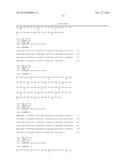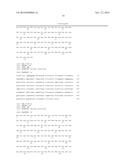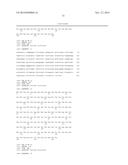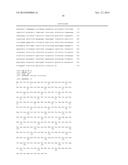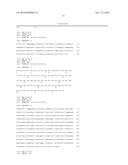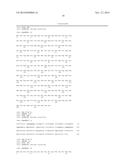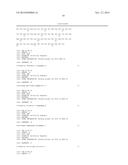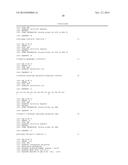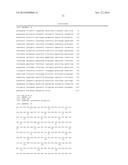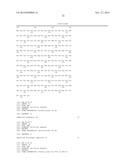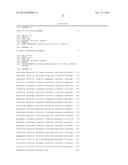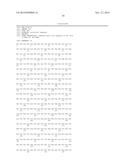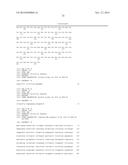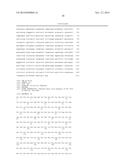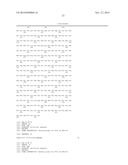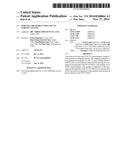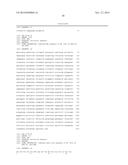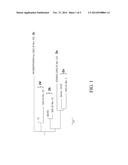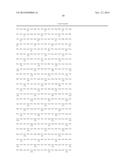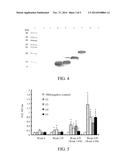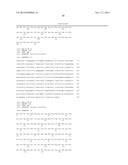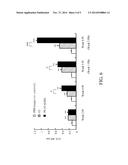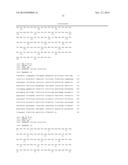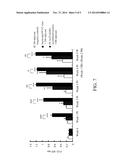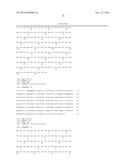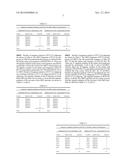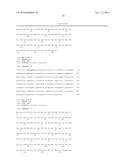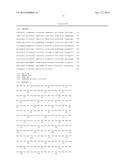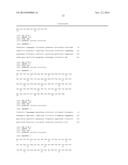Patent application title: PORCINE CIRCOVIRUS TYPE-2 (PCV2) SUBUNIT VACCINE
Inventors:
Tsun-Yung Kuo (I-Lan, TW)
Hsu Chung Gabriel Chen (Taipei, TW)
Shu-Hsiang Yang (New Taipei City, TW)
Yu-San Chen (Taichung City, TW)
IPC8 Class: AC07K14005FI
USPC Class:
4241861
Class name: Antigen, epitope, or other immunospecific immunoeffector (e.g., immunospecific vaccine, immunospecific stimulator of cell-mediated immunity, immunospecific tolerogen, immunospecific immunosuppressor, etc.) amino acid sequence disclosed in whole or in part; or conjugate, complex, or fusion protein or fusion polypeptide including the same disclosed amino acid sequence derived from virus
Publication date: 2014-11-27
Patent application number: 20140348864
Abstract:
A procine circovirus type-2 (PCV2) immunogenic composition includes an
antigenic peptide. The antigenic peptide is a non-arginine-rich peptide
of a PCV2 open reading frame 2 (ORF2) and/or a recombinant fusion protein
having the non-arginine-rich peptide of the PCV2 ORF2, a PE peptide, and
a KDEL signal peptide. The number of arginines of the non-arginine-rich
peptide of the PCV2 ORF2 is not greater than half of the number of
arginines of the arginine-rich domain of the N terminal of the PCV2 ORF2.Claims:
1. A porcine circovirus type 2 (PCV2) immunogenic composition, comprising
an antigenic peptide selected from at least one of: (a) a
non-arginine-rich peptide of a PCV2 open reading frame 2 (ORF2), wherein
the number of arginines of the non-arginine-rich peptide of the PCV2 ORF2
is not greater than half of the number of arginines of an arginine-rich
domain of the PCV2 ORF2 at the N terminus of a full length peptide of the
PCV2 ORF2; and (b) a recombinant fusion protein comprising, from the
amino-terminus to the carboxyl-terminus of the recombinant fusion
protein: a PE peptide having the sequence of SEQ ID NO: 35; the
non-arginine-rich peptide of the PCV2 ORF2 of (a); and a KDEL signal
peptide having the sequence of SEQ ID NO: 31.
2. The PCV2 immunogenic composition of claim 1, wherein the full length peptide of the PCV2 ORF2 is selected from the group consisting of SEQ ID NO: 2, SEQ ID NO: 16, SEQ ID NO: 20, SEQ ID NO: 51, and SEQ ID NO: 53.
3. The PCV2 immunogenic composition of claim 1, wherein the full length peptide of the PCV2 ORF2 has at least 80% homology to a sequence selected from the group consisting of SEQ ID NO: 2, SEQ ID NO: 16, SEQ ID NO: 20, SEQ ID NO: 51, and SEQ ID NO: 53.
4. The PCV2 immunogenic composition of claim 1, wherein the arginine-rich domain of the PCV2 ORF2 comprises amino acid residues 1-78 at the N terminus of the full-length peptide of the PCV2 ORF2.
5. The PCV2 immunogenic composition of claim 1, further comprising open reading frames (ORFs) other than ORF 2 of the PCV2, wherein the ORFs other than ORF2 comprise ORF1 and ORF3.
6. The PCV2 immunogenic composition of claim 1, further comprising at least one pathogen antigen selected from the group consisting of an antigen of swine influenza virus (SIV), an antigen of porcine reproductive and respiratory syndrome virus (PRRSV), an antigen of mycoplasma, antigen of porcine parvovirus (PPV), an antigen of erysipelas, and an antigen of pseudorabies virus.
7. The PCV2 immunogenic composition of claim 1, wherein the non-arginine-rich peptide of the PCV2 ORF2 of (a) is selected from the group consisting of SEQ ID NO: 6, SEQ ID NO: 8, SEQ ID NO: 10, SEQ ID NO: 12, SEQ ID NO: 18, SEQ ID NO: 22, SEQ ID NO: 55, and SEQ ID NO: 57.
8. The immunogenic composition of claim 1, further comprising at least one agent selected from the group consisting of vehicles, solvent, emulsifier, suspending agents, decomposer, binding agents, excipient, stabilizing agents, chelating agents, diluent, gelling agents, preservatives, lubricant, surfactant, adjuvant, and biological carriers.
9. A porcine circovirus type 2 (PCV2) immunogenic composition, comprising an antigenic peptide selected from at least one of: (a) an F2 peptide of a PCV2 open reading frame 2 (ORF2), wherein the F2 peptide of the PCV2 ORF2 comprises amino acid residues 79-156 at the N terminus of a full-length peptide of the PCV2 ORF2; and (b) a recombinant fusion protein comprising, from the amino-terminus to the carboxyl-terminus of the recombinant fusion protein: a PE peptide having the sequence of SEQ ID NO: 35; the F2 peptide of the PCV2 ORF2 of (a); and a KDEL signal peptide having the sequence of SEQ ID NO: 31.
10. The PCV2 immunogenic composition of claim 9, wherein the F2 peptide of the PCV2 ORF2 has an amino acid sequence selected from the group consisting of SEQ ID NO: 6, SEQ ID NO: 18, SEQ ID NO: 22, SEQ ID NO: 55, and SEQ ID NO: 57.
11. The PCV2 immunogenic composition of claim 9, wherein the F2 peptide of the PCV2 ORF2 has at least 80% homology to a sequence selected from the group consisting of SEQ ID NO: 6, SEQ ID NO: 18, SEQ ID NO: 22, SEQ ID NO: 55, and SEQ ID NO: 57.
12. The PCV2 immunogenic composition of claim 9, wherein the recombinant fusion protein of (b) comprises at least one sequence selected from the group consisting of SEQ ID NO: 41, SEQ ID NO: 45, and SEQ ID NO: 49.
13. A method for manufacturing an antigen fragment of PCV2, comprising: removing a DNA sequence encoding an arginine-rich domain of a PCV2 open reading frame 2 (ORF2) at the N terminus of a full length peptide of the PCV2 ORF2 from a full-length DNA sequence of the PCV2 ORF2 to obtain a DNA sequence encoding a non-arginine-rich domain of the PCV2 ORF2, wherein the number of arginines of the non-arginine-rich domain of the PCV2 ORF2 is not greater than half of the number of arginines of the arginine-rich domain of the PCV2 ORF2 at the N terminus of the full-length peptide of the PCV2 ORF2; and placing the DNA sequence encoding the non-arginine-rich domain of the PCV2 ORF2 in a biological expression system, and expressing the DNA sequence encoding the non-arginine-rich domain of the PCV2 ORF2 to obtain an antigen fragment of PCV2 immunogenic composition.
14. The method of claim 13, wherein a full-length DNA sequence of the PCV2 ORF2 comprises at least one sequence selected from the group consisting of SEQ ID NO: 1, SEQ ID NO: 15, SEQ ID NO: 19, SEQ ID NO: 50, and SEQ ID NO: 52.
15. The method of claim 13, wherein the DNA sequence encoding the arginine-rich domain of the PCV2 ORF2 at the N terminus of the full-length peptide of the PCV2 ORF2 comprises nucleotides 1-234 at the 5' end of the full-length DNA sequence of the PCV2 ORF2.
16. The method of claim 13, wherein the DNA sequence encoding the non-arginine-rich domain of the PCV2 ORF2 comprises nucleotides from nucleotide 235 at the 5' end to a stop codon at the 3' end of the full-length DNA sequence of the PCV2 ORF2.
17. The method of claim 13, wherein the DNA sequence encoding the non-arginine-rich domain of the PCV2 ORF2 comprises a sequence selected from the group consisting of SEQ ID NO: 5, SEQ ID NO: 7, SEQ ID NO: 9, SEQ ID NO: 11, SEQ ID NO: 17, SEQ ID NO: 21, SEQ ID NO: 54, and SEQ ID NO: 56.
Description:
BACKGROUND OF THE INVENTION
[0001] 1. Field of the Invention
[0002] The invention is related to a porcine circovirus type 2 (PCV2) subunit vaccine, particularly to a PCV2 subunit vaccine having a peptide of PCV2 open reading frame (ORF2) that can be abundantly expressed as an antigen and an additionally proper carrier or adjuvant.
[0003] 2. Description of the Prior Art
[0004] It is known that porcine circovirus type 2 (PCV2) is related to postweaning multisystemic wasting syndrome (PMWS) and porcine dermatitis and nephropathy syndrome (PDNS). PMWS was first found in pigs in Canada in 1991 and has been reported subsequently around the world. The syndrome has caused a huge loss in swine production industry worldwide. Main symptoms of PMWS include progressive weight loss, tachypnea, dyspnea, jaundice, et cetera. Visibly pathological changes in tissue include lymphocytic and granulomatous infiltrate, lymphadenopathy, lymphocytic and granulomatous hepatitis, and nephritis.
[0005] Porcine circovirus (PCV) was first recognized in a pig kidney cell line (PK-15, ATCC CCL33) in 1982. Although the porcine circovirus can continuously contaminate PK-15 cells, the virus does not cause cytopathic effect (CPE) in the contaminated PK-15 cells. Even though the porcine circovirus can infect pigs, it does not cause lesions in the infected pigs. The virus is named porcine circovirus type 1 (PCV1). PCV1 is an icosahedron, single-stranded DNA virus with a circular genome of 1,759 bp. The PK-15-derived PCV was classified in the Circoviridae family in 1995.
[0006] The PK-15-derived PCV1 is considered apathogenic. In contrast, the virus mutation isolated from pigs with PMWS in 1997 is pathogenic and is named porcine circovirus type 2 (PCV2). Postweaning Multisystemic Wasting Syndrome (PMWS) is a highly contagious pig disease. It mainly infects pregnant sows and their piglets and seriously affects health of pigs.
[0007] PCV2 is a single-stranded, circular DNA virus with a diameter of 17 nm, and its genome size is 1.76 kb. Genomic analysis with software shows a total of 11 open reading frames (ORFs) transcribed in the clockwise and counterclockwise directions. Among the 11 ORFs, ORF1 and ORF2 are probably the most important genes. ORF1 gene encodes Rep and Rep' proteins, which are related to virus replication. It is known that ORF2 gene encodes immunogenic structure capsid protein of PCV2, which is used to induce immune response in organisms.
[0008] Inactivated PCV2 vaccine is the most common commercially available PCV2 vaccine. However, developing inactivated vaccine requires cell lines to be free of contaminant, and the possibility of incomplete inactivation of the virus by chemicals is the most significant disadvantage of inactivated vaccine. Another disadvantage is that the antigenic structures of the virus may be altered by chemical treatment, leading to failure to induce sufficient immune response to eliminate the virus and failure to protect pigs from infection of the disease. Therefore, developing inactivated vaccine can be difficult and costly, and vaccine safety may be a concern.
[0009] Unlike inactivated vaccine, in which the whole virus is the vaccine antigen, subunit vaccine uses a part of proteins from the pathogen as antigen protein, and the antigen protein is inoculated into animals or humans to induce immunity. Subunit vaccine can be prepared by cloning genes encoding antigen proteins from pathogens and then producing large amounts of the antigen proteins by genetic engineering. Safety is the most significant advantage of subunit vaccine because it uses parts of a pathogen, instead of a whole pathogen, to inoculate pigs without the issue of incomplete inactivation. Conventional PCV2 subunit vaccine uses PCV2 ORF2 protein as the antigen protein; however, the protein expression level of full-length PCV2 ORF2 protein in prokaryotic expression systems is quite low and does not meet the requirements of vaccine production. Therefore, developing antigen fragments of PCV2 ORF2 that can be highly expressed in biological expression systems is helpful to commercial application of PCV2 subunit vaccine.
SUMMARY OF THE INVENTION
[0010] The disclosure provides DNA sequences encoding protein fragments of PCV2 ORF2, and the protein fragments of PCV2 ORF2 can be highly expressed in biological expression systems.
[0011] The disclosure also provides PCV2 subunit vaccine in which protein fragments of PCV2 ORF2 that can be highly expressed in biological expression systems are used as antigen proteins to be inoculated into animals to induce sufficient immunity against PCV2 infection in the animals.
[0012] The disclosure further provides subunit vaccine developed by genetic engineering to produce low-cost, high-purity, and good safety PCV2 subunit vaccine with simple production process.
[0013] Due to the fact that protein expression level of full-length PCV2 ORF2 protein in biological expression systems is quite low, genetic engineering was used to achieve the objects above. DNA sequences (such as SEQ ID NO: 1) that encode full-length PCV2 ORF2 proteins were cut into fragments of different sizes, and the DNA fragments were inserted into expression vectors and then expressed in hosts. The levels of the expressed proteins were evaluated to determine which DNA fragments can produce high levels of proteins in protein expression systems.
[0014] Results of protein sequence analysis and protein expression tests show that there are about 30 arginines in a full-length PCV2 ORF2 protein, in which at least two thirds of the arginines locate at the N terminus of the PCV2 ORF2 protein. The more arginines at the N terminus being deleted, the higher level the ORF2 protein fragment being expressed. Further, after the first 234 nucleotides at the 5' end of a full-length DNA sequence of PCV2 ORF2 is deleted, the protein fragment encoded by the remaining DNA fragment (i.e. from nucleotide 235 at the 5' end to a stop codon) can be highly expressed.
[0015] Therefore, the PCV2 subunit vaccine provided in the disclosure comprises an antigenic peptide of PCV2 with proper carrier or adjuvant. The antigenic peptide can be highly expressed in expression systems and is a non-arginine-rich peptide of the PCV2 ORF2. The number of arginines of the non-arginine-rich peptide of the PCV2 ORF2 are not more than half (1/2) of the number of arginines of an arginine-rich domain at the N terminus of the full-length PCV2 ORF2. In an embodiment, when the number of arginines of the arginine-rich domain at the N terminus of a full-length PCV2 ORF2 is 20, the number of arginines of the non-arginine-rich peptide of the PCV2 ORF2 is one of the integers between 0 and 10. In another embodiment, when the number of arginines of the arginine-rich domain at the N terminus of a full-length PCV2 ORF2 is 21, the number of arginines of the non-arginine-rich peptide of the PCV2 ORF2 is one of the integers between 0 and 10. In yet another embodiment, when the number of arginines of the arginine-rich domain at the N terminus of a full-length PCV2 ORF2 is 22, the number of arginines of the non-arginine-rich peptide of the PCV2 ORF2 is one of the integers between 0 and 11.
[0016] In an embodiment, the arginine-rich domain has residues 1-78 at the N terminus of a full-length PCV2 ORF2 (which are encoded by nucleotides 1-234 at the 5' end of a full-length DNA sequence of the PCV2 ORF2). In an embodiment, the non-arginine-rich peptide has the peptide sequence from residue 79 to the last amino acid residue at the C terminus of a full-length PCV2 ORF2 (which is encoded by the DNA sequence from nucleotide 235 at the 5' end to a stop codon at the 3' end of a full-length DNA sequence of the PCV2 ORF2).
[0017] The PCV2 ORF2 disclosed herein has a full-length peptide sequence having at least 80%, preferably 85%, more preferably 90%, even more preferably 91%, 92%, 93%, 94%, 95%, 96%, 97%, 98%, or 99% homology to one of SEQ ID NO: 2, SEQ ID NO: 16, SEQ ID NO: 20, SEQ ID NO: 51, and SEQ ID NO: 53. In a preferable embodiment, the PCV2 ORF2 disclosed herein has a full-length peptide sequence of one of SEQ ID NO: 2, SEQ ID NO: 16, SEQ ID NO: 20, SEQ ID NO: 51, and SEQ ID NO: 53.
[0018] In addition, the disclosure provides a PCV2 ORF2 fusion protein as an antigenic peptide by using the functions of the receptor binding domain I and the transmembrane targeting domain II of Pseudomonas aeruginosa exotoxin A (i.e. the "PE protein") and an endoplasmic reticulum (ER) retention signal (i.e. the "KDEL signal peptide").
[0019] The PE protein of Pseudomonas aeruginosa can be used as a guide of a target protein to its target location by the following procedure. First, the receptor binding domain of Pseudomonas aeruginosa exotoxin A is responsible for binding to receptors on the membrane of the target cells (CD8+ T cells), and then the ligand-receptor complexes enter the endosomes of the target cells through endocytosis. After enzymatic cleavage by a protease in the endosomes, truncated protein fragments (containing the transmembrane targeting domain and the linked target protein) are delivered into the Golgi bodies and the endoplasmic reticulum (ER) and further translocated into the cytoplasm of the target cells by the transmembrane targeting domain.
[0020] Furthermore, when a KDEL signal peptide is linked at the C terminus of a target protein, the target protein will be transported to the ER by the KDEL signal peptide and then interact in the ER.
[0021] Therefore, the disclosure provides a PCV2 ORF2 fusion protein as an antigenic peptide by using the functions of the PE protein and the KDEL signal peptide. PE protein and KDEL signal peptide were fused with a PCV2 ORF2 protein fragment at the N and C terminuses, respectively, to produce the fusion protein (PE-ORF2 fragment-KDEL) to be inoculated into animals to induce sufficient immunity against PCV2 infection in the animals.
[0022] In some embodiments, the antigenic peptides used herein include, but not limited to, PCV2 ORF2 fragments. The ORF2 fragments have a peptide sequence having at least 80%, preferably 85%, more preferably 90%, even more preferably 91%, 92%, 93%, 94%, 95%, 96%, 97%, 98%, or 99% homology to one of SEQ ID NO: 6, SEQ ID NO: 8, SEQ ID NO: 10, SEQ ID NO: 12, SEQ ID NO: 18, SEQ ID NO: 22, SEQ ID NO: 55, and SEQ ID NO: 57. In a preferable embodiment, the PCV2 ORF2 fragments has a peptide sequence of one of SEQ ID NO: 6, SEQ ID NO: 8, SEQ ID NO: 10, SEQ ID NO: 12, SEQ ID NO: 18, SEQ ID NO: 22, SEQ ID NO: 55, and SEQ ID NO: 57, and were obtained by genetic engineering. DNA sequences (SEQ ID NOs: 5, 7, 9, 11, 17, 21, 54, 56) encoding the PCV2 ORF2 fragments were cloned into expression vectors to form plasmids containing a DNA fragment encoding an antigenic peptide. The plasmids were then transformed into host cells to express the antigenic peptides.
[0023] The fusion proteins (PE-ORF2 fragment-KDEL) disclosed herein were obtained by genetic engineering. DNA sequences (SEQ ID NOs: 5, 7, 9, 11, 17, 21, 54, 56) encoding the PCV2 ORF2 fragments, DNA sequence (SEQ ID NO: 34) encoding the PE protein, and the DNA sequence (SEQ ID NO: 30) encoding the KDEL signal peptide were cloned into expression vectors to form plasmids containing a DNA fragment encoding a fusion protein. The plasmids were then transformed into host cells to express the fusion protein.
[0024] The expression vectors include but not limited to pET vectors and pGEX vectors. In an embodiment, the expression vector is pET24a. The expression systems (host cells) include but not limited to prokaryotic expression systems (such as Escherichia coli (E. coli.)), eukaryotic expression systems (such as animal cells (for example, CHO cell) and plant cells). In an embodiment, the expression system is E. coli.
[0025] The adjuvant includes, but not limited to, aqueous adjuvant (such as aluminum hydroxide), potassium alum, Freund's Incomplete Adjuvant, oil adjuvant, water-soluble adjuvant, or water-in-oil-in-water (W/O/W) emulsion adjuvant. In an embodiment, the adjuvant is oil adjuvant.
[0026] The immunogenic composition disclosed herein further comprises antigenic peptides of other PCV2 ORFs. The other PCV2 ORFs include, but not limited to, ORF1 and ORF3. In addition, the immunogenic composition disclosed herein further comprises a pathogen antigen. The pathogen antigen is selected from the group consisting of antigen of Swine influenza virus (SIV), antigen of porcine reproductive and respiratory syndrome virus (PRRSV), antigen of mycoplasma, antigen of porcine parvovirus (PPV), antigen of erysipelas, and antigen of pseudorabies (Aujeszky's disease) virus.
[0027] In addition, the immunogenic composition disclosed herein further comprises one or more than one of the followings: vehicles, solvent, emulsifier, suspending agent, decomposer, binding agent, excipient, stabilizing agent, chelating agent, diluent, gelling agent, preservative, lubricant, surfactant, adjuvant, and biological carriers.
[0028] The meaning of the technical and scientific terms as described herein can be clearly understood by a person of ordinary skill in the art.
[0029] The present invention is described in more detail in the following illustrative examples. Although the examples may represent only selected embodiments of the invention, it should be understood that the following examples are illustrative and not limiting.
BRIEF DESCRIPTION OF THE DRAWINGS
[0030] FIG. 1 provides phylogenetic analysis of PCV2 genome sequences.
[0031] FIG. 2 illustrates a schematic diagram of the PCV2 ORF2 fragments, in which pF1, pF2, pF3, pF4, pR1, pR2, and pR3 are PCR primers.
[0032] FIG. 3 shows the results of SDS-PAGE analysis of recombinant proteins of different PCV2 2a-ORF2 fragments expressed in E. coli. Total proteins of E. coli were collected at 6 hours after IPTG induction and then resolved by a 15% SDS-PAGE, in which lanes 1-9 show molecular weight ladders, empty pET24a vector (as negative control), PCV2 ORF2 2a-F1 fragment (12.7 KDa), PCV2 ORF2 2a-F2 fragment (11.6 KDa), PCV2 ORF2 2a-F3 fragment (12.1 KDa), PCV2 ORF2 2a-F4 fragment (16.5 KDa), PCV2 ORF2 2a-F5 fragment (21.4 KDa), PCV2 ORF2 2a-F6 fragment (20.8 KDa), and full-length PCV2 2a-ORF2 (27.5 KDa), respectively.
[0033] FIG. 4 provides the results of western bolt of recombinant proteins of different PCV2 2a-ORF2 fragments. Lanes 1-9 show molecular weight ladders, empty pET24a vector (as negative control), PCV2 ORF2 2a-F1 fragment (12.7 KDa), PCV2 ORF2 2a-F2 fragment (11.6 KDa), PCV2 ORF2 2a-F3 fragment (12.1 KDa), PCV2 ORF2 2a-F4 fragment (16.5 KDa), PCV2 ORF2 2a-F5 fragment (21.4 KDa), PCV2 ORF2 2a-F6 fragment (20.8 KDa), and full-length PCV2 2a-ORF2 (27.5 KDa), respectively.
[0034] FIG. 5 provides the results of PCV2 ELISA of serum samples collected at different time points from rats vaccinated with recombinant proteins of different PCV2 2a-ORF2 fragments, respectively. *, p<0.05. (PI: post-immunization; PB: post-booster)
[0035] FIG. 6 illustrates the results of PCV2 ELISA of serum samples collected at different time points from mice vaccinated with recombinant proteins of the 2a-F2 fragment and recombinant proteins of the PE-2a-F2-KDEL fragment, respectively. *, p<0.05; **, p<0.01; ***, p<0.001; #, p<0.05; ##, p<0.01; ###, p<0.001. (PI: post-immunization; PB: post-booster)
[0036] FIG. 7 shows the results of PCV2 ELISA of serum samples collected at different time points from mice vaccinated with recombinant proteins of the PE-2a-F2-KDEL fragment and PCV2 whole virus vaccine, respectively. *, p<0.05; **, p<0.01; ***, p<0.001; #, p<0.05; ##, p<0.01; ###, p<0.001. (PI: post-immunization; PB: post-booster)
DETAILED DESCRIPTION OF THE PREFERRED EMBODIMENT
Example 1
Construction and Determination of Antigenic Peptides of PCV2 Subunit Vaccine
[0037] Due to the fact that protein expression level of full-length PCV2 ORF2 protein in biological expression systems is quite low, DNA sequences that encode full-length PCV2 ORF2 proteins are cut into fragments of different sizes, and the DNA fragments are inserted into expression vectors and then expressed in hosts. The levels of the expressed proteins are evaluated to determine which DNA fragments can produce high levels of proteins in protein expression systems.
[0038] A commonly used prokaryotic expression system (Escherichia coli) is used in the following examples for analysis and illustration.
1. Amplification of PCV2 ORF2 Gene Fragments of Different Sizes
[0039] The full-length PCV2 ORF2 gene used in this example has a sequence of SEQ ID NO: 1. PCV2 ORF2 gene sequences provided by Wang et al. (Wang et al., Virus Research 2009, Genetic variation analysis of Chinese strains of porcine circovirus type 2.) are used as standard sequences for phylogenetic analysis of SEQ ID NO: 1. The result shows that the PCV2 ORF2 sequence (SEQ ID NO: 1) belongs to PCV2 2a subgroup (as shown in FIG. 1). Primers (as shown in Table 1) were designed to amplify different sizes of fragments of the PCV2 2a ORF2 gene (2a-ORF2) by polymerase chain reaction (PCR).
[0040] As shown in FIG. 2, the full-length 2a-ORF2 gene was amplified with specific primers pF1 (forward primer) and pR1 (reverse primer) by PCR. The full-length 2a-ORF2 gene (2a-ORF2) has the DNA sequence of SEQ ID NO: 1, and the different sizes of fragments of the PCV2 2a-ORF2 are named 2a-F1, 2a-F2, 2a-F3, 2a-F4, 2a-F5, and 2a-F6, respectively. The 2a-F1 fragment has the DNA sequence of SEQ ID NO: 3, which is nucleotides 1-234 at the 5' end of 2a-ORF2. The 2a-F2 fragment has the DNA sequence of SEQ ID NO: 5, which is nucleotides 235-468 at the 5' end of 2a-ORF2. The 2a-F3 fragment has the DNA sequence of SEQ ID NO: 7, which is nucleotides 469-699 at the 5' end of 2a-ORF2. The 2a-F4 fragment has the DNA sequence of SEQ ID NO: 9, which is nucleotides 349-699 at the 5' end of 2a-ORF2. The 2a-F5 fragment has the DNA sequence of SEQ ID NO: 11, which is nucleotides 235-699 at the 5' end of 2a-ORF2. The 2a-F6 fragment has the DNA sequence of SEQ ID NO: 13, which is nucleotides 1-468 at the 5' end of 2a-ORF2. All forward primers contain a Hind III restriction site, and all reverse primers contain an Xho I restriction site.
TABLE-US-00001 TABLE 1 Sequence listing of primers for amplication of different sizes of fragments of PCV2 ORF2 gene Frag- ment Primer SequenceNote ORF2 pF1 Forward CCCAAGCTTGCATGACGT SEQ ID primer ATCCAAGGAGGCG NO: 23 pR1 Reverse CCG GGGTTT SEQ ID primer AAGTGGGGGGTCTTTA NO: 24 F1 pF1 Forward CCCAAGCTTGCATGACGT SEQ ID primer ATCCAAGGAGGCG NO: 23 pR3 Reverse CCG GTCGTT SEQ ID primer AATATTAAATCTCATC NO: 28 F2 pF2 Forward CCCAAGCTTGCTTTGTTC SEQ ID primer CCCCGGGAGGGGG NO: 25 pR2 Reverse CCG GTAGGA SEQ ID primer GAAGGGTTGGGGGATT NO: 26 F3 pF3 Forward CCCAAGCTTGCCACTCCC SEQ ID primer GGTACTTTACCCC NO: 27 pR1 Reverse CCG GGGTTT SEQ ID primer AAGTGGGGGGTCTTTA NO: 24 F4 pF4 Forward CCCAAGCTTGCGGAGTGG SEQ ID primer GCTCCACTGCTGT NO: 29 pR1 Reverse CCG GGGTTT SEQ ID primer AAGTGGGGGGTCTTTA NO: 24 F5 pF2 Forward CCCAAGCTTGCTTTGTTC SEQ ID primer CCCCGGGAGGGGG NO: 25 pR1 Reverse CCG GGGTTT SEQ ID primer AAGTGGGGGGTCTTTA NO: 24 F6 pF1 Forward CCCAAGCTTGCATGACGT SEQ ID primer ATCCAAGGAGGCG NO: 23 pR2 Reverse CCG GTAGGA SEQ ID primer GAAGGGTTGGGGGATT NO: 26 Note: Sequences marked with "____" underneath are the sequences of Hind III restriction site (AAGCTT), and sequences marked with " " underneath are the sequences of Xho I restriction site (CTCGAG).
[0041] Conditions for PCR reaction comprises: 95° C. for 5 minutes, 25 cycles of 95° C. for 30 seconds, 55° C. for 30 seconds, and 72° C. for 30 seconds, and 72° C. for 5 minutes for elongation. Sizes of the PCR products 2a-ORF2, 2a-F1, 2a-F2, 2a-F3, 2a-F4, 2a-F5, and 2a-F6 are 699 bp, 234 bp, 234 bp, 231 bp, 351 bp, 465 bp, and 468 bp, respectively, and confirmed by 2% agarose electrophoresis. After confirmation, the PCR products were purified with PCR-M purification kit (Viogene).
2. Construction of pET24a Plasmids Containing Different Sizes of Fragments of PCV2 ORF2
[0042] One (1) μg of the purified PCR products and 1 μg of pET24a expression vector (Novagen) were digested with two restriction enzymes (New England Biolabs), 1 μl of Hind III and 1 μl of Xho I, respectively, for 8 hours at 37° C. After restriction enzyme cleavage reaction, the digested PCR products and pET24a expression vector were purified with PCR-M Clean up System (Viogene) respectively. The purified PCR products were ligated with the purified pET24a expression vector to form plasmids pET24a-2a-F1, pET24a-2a-F2, pET24a-2a-F3, pET24a-2a-F4, pET24a-2a-F5, pET24a-2a-F6, and pET24a-2a-ORF2, and then the plasmids were transformed into host cells (E. coli). Transformants containing the PCR products were selected, and DNA sequences were confirmed by DNA sequencing. Bacteria containing the plasmids above were then obtained.
3. Protein Expression and Confirmation of Different Sizes of Fragments of PCV2 ORF2
[0043] Bacteria containing the plasmids above were incubated in 2 ml of LB medium at 37° C. for 16-18 hours and then inoculated at a ratio of 1:50 in LB medium containing 25 μg/ml kanamycin to be further incubated in a 37° C., 200 rpm incubator until the O.D. 600 nm is 0.6. After that, β-D-thiogalactoside (IPTG) was added to a final concentration of 1 mM, and the E. coli host cells were incubated in a 37° C., 200 rpm incubator for 6 more hours. Then, 1 ml of the E. coli host cells was centrifuged at 10,000×g, and the pellet was treated with B-PE® Bacterial Protein Extraction (purchased from PIERCE) to check whether the recombinant proteins are soluble proteins or in inclusion bodies by the following steps. The pellet was added in 40 μl of reagent, mixed with a vortex shaker for 1 minute, and centrifuged at 10,000×g to separate soluble proteins (upper part) from insoluble inclusion bodies (lower part). The soluble proteins were dissolved in 1×SDS-PAGE sample buffer, and the pellet was added in 2×SDS-PAGE sample buffer. The samples were placed in a heat block at 100° C. for 20 minutes and then centrifuged. The supernatant was analyzed by 15% SDS-PAGE to measure the expression of the recombinant proteins.
[0044] The recombinant proteins were produced by inducing bacterial culture with IPTG. The 2a-ORF2 recombinant protein has the amino acid sequence of SEQ ID NO: 2. The 2a-F1 recombinant protein has the amino acid sequence of SEQ ID NO: 4. The 2a-F2 recombinant protein has the amino acid sequence of SEQ ID NO: 6. The 2a-F3 recombinant protein has the amino acid sequence of SEQ ID NO: 8. The 2a-F4 recombinant protein has the amino acid sequence of SEQ ID NO: 10. The 2a-F5 recombinant protein has the amino acid sequence of SEQ ID NO: 12. The 2a-F6 recombinant protein has the amino acid sequence of SEQ ID NO: 14.
[0045] Expression of the recombinant proteins was analyzed by SDS-PAGE, and the results are shown in FIG. 3, where lane 1 shows molecular weight ladders, lane 2 shows the negative control (empty pET24a vector), lane 3 shows the 2a-F1 recombinant protein (12.7 KDa), lane 4 shows the 2a-F2 recombinant protein (11.6 KDa), lane 5 shows the 2a-F3 recombinant protein (12.1 KDa), lane 6 shows the 2a-F4 recombinant protein (16.5 KDa), lane 7 shows the 2a-F5 recombinant protein (21.4 KDa), lane 8 shows the 2a-F6 recombinant protein (20.8 KDa), and lane 9 shows full-length 2a-ORF2 recombinant protein (27.5 KDa). Among the 6 fragments of 2a-ORF2, fragments 2a-F2, 2a-F3, 2a-F4, and 2a-F5 were expressed in large quantities (FIG. 3, lanes 4-7). The estimated sizes of fragments 2a-F2, 2a-F3, 2a-F4, and 2a-F5 proteins match their actual sizes of 11.6 kDa, 12.1 kDa, 16.5 kDa, and 21.4 kDa, respectively.
[0046] Next, western blotting was deployed to check whether the expressed recombinant proteins are PCV2 2a-ORF2 fragments. Following electrophoresis, the SDS-PAGE was transferred onto a PVDF Nylon membrane. The resulting membrane was blocked with blocking buffer, which is TBST (10 mM Tris-HCl, pH 8.0, 150 mM NaCl, 0.1% Tween 20) containing 5% skim milk, for 1 h at room temperature to prevent non-specific binding of proteins. After that, the proteins were identified using alkaline phosphatase (AP)-conjugated mouse anti-6×his monoclonal antibodies against the 6×his-tag fusion proteins for 1 hour at room temperature, followed by 6 times of wash with TBST, 5 minutes for each. After wash, NBT/BCIP substrate (Bio-Rad) was added. After 10 minutes, the reaction was stopped by adding water.
[0047] The results of western blot are shown in FIG. 4, where lane 1 shows molecular weight ladders, lane 2 shows the negative control (empty pET24a vector), lane 3 shows the 2a-F1 recombinant protein (12.7 KDa), lane 4 shows the 2a-F2 recombinant protein (11.6 KDa), lane 5 shows the 2a-F3 recombinant protein (12.1 KDa), lane 6 shows the 2a-F4 recombinant protein (16.5 KDa), lane 7 shows the 2a-F5 recombinant protein (21.4 KDa), lane 8 shows the 2a-F6 recombinant protein (20.8 KDa), and lane 9 shows full-length 2a-ORF2 recombinant protein (27.5 KDa). The results of western blot match the results of SDS-PAGE analysis (as shown in FIG. 3). The full-length 2a-ORF2 recombinant protein cannot be expressed (FIG. 4, lane 9). Among the 6 fragments of 2a-ORF2, fragments 2a-F2, 2a-F3, 2a-F4, and 2a-F5 are expressed in large quantities (FIG. 4, lanes 4-7). The estimated sizes of fragments 2a-F2, 2a-F3, 2a-F4, and 2a-F5 proteins match their actual sizes of 11.6 kDa, 12.1 kDa, 16.5 kDa, and 21.4 kDa, respectively. However, there is no expression of the 2a-F1 recombinant protein or the 2a-F6 recombinant protein (FIG. 4, lanes 3 and 8). Since both of the 2a-F1 recombinant protein and the 2a-F6 recombinant protein contain nucleotides 1-234 at the 5' end of the full-length DNA sequence of the PCV2 2a-ORF2 (see FIG. 2), some sequences in the nucleotides 1-234 may affect expression of PCV2 ORF2 protein. Analysis of amino acid sequences of the 2a-F1 fragment (nucleotides 1-234 at the 5' end of PCV2 2a-ORF2, SEQ ID NO: 3) and the 2a-F2+2a-F3 fragment (nucleotides 235-699 (without the stop codon) at the 5' end of PCV2 2a-ORF2, SEQ ID NO: 11) shows that the arginine numbers of the amino acid sequence (SEQ ID NO: 4) of the 2a-F1 fragment are two times or more than the arginine numbers of the amino acid sequence (SEQ ID NO: 12) of the 2a-F2+2a-F3 fragment (as shown in Table 2). Analysis of addition or deletion of the arginine shows that deletion of the excessive arginine can increase protein expression of PCV2 ORF2.
TABLE-US-00002 TABLE 2 Analysis of Arginine Numbers of the PCV2 2a-ORF2 Amino Acid Sequence 2a-F1 2a-F2 + 2a-F3 Codon Amino Acid Amount Codon Amino Acid Amount AGA Arginine 5 AGA Arginine 3 AGG Arginine 3 AGG Arginine 3 CGA Arginine 1 CGC Arginine 1 CGC Arginine 10 CGG Arginine 1 CGT Arginine 2 CGT Arginine 1 Total 21 Total 9
Example 2
Immunogenicity Analysis of Antigenic Peptides of PCV2 Subunit Vaccine
1. Immunization of Rats
[0048] PCV2 subunit vaccine was made with the 2a-F2, 2a-F3, 2a-F4, and 2a-F5 recombinant proteins prepared in Example 1, respectively, and Freund's complete adjuvant. Rats were vaccinated with the PCV2 subunit vaccine to analyze immunogenicity of the antigenic peptides of the PCV2 subunit vaccine.
[0049] Five- to six-week-old healthy specific-pathogen-free (SPF) rats were randomly divided into 5 groups of 3 rats each. Enzyme-linked immunosorbent assay (ELISA) showed that all the 15 rats were negative for anti-PCV2 antibodies. Each rat in the 4 vaccine groups (Groups 1 to 4) was injected subcutaneously with 200 μg of recombinant protein, and the total volume of each injection was 300 μL with 1:1 (v/v) ratio of protein to adjuvant formulation. Rats in Group 5 were injected with 300 μL PBS and served as negative control. Two weeks after primary immunization (p.i.), the rats in the 4 vaccine groups were boosted with the same dose of the 4 different recombinant proteins, respectively. Serum samples were collected at weeks 0, 2, 4, and 8 post-primary immunization. All the serum samples were tested by ELISA to measure the titer of anti-PCV2 antibodies.
2. Detection of Anti-PCV2 Antibodies by ELISA
[0050] Ninety-six well plates containing PCV2 pathogen antigen (300 ng/well) were used as the ELISA plates in this example. The ELISA plates were washed 3 times with 50 mmol/L PBS (pH 7.2) containing 500 μl/L Tween-20 (i.e. PBST) for 3 to 5 minutes each time. To block the ELISA plates, 2004 of 0.15% BSA blocking solution was added to each well of the ELISA plates, and then the ELISA plates were incubated for 2 hours at 37° C. After that, the ELISA plates were washed with PBS. Rat serum samples were diluted fifty-fold (1:50) with PBS and then diluted two-fold serially. Each sample had 8 repeats. Diluted serum samples were added to the wells of the ELISA plates (100 μl/well), and the plates were incubated for 1 hour at 37° C. After incubation, the plates were washed with PBS. Anti-rat IgG antibody conjugated with alkaline phosphatase (AP) was then added to the wells. After incubating for 1 hour at 37° C., the plates were washed with PBS. For visualization of results, para-Nitrophenylphosphate (pNPP) was added to the wells. Following incubation, the reaction was stopped by adding 1M NaOH. The optical density of each well was read using optical density at 405 nm. Each sample was analyzed in duplicate, and the O.D. values of duplicates were averaged.
[0051] ELISA results are shown in FIG. 5. All the 2a-F2, 2a-F3, 2a-F4, and 2a-F5 recombinant proteins prepared in Example 1 are able to induce serum antibodies against PCV2 in the tested animals. Among the recombinant proteins, 2a-F2 recombinant protein (SEQ ID NO: 6) induced the highest level of serum antibody against PCV2. For statistical analysis, all groups were compared with the PBS negative control at different sampling points, and there are significant differences between the negative control and each vaccination group (p<0.05).
[0052] Furthermore, pigs were vaccinated with the 2a-F2, 2a-F3, 2a-F4, and 2a-F5 recombinant proteins, respectively, and all the recombinant proteins were able to induce serum antibodies against PCV2 in pigs. In addition, the vaccinated pigs were challenged with PCV2 virus to evaluate the efficacy of the recombinant proteins. First, the recombinant proteins were formulated as subunit vaccine and injected into pigs. Then, the pigs were challenged with PCV2 virus. The results show that the protection rates of immunization groups are higher then that of the negative control (no vaccination). The protection rates used herein include a decrease in viremia and alleviation of PCV2 symptoms. Therefore, the results show that the PCV2 subunit vaccine prepared with the recombinant proteins can effectively induce immunity in animals and increase survival rate of the animals.
Example 3
Construction and Expression of Antigenic Peptides of PCV2 2a Subunit Vaccine
[0053] The results in Example 2 show that among the recombinant proteins, the F2 peptide of PCV2 ORF2 induces the highest level of serum antibody against PCV2. In order to enhance the immunogenicity of PCV2 subunit vaccine, receptor binding domain I and transmembrane targeting domain II of Pseudomonas aeruginosa exotoxin A (i.e. PE protein) and ER retention signal--KDEL signal peptide were fused with the 2a-F2 peptide prepared in Example 1 at the N and C terminuses, respectively, to produce a fusion protein (PE-2a-F2-KDEL) to induce sufficient immunity against PCV2 infection in animals.
[0054] The recombinant protein (PE-2a-F2-KDEL) was prepared by genetic engineering in this Example. DNA sequences encoding the proteins of interest were cloned into an expression vector to construct pET24a-PE-2a-F2-KDEL plasmid. The plasmid was induced to express PE-2a-F2-KDEL recombinant protein. First, DNA sequence (SEQ ID NO: 30) encoding KDEL signal peptide was cloned into pET24a vector to form pET24a-KDEL plasmid. After that, DNA sequence (SEQ ID NO: 5) of the 2a-F2 fragment obtained in Example 1 was cloned into pET24a-KDEL plasmid to form pET24a-2a-F2-KDEL plasmid. Finally, DNA sequence (SEQ ID NO: 34) encoding PE protein was cloned into pET24a-2a-F2-KDEL plasmid to form pET24a-PE-2a-F2-KDEL plasmid.
1. Construction of pET24a-KEDL
[0055] The DNA sequence encoding KDEL signal peptide (SEQ ID NO: 31) is shown as SEQ ID NO: 30. The DNA sequence was amplified by PCR. The sequences of KEDL specificity primers are shown as follows.
TABLE-US-00003 Forward primer (with a Hind III restriction site): (SEQ ID NO: 32) 5'-CCC CTCAAAAAAGACGAACTGAGAGATG AACTGAAAGA-3' Hind III Reverse primer (with a Xho I restriction site) (SEQ ID NO: 33) 5'-GTG CAGTTCGTCTTTCAGTTCATCT-3' Xho I
Conditions for PCR reaction comprises: 94° C. for 3 minutes, 5 cycles of 95° C. for 1 minute, 55° C. for 1 minute, and 72° C. for 20 seconds, and 72° C. for 1 minutes for elongation. PCR product and pET24a vector were subjected to double restriction enzymes digestion with Hind III and Xho I. Thereafter, the digested PCR products and pET24a vector were purified, respectively, followed by ligation to clone the PCR product into pET24a to form pET24a-KDEL. Then, the construct pET24a-KEDL was transformed into host cells (E. coli) to carry out mass replication. The replicate PCR products were further confirmed by sequencing. 2. Construction of pET24a-2a-F2-KDEL
[0056] The 2a-F2 DNA sequence (SEQ ID NO: 5) obtained in Example 1 was amplified by PCR. The PCR primers are shown as follows.
TABLE-US-00004 Forward primer pF2-1 (with a Sac I restriction site): (SEQ ID NO: 38) 5'-C TTTGTTCCCCCGGGAGGGGGG-3' Sac I Reverse primer pR2-1 (with a Hind III restriction site): (SEQ ID NO: 39) 5'-CCC GTAGGAGAAGGGTTGGGGGATT-3' Hind III
Conditions for PCR reaction comprises: 95° C. for 5 minutes, 25 cycles of 95° C. for 30 seconds, 55° C. for 30 seconds, and 72° C. for 30 seconds, and 72° C. for 5 minutes for elongation. PCR product and pET24a-KDEL plasmid were subjected to double restriction enzymes digestion with Sac I and Hind III. Thereafter, the digested PCR products and pET24a-KDEL plasmid were purified, respectively, followed by ligation to clone the PCR product into pET24a-KDEL to form pET24a-2a-F2-KDEL. Then, the construct was transformed into host cells (E. coli) to carry out mass replication. The replicate PCR products were further confirmed by sequencing. 3. Construction of pET24a-PE-2a-F2-KDEL
[0057] The DNA sequence encoding PE protein (SEQ ID NO: 35) is shown as SEQ ID NO: 34. The DNA sequence was amplified by PCR. The sequences of PE specificity primers are shown as follows.
TABLE-US-00005 Forward primer (with a BamH I restriction site): (SEQ ID NO: 36) 5'-CG GAAGAAGCGTTCGAC-3' BamH I Reverse primer (with a EcoRI and a Sac I restriction sites) (SEQ ID NO: 37) 5'-CGGAATTC GCAGGTCAGGCTCACCAC-3' EcoR I Sac I
Conditions for PCR reaction comprises: 94° C. for 5 minutes, 30 cycles of 95° C. for 1 minute, 55° C. for 1 minute, and 72° C. for 1.5 minutes, and 72° C. for 7 minutes for elongation. PCR product and pET24a-2a-F2-KDEL plasmid were subjected to double restriction enzymes digestion with BamH I and Sac I. Thereafter, the digested PCR products and pET24a-2a-F2-KDEL plasmid were purified, respectively, followed by ligation to clone the PCR product into pET24a-2a-F2-KDEL to form pET24a-PE-2a-F2-KDEL. Then, the construct pET24a-PE-2a-F2-KDEL was transformed into host cells (E. coli) to carry out mass replication. The replicate PCR products were further confirmed by sequencing. The antigenic fusion protein PE-2a-F2-KDEL has amino acid sequence of SEQ ID NO: 41, and the DNA sequence encoding the fusion protein is SEQ ID NO: 40. 4. PE-2a-F2-KDEL Protein Expression
[0058] E. coli containing pET24a-PE-2a-F2-KEDL plasmid was incubated in LB medium. The bacterial culture was induced by addition of IPTG to express the antigenic fusion protein PE-2a-F2-KEDL (SEQ ID NO: 41). Methods for protein expression and extraction are described in Example 1.
Example 4
Analysis of PCV2 ORF2 Sequences of Different Subgroups
[0059] In addition to subgroup 2a, there are other subgroups of PCV2 virus. Analyses of arginine numbers of amino acid sequences encoded by nucleotides 1-234 at the 5' end of PCV2 ORF2 and amino acid sequences encoded by the DNA sequences from nucleotide 235 to the last nucleotide of PCV2 ORF2 of PCV2 subgroups 2b, 2c, 2d, and 2e are shown as follows, respectively.
[0060] PCV2 ORF2 gene sequences provided by Wang et al. (Wang et al., Virus Research 2009, Genetic variation analysis of Chinese strains of porcine circovirus type 2.) are used as standard sequences for phylogenetic analysis of SEQ ID NO: 15 and SEQ ID NO: 19. The result shows that PCV2 ORF2 sequences SEQ ID NO: 15 and SEQ ID NO: 19 belong to PCV2 2b subgroup and PCV2 2d subgroup, respectively (as shown in FIG. 1). In addition, PCV2 ORF2 sequences SEQ ID NO: 50 and SEQ ID NO: 52 serve as a standard strain of PCV2 2c subgroup and PCV2 2e subgroup, respectively.
[0061] Results of sequence analysis of PCV2 2b subgroup are shown in Table 3. The ORF2 fragment of PCV2 2b subgroup (2b-ORF2) has the nucleotide sequence of SEQ ID NO: 15 and the amino acid sequence of SEQ ID NO: 16. There are 21 arginine residues in the amino acid sequences encoded by nucleotides 1-234 at the 5' end of 2b-ORF2, whereas there are 10 arginine residues in the amino acid sequences (SEQ ID NO: 18) encoded by nucleotides 235-699 (without the stop codon, SEQ ID NO: 17) of 2b-ORF2. Results of sequence analysis of PCV2 2b subgroup are consistent with that of PCV2 2a subgroup. The arginine numbers at the N terminus of both ORF2 proteins are two times or more than the arginine numbers of the rest part of the ORF2 proteins (as shown in Tables 2 and 3).
TABLE-US-00006 TABLE 3 Analysis of Arginine Numbers of the PCV2 2b-ORF2 Amino Acid Sequence Subgroup PCV2-2b - nucleotides 1-234 Subgroup PCV2-2b - nucleotides 235-699 Codon Amino Acid Amount Codon Amino Acid Amount AGA Arginine 5 AGA Arginine 5 AGG Arginine 3 AGG Arginine 1 CGA Arginine 1 CGA Arginine 0 CGC Arginine 9 CGC Arginine 3 CGG Arginine 1 CGG Arginine 0 CGT Arginine 2 CGT Arginine 1 Total 21 Total 10
[0062] Results of sequence analysis of PCV2 2c subgroup are shown in Table 4. The ORF2 fragment of PCV2 2c subgroup (2c-ORF2) has the nucleotide sequence of SEQ ID NO: 50 and the amino acid sequence of SEQ ID NO: 51. There are 20 arginine residues in the amino acid sequences encoded by nucleotides 1-234 at the 5' end of 2c-ORF2, whereas there are 10 arginine residues in the amino acid sequences (SEQ ID NO: 55) encoded by nucleotides 235-702 (SEQ ID NO: 54) of 2c-ORF2. Results of sequence analysis of PCV2 2c subgroup are consistent with that of PCV2 2a subgroup and PCV2 2b subgroup. The arginine numbers at the N terminus of all the three ORF2 proteins are two times or more than the arginine numbers of the rest part of the ORF2 proteins (as shown in Tables 2, 3 and 4).
TABLE-US-00007 TABLE 4 Analysis of Arginine Numbers of the PCV2 2c-ORF2 Amino Acid Sequence Subgroup PCV2-2c - nucleotides 1-234 Subgroup PCV2-2c - nucleotides 235-702 Codon Amino Acid Amount Codon Amino Acid Amount AGA Arginine 5 AGA Arginine 6 AGG Arginine 3 AGG Arginine 1 CGA Arginine 0 CGA Arginine 0 CGC Arginine 9 CGC Arginine 2 CGG Arginine 1 CGG Arginine 0 CGT Arginine 2 CGT Arginine 1 Total 20 Total 10
[0063] Results of sequence analysis of PCV2 2d subgroup are shown in Table 5. The ORF2 fragment of PCV2 2d subgroup (2d-ORF2) has the nucleotide sequence of SEQ ID NO: 19 and the amino acid sequence of SEQ ID NO: 20. There are 21 arginine residues in the amino acid sequences encoded by nucleotides 1-234 at the 5' end of 2d-ORF2, whereas there are 10 arginine residues in the amino acid sequences (SEQ ID NO: 21) encoded by nucleotides 235-702 (without the stop codon, SEQ ID NO: 22) of 2d-ORF2. Results of sequence analysis of PCV2 2d subgroup are consistent with that of PCV2 2a subgroup, PCV2 2b subgroup, and PCV2 2c subgroup. The arginine numbers at the N terminus of all the four ORF2 proteins are two times or more than the arginine numbers of the rest part of the ORF2 proteins (as shown in Tables 2, 3, 4, and 5).
TABLE-US-00008 TABLE 5 Analysis of Arginine Numbers of the PCV2 2d-ORF2 Amino Acid Sequence Subgroup PCV2-2d- nucleotides 1-234 Subgroup PCV2-2d - nucleotides 235-702 Codon Amino Acid Amount Codon Amino Acid Amount AGA Arginine 5 AGA Arginine 4 AGG Arginine 3 AGG Arginine 3 CGA Arginine 1 CGA Arginine 0 CGC Arginine 10 CGC Arginine 1 CGG Arginine 0 CGG Arginine 1 CGT Arginine 2 CGT Arginine 1 Total 21 Total 10
[0064] Results of sequence analysis of PCV2 2e subgroup are shown in Table 6. The ORF2 fragment of PCV2 2e subgroup (2e-ORF2) has the nucleotide sequence of SEQ ID NO: 52 and the amino acid sequence of SEQ ID NO: 53. There are 20 arginine residues in the amino acid sequences encoded by nucleotides 1-234 at the 5' end of 2e-ORF2, whereas there are 9 arginine residues in the amino acid sequences (SEQ ID NO: 57) encoded by nucleotides 235-699 (without the stop codon, SEQ ID NO: 56) of 2e-ORF2. Results of sequence analysis of PCV2 2e subgroup are consistent with that of PCV2 2a subgroup, PCV2 2b subgroup, PCV2 2c subgroup, and PCV2 2d subgroup. The arginine numbers at the N terminus of all the five ORF2 proteins are two times or more than the arginine numbers of the rest part of the ORF2 proteins (as shown in Tables 2, 3, 4, 5, and 6).
TABLE-US-00009 TABLE 6 Analysis of Arginine Numbers of the PCV2 2e-ORF2 Amino Acid Sequence Subgroup PCV2-2e - nucleotides 1-234 Subgroup PCV2-2e - nucleotides 235-699 Codon Amino Acid Amount Codon Amino Acid Amount AGA Arginine 5 AGA Arginine 4 AGG Arginine 3 AGG Arginine 2 CGA Arginine 0 CGA Arginine 0 CGC Arginine 9 CGC Arginine 2 CGG Arginine 1 CGG Arginine 0 CGT Arginine 2 CGT Arginine 1 Total 20 Total 9
[0065] Protein expression levels of the arginine-rich domains and the non-arginine-rich domains of PCV2 2b subgroup, PCV2 2c subgroup, PCV2 2d subgroup, and PCV2 2e subgroup are also analyzed by the method described in Example 1. The results are consistent with the results in Example 1. Protein expression level of the arginine-rich domains at N terminus is low, whereas protein expression level of the non-arginine-rich domain is high. Furthermore, analysis of addition or deletion of the arginine shows that deletion of the excessive arginine can increase protein expression of PCV2 ORF2, which is also consistent with the results of PCV2 2a subgroup.
[0066] The arginine-rich domain has an amino acid sequence of about residues 1-78 at the N terminus of the full-length peptide of PCV2 ORF2, and the non-arginine-rich domain has an amino acid sequence about from residue 79 to the last residue at C terminus.
Example 5
Construction and Expression of Antigenic Peptides of PCV2 2b Subunit Vaccine
[0067] 1. Construction and Expression of pET24a-2b-F2
[0068] In this example, ORF2 gene of PCV2 2b subgroup in Example 4 was used in construction of the antigenic peptide of PCV2 subunit vaccine. As described in Examples 1 and 3, F2 fragment (nucleotides 235-468 at the 5' end of the full-length DNA sequence of PCV2 2b ORF2 gene, 2b-F2 fragment) is cloned into expression vector. The 2b-F2 fragment of PCV2 2b subgroup has the nucleotide sequence of SEQ ID NO: 17 and the amino acid sequence of SEQ ID NO: 18. The nucleotide sequence of the 2b-F2 fragment was amplified by PCR. The PCR primers are shown as follows.
TABLE-US-00010 Forward primer pF-2b (with a Sac I restriction site): (SEQ ID NO: 42) 5'-C TTTCTTCCCCCAGGAGGGGGC-3' Sac I Reverse primer pR-2b (with a Hind III restriction site): (SEQ ID NO: 43) 5'-CCC GTAGGAGAAGGGCTGGGTTAT-3' Hind III
Conditions for PCR reaction comprises: 95° C. for 5 minutes, 25 cycles of 95° C. for 30 seconds, 55° C. for 30 seconds, and 72° C. for 30 seconds, and 72° C. for 5 minutes for elongation. PCR product and pET24a expression vector (Novagen) were subjected to double restriction enzymes digestion with Sac I and Hind III. Thereafter, the digested PCR products and pET24a expression vector were purified, respectively, followed by ligation to clone the PCR product into pET24a expression vector to form pET24a-2b-F2 plasmid. Then, the construct was transformed into host cells (E. coli) to carry out mass replication. The replicate PCR products were further confirmed by sequencing. E. coli containing pET24a-2b-F2 μlasmid was incubated in LB medium. The bacterial culture was induced by addition of IPTG to express the antigenic protein 2b-F2 (SEQ ID NO: 18). Methods for protein expression and extraction are described in Example 1. 2. Construction and Expression of pET24a-PE-2b-F2-KDEL
[0069] In addition to using 2b-F2 peptide as the antigenic peptide of PCV2 subunit vaccine, in this Example, PE protein and KDEL signal peptide were fused with the 2b-F2 peptide at the N and C terminuses, respectively, to produce PE-2b-F2-KDEL recombinant fusion protein to induce sufficient immunity against PCV2 infection in animals.
[0070] PE-2b-F2-KDEL recombinant fusion protein has a DNA sequence of SEQ ID NO: 44 and an amino acid sequence of SEQ ID NO: 45. The strategy for construction of plasmid expressing PE-2b-F2-KDEL recombinant fusion protein (pET24a-PE-2b-F2-KDEL) is the same as the strategy described in Example 3. First, DNA sequence (SEQ ID NO: 30) encoding KDEL signal peptide was cloned into pET24a vector to form pET24a-KDEL plasmid. Method for construction of pET24a-KDEL plasmid is described in Example 3. After that, DNA sequence (SEQ ID NO: 17) of the 2b-F2 fragment was cloned into pET24a-KDEL plasmid to form pET24a-2b-F2-KDEL plasmid. Finally, DNA sequence (SEQ ID NO: 34) encoding PE protein was cloned into pET24a-2b-F2-KDEL plasmid to form pET24a-PE-2b-F2-KDEL plasmid. Method for construction of pET24a-PE-2b-F2-KDEL plasmid is described in Example 3. Then, E. coli containing pET24a-PE-2b-F2-KDEL plasmid was incubated in LB medium. The bacterial culture was induced by addition of IPTG to express PE-2b-F2-KDEL recombinant protein (SEQ ID NO: 45). Methods for protein expression and extraction are described in Example 1.
Example 6
Construction and Expression of Antigenic Peptides of PCV2 2d Subunit Vaccine
[0071] 1. Construction and Expression of pET24a-2d-F2
[0072] In this example, ORF2 gene of PCV2 2d subgroup in Example 4 was used in construction of the antigenic peptide of PCV2 subunit vaccine. As described in Examples 1 and 3, F2 fragment (nucleotides 235-468 at the 5' end of the full-length DNA sequence of PCV2 2d ORF2 gene, 2d-F2 fragment) is cloned into expression vector. The 2d-F2 fragment of PCV2 2d subgroup has the nucleotide sequence of SEQ ID NO: 21 and the amino acid sequence of SEQ ID NO: 22. The nucleotide sequence of the 2d-F2 fragment was amplified by PCR. The PCR primers are shown as follows.
TABLE-US-00011 Forward primer pF-2d (with a Sac I restriction site): (SEQ ID NO: 46) 5'-C TTTCTTCCCCCAGGAGGGGGC-3' Sac I Reverse primer pR-2d (with a Hind III restriction site): (SEQ ID NO: 47) 5'-CCC GTAGGAGAAGGGCTGGGTTAT-3' Hind III
Conditions for PCR reaction comprises: 95° C. for 5 minutes, 25 cycles of 95° C. for 30 seconds, 55° C. for 30 seconds, and 72° C. for 30 seconds, and 72° C. for 5 minutes for elongation. PCR product and pET24a expression vector (Novagen) were subjected to double restriction enzymes digestion with Sac I and Hind III. Thereafter, the digested PCR products and pET24a expression vector were purified, respectively, followed by ligation to clone the PCR product into pET24a expression vector to form pET24a-2d-F2 plasmid. Then, the construct was transformed into host cells (E. coli) to carry out mass replication. The replicate PCR products were further confirmed by sequencing. E. coli containing pET24a-2d-F2 μlasmid was incubated in LB medium. The bacterial culture was induced by addition of IPTG to express the antigenic protein 2d-F2 (SEQ ID NO: 22). Methods for protein expression and extraction are described in Example 1. 2. Construction and Expression of pET24a-PE-2d-F2-KDEL
[0073] In addition to using 2d-F2 peptide as the antigenic peptide of PCV2 subunit vaccine, in this Example, PE protein and KDEL signal peptide were fused with the 2d-F2 peptide at the N and C terminuses, respectively, to produce PE-2d-F2-KDEL recombinant fusion protein to induce sufficient immunity against PCV2 infection in animals.
[0074] PE-2d-F2-KDEL recombinant fusion protein has a DNA sequence of SEQ ID NO: 48 and an amino acid sequence of SEQ ID NO: 49. The strategy for construction of plasmid expressing PE-2d-F2-KDEL recombinant fusion protein (pET24a-PE-2d-F2-KDEL) is the same as the strategy described in Example 3. First, DNA sequence (SEQ ID NO: 30) encoding KDEL signal peptide was cloned into pET24a vector to form pET24a-KDEL plasmid. Method for construction of pET24a-KDEL plasmid is described in Example 3. After that, DNA sequence (SEQ ID NO: 21) of the 2d-F2 fragment was cloned into pET24a-KDEL plasmid to form pET24a-2d-F2-KDEL plasmid. Finally, DNA sequence (SEQ ID NO: 34) encoding PE protein was cloned into pET24a-2d-F2-KDEL plasmid to form pET24a-PE-2d-F2-KDEL plasmid. Method for construction of pET24a-PE-2d-F2-KDEL plasmid is described in Example 3. Then, E. coli containing pET24a-PE-2d-F2-KDEL plasmid was incubated in LB medium. The bacterial culture was induced by addition of IPTG to express PE-2d-F2-KDEL recombinant protein (SEQ ID NO: 49). Methods for protein expression and extraction are described in Example 1.
Example 7
Immunogenicity Analysis of Antigenic Peptides of PCV2 Subunit Vaccine-1
1. Immunization of Mice
[0075] PCV2 subunit vaccine was made with the 2a-F2 recombinant protein (SEQ ID NO: 6) prepared in Example 1 and the PE-2a-F2-KDEL recombinant protein (SEQ ID NO: 41) prepared in Example 3, respectively, and Freund's complete adjuvant. Mice were vaccinated with the PCV2 subunit vaccine to analyze immunogenicity of the antigenic peptides of the PCV2 subunit vaccine.
[0076] Five- to six-week-old healthy SPF mice were randomly divided into 3 groups of 3 mice each. Enzyme-linked immunosorbent assay (ELISA) showed that all the 9 mice were negative for anti-PCV2 antibodies. Each mouse in the 2 vaccine groups (Groups 1 and 2) was injected intraperitoneally with 100 μg of recombinant protein. Mice in Group 3 were injected with PBS and served as negative control. Two weeks after primary immunization (p.i.), the mice in the 2 vaccine groups were boosted with the same dose of the 2 different recombinant proteins, respectively. Serum samples were collected at weeks 2, 4, 5, and 8 post-primary immunization. All the serum samples were tested by ELISA to measure the titer of anti-PCV2 antibodies.
2. Detection of Anti-PCV2 Antibodies by ELISA
[0077] Ninety-six well plates containing PCV2 pathogen antigen (300 ng/well) were used as the ELISA plates in this example. The ELISA plates were washed 3 times with 50 mmol/L PBS (pH 7.2) containing 500 μl/L Tween-20 (i.e. PBST) for 3 to 5 minutes each time. To block the ELISA plates, 2004 of 0.15% BSA blocking solution was added to each well of the ELISA plates, and then the ELISA plates were incubated for 2 hours at 37° C. After that, the ELISA plates were washed with PBS. Mice serum samples were diluted fifty-fold (1:50) with PBS and then diluted two-fold serially. Each sample had 8 repeats. Diluted serum samples were added to the wells of the ELISA plates (100 μl/well), and the plates were incubated for 1 hour at 37° C. After incubation, the plates were washed with PBS. Anti-mouse IgG antibody conjugated with alkaline phosphatase (AP) was then added to the wells. After incubating for 1 hour at 37° C., the plates were washed with PBS. For visualization of results, para-Nitrophenylphosphate (pNPP) was added to the wells. Following incubation, the reaction was stopped by adding 1M NaOH. The optical density of each well was read using optical density at 405 nm. Each sample was analyzed in duplicate, and the O.D. values of duplicates were averaged.
[0078] ELISA results are shown in FIG. 6. The PE-2a-F2-KDEL recombinant protein (SEQ ID NO: 41) induces higher level of serum antibodies against PCV2 in tested animals than the 2a-F2 recombinant protein (SEQ ID NO: 6) does. There are significant differences between the levels of serum antibodies against PCV2 in Group 1 and Group 2 at week 4 post-primary immunization (p<0.05). The differences between the levels of serum antibodies against PCV2 in Group 1 and Group 2 are more significant at week 6 post-primary immunization (p<0.01). Additionally, compared to the antibody level of negative control, the antibody levels of Group 1 and Group 2 are significantly higher (p<0.01).
Example 8
Immunogenicity Analysis of Antigenic Peptides of PCV2 Subunit Vaccine-2
1. Immunization of Mice
[0079] In this Example, immunogenicity of PE-2a-F2-KDEL recombinant protein disclosed herein in tested animals is compared with immunogenicity of PCV2 whole virus in tested animals.
[0080] PCV2 subunit vaccine was made with the PE-2a-F2-KDEL recombinant protein (SEQ ID NO: 41) prepared in Example 3 and oil adjuvant Montanide ISA 206 (Seppic, France). In addition, PCV2 whole virus vaccine was made with in activated PCV2 whole virus (106 TCID50/ml) and oil adjuvant Montanide ISA 206 (Seppic, France). There are 100 μl inactivated PCV2 whole virus and 250 μl adjuvant in a single dose of PCV2 whole virus vaccine. The two vaccines were used to vaccinate mice.
[0081] Five- to six-week-old healthy SPF mice were randomly divided into 3 groups of 5 mice each. Enzyme-linked immunosorbent assay (ELISA) showed that all the 15 mice were negative for anti-PCV2 antibodies. Each mouse in Groups 1 was injected intraperitoneally with 100 μg of recombinant protein. Each mouse in Groups 2 was injected intraperitoneally with a single dose of PCV2 whole virus vaccine. Mice in Group 3 were injected with oil adjuvant Montanide ISA 206 and served as negative control. Three weeks after primary immunization (p.i.), the mice in the 2 vaccine groups were boosted with the same dose of the 2 different vaccines, respectively. Serum samples were collected at weeks 0, 1, 2, 3, 4, and 5 post-primary immunization. All the serum samples were tested by ELISA to measure the titer of anti-PCV2 antibodies.
2. Detection of Anti-PCV2 Antibodies by ELISA
[0082] ELISA method for detection of anti-PCV2 antibodies is described in Example 7. ELISA results are shown in FIG. 7. The PE-2a-F2-KDEL recombinant protein (SEQ ID NO: 41) induces higher level of serum antibodies against PCV2 in tested animals than the inactivated PCV2 whole virus antigen does. There are significant differences between the levels of serum antibodies against PCV2 in Group 1 and Group 2 at week 1 post-primary immunization (p<0.001). Additionally, compared to the antibody level of negative control, the antibody level of mice vaccinated with the PE-2a-F2-KDEL recombinant protein (Group 1) is significantly higher (p<0.001).
[0083] Furthermore, pigs were vaccinated with the 2a-F2 and PE-2a-F2-KDEL recombinant proteins, respectively, and both of the recombinant proteins were able to induce serum antibodies against PCV2 in pigs. In addition, the vaccinated pigs were challenged with PCV2 virus to evaluate the efficacy of the recombinant proteins. First, the recombinant proteins were formulated as subunit vaccine and injected into pigs. Then, the pigs were challenged with PCV2 virus. The results show that the protection rates of immunization groups are higher then that of the negative control (no vaccination). The protection rates used herein include a decrease in viremia and alleviation of PCV2 symptoms. Therefore, the results show that the PCV2 subunit vaccine prepared with the recombinant proteins can effectively induce immunity in animals and increase survival rate of the animals.
[0084] Additionally, ORF2 proteins or fragments thereof of PCV2 2b subgroup, PCV2 2c subgroup, PCV2 2d subgroup, and PCV2 2e subgroup were prepared by the methods described in Examples 1-3, respectively, and immunogenicity of the ORF2 proteins or fragments thereof were analyzed by the methods described in Examples 7 and 8. The results show that the ORF2 fragments of these PCV2 subgroups (for example, F2 fragment) and recombinant fusion proteins thereof (for example, PE-F2-KDEL) can induce immunity in animals (such as pigs) and prevent the animals from PCV2 infection.
[0085] The PCV2 subunit vaccine provided in the disclosure has the following advantages comparing with other conventional techniques.
[0086] The PCV2 subunit vaccine provided in the disclosure is prepared by genetic engineering, in which PCV2 ORF2 protein fragments that can be highly expressed in biological expression systems are cloned and used as antigenic peptides of the subunit vaccine. The subunit vaccine can induce sufficient immunity against PCV2 infection in animals, and the PCV2 ORF2 protein fragments can be mass-produced by genetic engineering to reduce cost of manufacturing the vaccine.
[0087] Another PCV2 subunit vaccine provided in the disclosure contains a PE-F2-KDEL antigenic fusion protein, which is a recombinant protein of F2 peptide of PCV2 ORF2, PE protein, and KDEL signal peptide. Animal trials show that this PCV2 subunit vaccine can efficiently induce higher immunity against PCV2 infection in animals.
[0088] The subunit vaccine provided in the disclosure is developed by genetic engineering, and the vaccine has the advantages of simple production process, low cost, high purity, high yield, and good safety.
[0089] Many changes and modifications in the above-described embodiment of the invention can, of course, be carried out without departing from the scope thereof. Accordingly, to promote the progress in science and the useful arts, the invention is disclosed and is intended to be limited only by the scope of the appended claims.
Sequence CWU
1
SEQUENCE LISTING
<160> NUMBER OF SEQ ID NOS: 57
<210> SEQ ID NO 1
<211> LENGTH: 699
<212> TYPE: DNA
<213> ORGANISM: Porcine circovirus
<400> SEQUENCE: 1
atgacgtatc caaggaggcg tttccgcaga cgaagacacc gcccccgcag ccatcttggc 60
cagatcctcc gccgccgccc ctggctcgtc cacccccgcc accgttaccg ctggagaagg 120
aaaaatggca tcttcaacac ccgcctctcc cgcaccttcg gatatactgt caaggctagc 180
acagtcagaa cgccctcctg ggcggtggac atgatgagat ttaatattaa cgactttgtt 240
cccccgggag gggggaccaa caaaatctct ataccctttg aatactacag aataagaaag 300
gttaaggttg aattctggcc ctgctcccca atcacccagg gtgacagggg agtgggctcc 360
actgctgtta ttctagatga taactttgta actaaggcca cagccctaac ctatgacccc 420
tatgtaaact actcctcccg ccatacaatc ccccaaccct tctcctacca ctcccggtac 480
tttaccccaa aacctgtcct tgattccact attgattact tccaaccaaa cagcaaaagg 540
aatcagattt ggctgaggct acaaacctcg gcaaatgtgg accacgtagg cctcggtact 600
gcgttcgaaa acagtaaata cgaccaggac tacaatatcc gtgtaactat gtatgtacaa 660
ttcagagaat ttaatcttaa agacccccca cttaaaccc 699
<210> SEQ ID NO 2
<211> LENGTH: 233
<212> TYPE: PRT
<213> ORGANISM: Porcine circovirus
<400> SEQUENCE: 2
Met Thr Tyr Pro Arg Arg Arg Phe Arg Arg Arg Arg His Arg Pro Arg
1 5 10 15
Ser His Leu Gly Gln Ile Leu Arg Arg Arg Pro Trp Leu Val His Pro
20 25 30
Arg His Arg Tyr Arg Trp Arg Arg Lys Asn Gly Ile Phe Asn Thr Arg
35 40 45
Leu Ser Arg Thr Phe Gly Tyr Thr Val Lys Ala Ser Thr Val Arg Thr
50 55 60
Pro Ser Trp Ala Val Asp Met Met Arg Phe Asn Ile Asn Asp Phe Val
65 70 75 80
Pro Pro Gly Gly Gly Thr Asn Lys Ile Ser Ile Pro Phe Glu Tyr Tyr
85 90 95
Arg Ile Arg Lys Val Lys Val Glu Phe Trp Pro Cys Ser Pro Ile Thr
100 105 110
Gln Gly Asp Arg Gly Val Gly Ser Thr Ala Val Ile Leu Asp Asp Asn
115 120 125
Phe Val Thr Lys Ala Thr Ala Leu Thr Tyr Asp Pro Tyr Val Asn Tyr
130 135 140
Ser Ser Arg His Thr Ile Pro Gln Pro Phe Ser Tyr His Ser Arg Tyr
145 150 155 160
Phe Thr Pro Lys Pro Val Leu Asp Ser Thr Ile Asp Tyr Phe Gln Pro
165 170 175
Asn Ser Lys Arg Asn Gln Ile Trp Leu Arg Leu Gln Thr Ser Ala Asn
180 185 190
Val Asp His Val Gly Leu Gly Thr Ala Phe Glu Asn Ser Lys Tyr Asp
195 200 205
Gln Asp Tyr Asn Ile Arg Val Thr Met Tyr Val Gln Phe Arg Glu Phe
210 215 220
Asn Leu Lys Asp Pro Pro Leu Lys Pro
225 230
<210> SEQ ID NO 3
<211> LENGTH: 234
<212> TYPE: DNA
<213> ORGANISM: Porcine circovirus
<400> SEQUENCE: 3
atgacgtatc caaggaggcg tttccgcaga cgaagacacc gcccccgcag ccatcttggc 60
cagatcctcc gccgccgccc ctggctcgtc cacccccgcc accgttaccg ctggagaagg 120
aaaaatggca tcttcaacac ccgcctctcc cgcaccttcg gatatactgt caaggctagc 180
acagtcagaa cgccctcctg ggcggtggac atgatgagat ttaatattaa cgac 234
<210> SEQ ID NO 4
<211> LENGTH: 78
<212> TYPE: PRT
<213> ORGANISM: Porcine circovirus
<400> SEQUENCE: 4
Met Thr Tyr Pro Arg Arg Arg Phe Arg Arg Arg Arg His Arg Pro Arg
1 5 10 15
Ser His Leu Gly Gln Ile Leu Arg Arg Arg Pro Trp Leu Val His Pro
20 25 30
Arg His Arg Tyr Arg Trp Arg Arg Lys Asn Gly Ile Phe Asn Thr Arg
35 40 45
Leu Ser Arg Thr Phe Gly Tyr Thr Val Lys Ala Ser Thr Val Arg Thr
50 55 60
Pro Ser Trp Ala Val Asp Met Met Arg Phe Asn Ile Asn Asp
65 70 75
<210> SEQ ID NO 5
<211> LENGTH: 234
<212> TYPE: DNA
<213> ORGANISM: Porcine circovirus
<400> SEQUENCE: 5
tttgttcccc cgggaggggg gaccaacaaa atctctatac cctttgaata ctacagaata 60
agaaaggtta aggttgaatt ctggccctgc tccccaatca cccagggtga caggggagtg 120
ggctccactg ctgttattct agatgataac tttgtaacta aggccacagc cctaacctat 180
gacccctatg taaactactc ctcccgccat acaatccccc aacccttctc ctac 234
<210> SEQ ID NO 6
<211> LENGTH: 78
<212> TYPE: PRT
<213> ORGANISM: Porcine circovirus
<400> SEQUENCE: 6
Phe Val Pro Pro Gly Gly Gly Thr Asn Lys Ile Ser Ile Pro Phe Glu
1 5 10 15
Tyr Tyr Arg Ile Arg Lys Val Lys Val Glu Phe Trp Pro Cys Ser Pro
20 25 30
Ile Thr Gln Gly Asp Arg Gly Val Gly Ser Thr Ala Val Ile Leu Asp
35 40 45
Asp Asn Phe Val Thr Lys Ala Thr Ala Leu Thr Tyr Asp Pro Tyr Val
50 55 60
Asn Tyr Ser Ser Arg His Thr Ile Pro Gln Pro Phe Ser Tyr
65 70 75
<210> SEQ ID NO 7
<211> LENGTH: 231
<212> TYPE: DNA
<213> ORGANISM: Porcine circovirus
<400> SEQUENCE: 7
cactcccggt actttacccc aaaacctgtc cttgattcca ctattgatta cttccaacca 60
aacagcaaaa ggaatcagat ttggctgagg ctacaaacct cggcaaatgt ggaccacgta 120
ggcctcggta ctgcgttcga aaacagtaaa tacgaccagg actacaatat ccgtgtaact 180
atgtatgtac aattcagaga atttaatctt aaagaccccc cacttaaacc c 231
<210> SEQ ID NO 8
<211> LENGTH: 77
<212> TYPE: PRT
<213> ORGANISM: Porcine circovirus
<400> SEQUENCE: 8
His Ser Arg Tyr Phe Thr Pro Lys Pro Val Leu Asp Ser Thr Ile Asp
1 5 10 15
Tyr Phe Gln Pro Asn Ser Lys Arg Asn Gln Ile Trp Leu Arg Leu Gln
20 25 30
Thr Ser Ala Asn Val Asp His Val Gly Leu Gly Thr Ala Phe Glu Asn
35 40 45
Ser Lys Tyr Asp Gln Asp Tyr Asn Ile Arg Val Thr Met Tyr Val Gln
50 55 60
Phe Arg Glu Phe Asn Leu Lys Asp Pro Pro Leu Lys Pro
65 70 75
<210> SEQ ID NO 9
<211> LENGTH: 351
<212> TYPE: DNA
<213> ORGANISM: Porcine circovirus
<400> SEQUENCE: 9
ggagtgggct ccactgctgt tattctagat gataactttg taactaaggc cacagcccta 60
acctatgacc cctatgtaaa ctactcctcc cgccatacaa tcccccaacc cttctcctac 120
cactcccggt actttacccc aaaacctgtc cttgattcca ctattgatta cttccaacca 180
aacagcaaaa ggaatcagat ttggctgagg ctacaaacct cggcaaatgt ggaccacgta 240
ggcctcggta ctgcgttcga aaacagtaaa tacgaccagg actacaatat ccgtgtaact 300
atgtatgtac aattcagaga atttaatctt aaagaccccc cacttaaacc c 351
<210> SEQ ID NO 10
<211> LENGTH: 117
<212> TYPE: PRT
<213> ORGANISM: Porcine circovirus
<400> SEQUENCE: 10
Gly Val Gly Ser Thr Ala Val Ile Leu Asp Asp Asn Phe Val Thr Lys
1 5 10 15
Ala Thr Ala Leu Thr Tyr Asp Pro Tyr Val Asn Tyr Ser Ser Arg His
20 25 30
Thr Ile Pro Gln Pro Phe Ser Tyr His Ser Arg Tyr Phe Thr Pro Lys
35 40 45
Pro Val Leu Asp Ser Thr Ile Asp Tyr Phe Gln Pro Asn Ser Lys Arg
50 55 60
Asn Gln Ile Trp Leu Arg Leu Gln Thr Ser Ala Asn Val Asp His Val
65 70 75 80
Gly Leu Gly Thr Ala Phe Glu Asn Ser Lys Tyr Asp Gln Asp Tyr Asn
85 90 95
Ile Arg Val Thr Met Tyr Val Gln Phe Arg Glu Phe Asn Leu Lys Asp
100 105 110
Pro Pro Leu Lys Pro
115
<210> SEQ ID NO 11
<211> LENGTH: 465
<212> TYPE: DNA
<213> ORGANISM: Porcine circovirus
<400> SEQUENCE: 11
tttgttcccc cgggaggggg gaccaacaaa atctctatac cctttgaata ctacagaata 60
agaaaggtta aggttgaatt ctggccctgc tccccaatca cccagggtga caggggagtg 120
ggctccactg ctgttattct agatgataac tttgtaacta aggccacagc cctaacctat 180
gacccctatg taaactactc ctcccgccat acaatccccc aacccttctc ctaccactcc 240
cggtacttta ccccaaaacc tgtccttgat tccactattg attacttcca accaaacagc 300
aaaaggaatc agatttggct gaggctacaa acctcggcaa atgtggacca cgtaggcctc 360
ggtactgcgt tcgaaaacag taaatacgac caggactaca atatccgtgt aactatgtat 420
gtacaattca gagaatttaa tcttaaagac cccccactta aaccc 465
<210> SEQ ID NO 12
<211> LENGTH: 155
<212> TYPE: PRT
<213> ORGANISM: Porcine circovirus
<400> SEQUENCE: 12
Phe Val Pro Pro Gly Gly Gly Thr Asn Lys Ile Ser Ile Pro Phe Glu
1 5 10 15
Tyr Tyr Arg Ile Arg Lys Val Lys Val Glu Phe Trp Pro Cys Ser Pro
20 25 30
Ile Thr Gln Gly Asp Arg Gly Val Gly Ser Thr Ala Val Ile Leu Asp
35 40 45
Asp Asn Phe Val Thr Lys Ala Thr Ala Leu Thr Tyr Asp Pro Tyr Val
50 55 60
Asn Tyr Ser Ser Arg His Thr Ile Pro Gln Pro Phe Ser Tyr His Ser
65 70 75 80
Arg Tyr Phe Thr Pro Lys Pro Val Leu Asp Ser Thr Ile Asp Tyr Phe
85 90 95
Gln Pro Asn Ser Lys Arg Asn Gln Ile Trp Leu Arg Leu Gln Thr Ser
100 105 110
Ala Asn Val Asp His Val Gly Leu Gly Thr Ala Phe Glu Asn Ser Lys
115 120 125
Tyr Asp Gln Asp Tyr Asn Ile Arg Val Thr Met Tyr Val Gln Phe Arg
130 135 140
Glu Phe Asn Leu Lys Asp Pro Pro Leu Lys Pro
145 150 155
<210> SEQ ID NO 13
<211> LENGTH: 468
<212> TYPE: DNA
<213> ORGANISM: Porcine circovirus
<400> SEQUENCE: 13
atgacgtatc caaggaggcg tttccgcaga cgaagacacc gcccccgcag ccatcttggc 60
cagatcctcc gccgccgccc ctggctcgtc cacccccgcc accgttaccg ctggagaagg 120
aaaaatggca tcttcaacac ccgcctctcc cgcaccttcg gatatactgt caaggctagc 180
acagtcagaa cgccctcctg ggcggtggac atgatgagat ttaatattaa cgactttgtt 240
cccccgggag gggggaccaa caaaatctct ataccctttg aatactacag aataagaaag 300
gttaaggttg aattctggcc ctgctcccca atcacccagg gtgacagggg agtgggctcc 360
actgctgtta ttctagatga taactttgta actaaggcca cagccctaac ctatgacccc 420
tatgtaaact actcctcccg ccatacaatc ccccaaccct tctcctac 468
<210> SEQ ID NO 14
<211> LENGTH: 156
<212> TYPE: PRT
<213> ORGANISM: Porcine circovirus
<400> SEQUENCE: 14
Met Thr Tyr Pro Arg Arg Arg Phe Arg Arg Arg Arg His Arg Pro Arg
1 5 10 15
Ser His Leu Gly Gln Ile Leu Arg Arg Arg Pro Trp Leu Val His Pro
20 25 30
Arg His Arg Tyr Arg Trp Arg Arg Lys Asn Gly Ile Phe Asn Thr Arg
35 40 45
Leu Ser Arg Thr Phe Gly Tyr Thr Val Lys Ala Ser Thr Val Arg Thr
50 55 60
Pro Ser Trp Ala Val Asp Met Met Arg Phe Asn Ile Asn Asp Phe Val
65 70 75 80
Pro Pro Gly Gly Gly Thr Asn Lys Ile Ser Ile Pro Phe Glu Tyr Tyr
85 90 95
Arg Ile Arg Lys Val Lys Val Glu Phe Trp Pro Cys Ser Pro Ile Thr
100 105 110
Gln Gly Asp Arg Gly Val Gly Ser Thr Ala Val Ile Leu Asp Asp Asn
115 120 125
Phe Val Thr Lys Ala Thr Ala Leu Thr Tyr Asp Pro Tyr Val Asn Tyr
130 135 140
Ser Ser Arg His Thr Ile Pro Gln Pro Phe Ser Tyr
145 150 155
<210> SEQ ID NO 15
<211> LENGTH: 702
<212> TYPE: DNA
<213> ORGANISM: Porcine circovirus
<400> SEQUENCE: 15
atgacgtatc caaggaggcg ttaccggaga agaagacacc gcccccgcag ccatcttgga 60
cagatcctcc gccgccgccc ctggctcgtc cacccccgcc accgttaccg ctggagaagg 120
aaaaatggca tcttcaacac ccgcctctcc cgcaccttcg gatatactat caagcgaacc 180
acagtcaaaa cgccctcctg ggcggtggac atgatgagat tcaatattaa tgactttctt 240
cccccaggag ggggctcaaa cccccgctct gtgccctttg aatactacag aataagaaag 300
gttaaggttg aattctggcc ctgctccccg atcacccagg gtgacagggg agtgggctcc 360
agtgctgtta ttctagatga taactttgta acaaaggcca cagccctcac ctatgacccc 420
tatgtaaact actcctcccg ccataccata acccagccct tctcctacca ctcccgctac 480
tttaccccca aacctgtcct agattccact attgattact tccaaccaaa caacaaaaga 540
aatcagctgt ggctgagact acaaactgct ggaaatgtag accacgtagg cctcggcact 600
gcgttcgaaa acagtatata cgaccaggaa tacaatatcc gtgtaaccat gtatgtacaa 660
ttcagagaat ttaatcttaa agacccccca cttaaccctt aa 702
<210> SEQ ID NO 16
<211> LENGTH: 233
<212> TYPE: PRT
<213> ORGANISM: Porcine circovirus
<400> SEQUENCE: 16
Met Thr Tyr Pro Arg Arg Arg Tyr Arg Arg Arg Arg His Arg Pro Arg
1 5 10 15
Ser His Leu Gly Gln Ile Leu Arg Arg Arg Pro Trp Leu Val His Pro
20 25 30
Arg His Arg Tyr Arg Trp Arg Arg Lys Asn Gly Ile Phe Asn Thr Arg
35 40 45
Leu Ser Arg Thr Phe Gly Tyr Thr Ile Lys Arg Thr Thr Val Lys Thr
50 55 60
Pro Ser Trp Ala Val Asp Met Met Arg Phe Asn Ile Asn Asp Phe Leu
65 70 75 80
Pro Pro Gly Gly Gly Ser Asn Pro Arg Ser Val Pro Phe Glu Tyr Tyr
85 90 95
Arg Ile Arg Lys Val Lys Val Glu Phe Trp Pro Cys Ser Pro Ile Thr
100 105 110
Gln Gly Asp Arg Gly Val Gly Ser Ser Ala Val Ile Leu Asp Asp Asn
115 120 125
Phe Val Thr Lys Ala Thr Ala Leu Thr Tyr Asp Pro Tyr Val Asn Tyr
130 135 140
Ser Ser Arg His Thr Ile Thr Gln Pro Phe Ser Tyr His Ser Arg Tyr
145 150 155 160
Phe Thr Pro Lys Pro Val Leu Asp Ser Thr Ile Asp Tyr Phe Gln Pro
165 170 175
Asn Asn Lys Arg Asn Gln Leu Trp Leu Arg Leu Gln Thr Ala Gly Asn
180 185 190
Val Asp His Val Gly Leu Gly Thr Ala Phe Glu Asn Ser Ile Tyr Asp
195 200 205
Gln Glu Tyr Asn Ile Arg Val Thr Met Tyr Val Gln Phe Arg Glu Phe
210 215 220
Asn Leu Lys Asp Pro Pro Leu Asn Pro
225 230
<210> SEQ ID NO 17
<211> LENGTH: 234
<212> TYPE: DNA
<213> ORGANISM: Porcine circovirus
<400> SEQUENCE: 17
tttcttcccc caggaggggg ctcaaacccc cgctctgtgc cctttgaata ctacagaata 60
agaaaggtta aggttgaatt ctggccctgc tccccgatca cccagggtga caggggagtg 120
ggctccagtg ctgttattct agatgataac tttgtaacaa aggccacagc cctcacctat 180
gacccctatg taaactactc ctcccgccat accataaccc agcccttctc ctac 234
<210> SEQ ID NO 18
<211> LENGTH: 78
<212> TYPE: PRT
<213> ORGANISM: Porcine circovirus
<400> SEQUENCE: 18
Phe Leu Pro Pro Gly Gly Gly Ser Asn Pro Arg Ser Val Pro Phe Glu
1 5 10 15
Tyr Tyr Arg Ile Arg Lys Val Lys Val Glu Phe Trp Pro Cys Ser Pro
20 25 30
Ile Thr Gln Gly Asp Arg Gly Val Gly Ser Ser Ala Val Ile Leu Asp
35 40 45
Asp Asn Phe Val Thr Lys Ala Thr Ala Leu Thr Tyr Asp Pro Tyr Val
50 55 60
Asn Tyr Ser Ser Arg His Thr Ile Thr Gln Pro Phe Ser Tyr
65 70 75
<210> SEQ ID NO 19
<211> LENGTH: 705
<212> TYPE: DNA
<213> ORGANISM: Porcine circovirus
<400> SEQUENCE: 19
atgacgtatc caaggaggcg ttaccgcaga cgaagacacc gcccccgcag ccatcttggc 60
cagatcctcc gccgccgccc ctggctagtc cacccccgcc accgttaccg ctggagaagg 120
aaaaatggca tcttcaacac ccgcctctcc cgcaccatcg gttatactgt caagaaaacc 180
acagtcagaa cgccctcctg gaatgtggac atgatgagat ttaatattaa tgattttctt 240
cccccaggag ggggctcaag ccccctcact gtgccctttg aatactacag aataaggaag 300
gttaaggttg aattctggcc ctgctcccca atcacccagg gtgacagggg agtgagctcc 360
actgctgtta ttctagatga taactttgta acaaaggcca atgccctaac ctatgacccc 420
tatgtaaact actcctcccg ccataccata acccagccct tctcctacca ctcccggtac 480
tttaccccga aacctgtcct tgataggaca atcgattact tccaacccaa taacaaaaga 540
aatcaactct ggctgagact acaaactact ggaaatgtag accatgtagg cctcggcact 600
gcgttcgaaa acagtatata cgaccaggac tacaatatcc gtataaccat gtatgtacaa 660
ttcagagaat ttaatcttaa agacccccca cttaacccta agtga 705
<210> SEQ ID NO 20
<211> LENGTH: 234
<212> TYPE: PRT
<213> ORGANISM: Porcine circovirus
<400> SEQUENCE: 20
Met Thr Tyr Pro Arg Arg Arg Tyr Arg Arg Arg Arg His Arg Pro Arg
1 5 10 15
Ser His Leu Gly Gln Ile Leu Arg Arg Arg Pro Trp Leu Val His Pro
20 25 30
Arg His Arg Tyr Arg Trp Arg Arg Lys Asn Gly Ile Phe Asn Thr Arg
35 40 45
Leu Ser Arg Thr Ile Gly Tyr Thr Val Lys Lys Thr Thr Val Arg Thr
50 55 60
Pro Ser Trp Asn Val Asp Met Met Arg Phe Asn Ile Asn Asp Phe Leu
65 70 75 80
Pro Pro Gly Gly Gly Ser Ser Pro Leu Thr Val Pro Phe Glu Tyr Tyr
85 90 95
Arg Ile Arg Lys Val Lys Val Glu Phe Trp Pro Cys Ser Pro Ile Thr
100 105 110
Gln Gly Asp Arg Gly Val Ser Ser Thr Ala Val Ile Leu Asp Asp Asn
115 120 125
Phe Val Thr Lys Ala Asn Ala Leu Thr Tyr Asp Pro Tyr Val Asn Tyr
130 135 140
Ser Ser Arg His Thr Ile Thr Gln Pro Phe Ser Tyr His Ser Arg Tyr
145 150 155 160
Phe Thr Pro Lys Pro Val Leu Asp Arg Thr Ile Asp Tyr Phe Gln Pro
165 170 175
Asn Asn Lys Arg Asn Gln Leu Trp Leu Arg Leu Gln Thr Thr Gly Asn
180 185 190
Val Asp His Val Gly Leu Gly Thr Ala Phe Glu Asn Ser Ile Tyr Asp
195 200 205
Gln Asp Tyr Asn Ile Arg Ile Thr Met Tyr Val Gln Phe Arg Glu Phe
210 215 220
Asn Leu Lys Asp Pro Pro Leu Asn Pro Lys
225 230
<210> SEQ ID NO 21
<211> LENGTH: 234
<212> TYPE: DNA
<213> ORGANISM: Porcine circovirus
<400> SEQUENCE: 21
tttcttcccc caggaggggg ctcaagcccc ctcactgtgc cctttgaata ctacagaata 60
aggaaggtta aggttgaatt ctggccctgc tccccaatca cccagggtga caggggagtg 120
agctccactg ctgttattct agatgataac tttgtaacaa aggccaatgc cctaacctat 180
gacccctatg taaactactc ctcccgccat accataaccc agcccttctc ctac 234
<210> SEQ ID NO 22
<211> LENGTH: 78
<212> TYPE: PRT
<213> ORGANISM: Porcine circovirus
<400> SEQUENCE: 22
Phe Leu Pro Pro Gly Gly Gly Ser Ser Pro Leu Thr Val Pro Phe Glu
1 5 10 15
Tyr Tyr Arg Ile Arg Lys Val Lys Val Glu Phe Trp Pro Cys Ser Pro
20 25 30
Ile Thr Gln Gly Asp Arg Gly Val Ser Ser Thr Ala Val Ile Leu Asp
35 40 45
Asp Asn Phe Val Thr Lys Ala Asn Ala Leu Thr Tyr Asp Pro Tyr Val
50 55 60
Asn Tyr Ser Ser Arg His Thr Ile Thr Gln Pro Phe Ser Tyr
65 70 75
<210> SEQ ID NO 23
<211> LENGTH: 31
<212> TYPE: DNA
<213> ORGANISM: Artificial Sequence
<220> FEATURE:
<223> OTHER INFORMATION: Forward primer for PCV2 ORF2 F1
<400> SEQUENCE: 23
cccaagcttg catgacgtat ccaaggaggc g 31
<210> SEQ ID NO 24
<211> LENGTH: 31
<212> TYPE: DNA
<213> ORGANISM: Artificial Sequence
<220> FEATURE:
<223> OTHER INFORMATION: Reverse primer for PCV2 2a ORF2 F1
<400> SEQUENCE: 24
ccgctcgagg ggtttaagtg gggggtcttt a 31
<210> SEQ ID NO 25
<211> LENGTH: 31
<212> TYPE: DNA
<213> ORGANISM: Artificial Sequence
<220> FEATURE:
<223> OTHER INFORMATION: Forward primer for PCV2 2a ORF2 F2
<400> SEQUENCE: 25
cccaagcttg ctttgttccc ccgggagggg g 31
<210> SEQ ID NO 26
<211> LENGTH: 31
<212> TYPE: DNA
<213> ORGANISM: Artificial Sequence
<220> FEATURE:
<223> OTHER INFORMATION: Reverse primer for PCV2 2a ORF2 F2
<400> SEQUENCE: 26
ccgctcgagg taggagaagg gttgggggat t 31
<210> SEQ ID NO 27
<211> LENGTH: 31
<212> TYPE: DNA
<213> ORGANISM: Artificial Sequence
<220> FEATURE:
<223> OTHER INFORMATION: Forward primer for PCV2 2a ORF2 F3
<400> SEQUENCE: 27
cccaagcttg ccactcccgg tactttaccc c 31
<210> SEQ ID NO 28
<211> LENGTH: 31
<212> TYPE: DNA
<213> ORGANISM: Artificial Sequence
<220> FEATURE:
<223> OTHER INFORMATION: Reverse primer for PCV2 2a ORF2 F3
<400> SEQUENCE: 28
ccgctcgagg tcgttaatat taaatctcat c 31
<210> SEQ ID NO 29
<211> LENGTH: 31
<212> TYPE: DNA
<213> ORGANISM: Artificial Sequence
<220> FEATURE:
<223> OTHER INFORMATION: Forward primer for PCV2 2a ORF2 F4
<400> SEQUENCE: 29
cccaagcttg cggagtgggc tccactgctg t 31
<210> SEQ ID NO 30
<211> LENGTH: 48
<212> TYPE: DNA
<213> ORGANISM: Escherichia coli
<400> SEQUENCE: 30
ctcaaaaaag acgaactgag agatgaactg aaagacgaac tgtaatga 48
<210> SEQ ID NO 31
<211> LENGTH: 14
<212> TYPE: PRT
<213> ORGANISM: Escherichia coli
<400> SEQUENCE: 31
Leu Lys Lys Asp Glu Leu Arg Asp Glu Leu Lys Asp Glu Leu
1 5 10
<210> SEQ ID NO 32
<211> LENGTH: 44
<212> TYPE: DNA
<213> ORGANISM: Artificial Sequence
<220> FEATURE:
<223> OTHER INFORMATION: Forward primer for KDEL
<400> SEQUENCE: 32
cccaagcttc tcaaaaaaga cgaactgaga gatgaactga aaga 44
<210> SEQ ID NO 33
<211> LENGTH: 31
<212> TYPE: DNA
<213> ORGANISM: Artificial Sequence
<220> FEATURE:
<223> OTHER INFORMATION: Reverse primer for KDEL
<400> SEQUENCE: 33
gtgctcgagc agttcgtctt tcagttcatc t 31
<210> SEQ ID NO 34
<211> LENGTH: 1116
<212> TYPE: DNA
<213> ORGANISM: Pseudomonas aeruginosa
<300> PUBLICATION INFORMATION:
<308> DATABASE ACCESSION NUMBER: Genbank / K01397
<309> DATABASE ENTRY DATE: 2002-02-11
<313> RELEVANT RESIDUES IN SEQ ID NO: (821)..(1936)
<400> SEQUENCE: 34
gccgaagaag ctttcgacct ctggaacgaa tgcgccaaag cctgcgtgct cgacctcaag 60
gacggcgtgc gttccagccg catgagcgtc gacccggcca tcgccgacac caacggccag 120
ggcgtgctgc actactccat ggtcctggag ggcggcaacg acgcgctcaa gctggccatc 180
gacaacgccc tcagcatcac cagcgacggc ctgaccatcc gcctcgaagg cggcgtcgag 240
ccgaacaagc cggtgcgcta cagctacacg cgccaggcgc gcggcagttg gtcgctgaac 300
tggctggtac cgatcggcca cgagaagccc tcgaacatca aggtgttcat ccacgaactg 360
aacgccggca accagctcag ccacatgtcg ccgatctaca ccaccgagat gggcgacgag 420
ttgctagcga agctggcgcg cgatgccacc ttcttcgtca gggcgcacga gagcaacgag 480
atgcagccga cgctcgccat cagccatgcc ggggtcagcg tggtcatggc ccagacccag 540
ccgcgccggg aaaagcgctg gagcgaatgg gccagcggca aggtgttgtg cctgctcgac 600
ccgctggacg gggtctacaa ctacctcgcc cagcaacgct gcaacctcga cgatacctgg 660
gaaggcaaga tctaccgggt gctcgccggc aacccggcga agcatgacct ggacatcaaa 720
cccacggtca tcagtcatcg cctgcacttt cccgagggcg gcagcctggc cgcgctgacc 780
gcgcaccagg cttgccacct gccgctggag actttcaccc gtcatcgcca gccgcgcggc 840
tgggaacaac tggagcagtg cggctatccg gtgcagcggc tggtcgccct ctacctggcg 900
gcgcggctgt cgtggaacca ggtcgaccag gtgatccgca acgccctggc cagccccggc 960
agcggcggcg acctaggcga agcgatccgc gagcagccgg agcaggcccg tctggccctg 1020
accctggccg ccgccgagag cgagcgcttc atccggcagg gcaccggcaa cgacgaggcc 1080
ggcgcggcca acgccgacgt ggtgagcctg acctgc 1116
<210> SEQ ID NO 35
<211> LENGTH: 372
<212> TYPE: PRT
<213> ORGANISM: Pseudomonas aeruginosa
<400> SEQUENCE: 35
Ala Glu Glu Ala Phe Asp Leu Trp Asn Glu Cys Ala Lys Ala Cys Val
1 5 10 15
Leu Asp Leu Lys Asp Gly Val Arg Ser Ser Arg Met Ser Val Asp Pro
20 25 30
Ala Ile Ala Asp Thr Asn Gly Gln Gly Val Leu His Tyr Ser Met Val
35 40 45
Leu Glu Gly Gly Asn Asp Ala Leu Lys Leu Ala Ile Asp Asn Ala Leu
50 55 60
Ser Ile Thr Ser Asp Gly Leu Thr Ile Arg Leu Glu Gly Gly Val Glu
65 70 75 80
Pro Asn Lys Pro Val Arg Tyr Ser Tyr Thr Arg Gln Ala Arg Gly Ser
85 90 95
Trp Ser Leu Asn Trp Leu Val Pro Ile Gly His Glu Lys Pro Ser Asn
100 105 110
Ile Lys Val Phe Ile His Glu Leu Asn Ala Gly Asn Gln Leu Ser His
115 120 125
Met Ser Pro Ile Tyr Thr Thr Glu Met Gly Asp Glu Leu Leu Ala Lys
130 135 140
Leu Ala Arg Asp Ala Thr Phe Phe Val Arg Ala His Glu Ser Asn Glu
145 150 155 160
Met Gln Pro Thr Leu Ala Ile Ser His Ala Gly Val Ser Val Val Met
165 170 175
Ala Gln Thr Gln Pro Arg Arg Glu Lys Arg Trp Ser Glu Trp Ala Ser
180 185 190
Gly Lys Val Leu Cys Leu Leu Asp Pro Leu Asp Gly Val Tyr Asn Tyr
195 200 205
Leu Ala Gln Gln Arg Cys Asn Leu Asp Asp Thr Trp Glu Gly Lys Ile
210 215 220
Tyr Arg Val Leu Ala Gly Asn Pro Ala Lys His Asp Leu Asp Ile Lys
225 230 235 240
Pro Thr Val Ile Ser His Arg Leu His Phe Pro Glu Gly Gly Ser Leu
245 250 255
Ala Ala Leu Thr Ala His Gln Ala Cys His Leu Pro Leu Glu Thr Phe
260 265 270
Thr Arg His Arg Gln Pro Arg Gly Trp Glu Gln Leu Glu Gln Cys Gly
275 280 285
Tyr Pro Val Gln Arg Leu Val Ala Leu Tyr Leu Ala Ala Arg Leu Ser
290 295 300
Trp Asn Gln Val Asp Gln Val Ile Arg Asn Ala Leu Ala Ser Pro Gly
305 310 315 320
Ser Gly Gly Asp Leu Gly Glu Ala Ile Arg Glu Gln Pro Glu Gln Ala
325 330 335
Arg Leu Ala Leu Thr Leu Ala Ala Ala Glu Ser Glu Arg Phe Ile Arg
340 345 350
Gln Gly Thr Gly Asn Asp Glu Ala Gly Ala Ala Asn Ala Asp Val Val
355 360 365
Ser Leu Thr Cys
370
<210> SEQ ID NO 36
<211> LENGTH: 23
<212> TYPE: DNA
<213> ORGANISM: Artificial Sequence
<220> FEATURE:
<223> OTHER INFORMATION: Forward primer for PE
<400> SEQUENCE: 36
cgggatccga agaagcgttc gac 23
<210> SEQ ID NO 37
<211> LENGTH: 32
<212> TYPE: DNA
<213> ORGANISM: Artificial Sequence
<220> FEATURE:
<223> OTHER INFORMATION: Reverse primer for PE
<400> SEQUENCE: 37
cggaattcga gctcgcaggt caggctcacc ac 32
<210> SEQ ID NO 38
<211> LENGTH: 28
<212> TYPE: DNA
<213> ORGANISM: Artificial Sequence
<220> FEATURE:
<223> OTHER INFORMATION: Forward primer for PCV2 2a ORF2 F1
<400> SEQUENCE: 38
cgagctcttt gttcccccgg gagggggg 28
<210> SEQ ID NO 39
<211> LENGTH: 31
<212> TYPE: DNA
<213> ORGANISM: Artificial Sequence
<220> FEATURE:
<223> OTHER INFORMATION: Reverse primer for PCV2 2a ORF2 F1
<400> SEQUENCE: 39
cccaagcttg taggagaagg gttgggggat t 31
<210> SEQ ID NO 40
<211> LENGTH: 1413
<212> TYPE: DNA
<213> ORGANISM: Artificial Sequence
<220> FEATURE:
<223> OTHER INFORMATION: Combined DNA sequence of PE, PCV2 2a
ORF2-F2,
and KDEL
<400> SEQUENCE: 40
ggatccgaag aagcgttcga cctctggaac gaatgcgcca aagcctgcgt gctcgacctc 60
aaggacggcg tgcgttccag ccgcatgagc gtcgacccgg ccatcgccga caccaacggc 120
cagggcgtgc tgcactactc catggtcctg gagggcggca acgacgcgct caagctggcc 180
atcgacaacg ccctcagcat caccagcgac ggcctgacca tccgcctcga aggcggcgtc 240
gagccgaaca agccggtgcg ctacagctac acgcgccagg cgcgcggcag ttggtcgctg 300
aactggctgg taccgatcgg ccacgagaag ccctcgaaca tcaaggtgtt catccacgaa 360
ctgaacgccg gcaaccagct cagccacatg tcgccgatct acaccaccga gatgggcgac 420
gagttgctag cgaagctggc gcgcgatgcc accttcttcg tcagggcgca cgagagcaac 480
gagatgcagc cgacgctcgc catcagccat gccggggtca gcgtggtcat ggcccagacc 540
cagccgcgcc gggaaaagcg ctggagcgaa tgggccagcg gcaaggtgtt gtgcctgctc 600
gacccgctgg acggggtcta caactacctc gcccagcaac gctgcaacct cgacgatacc 660
tgggaaggca agatctaccg ggtgctcgcc ggcaacccgg cgaagcatga cctggacatc 720
aaacccacgg tcatcagtca tcgcctgcac tttcccgagg gcggcagcct ggccgcgctg 780
accgcgcacc aggcttgcca cctgccgctg gagactttca cccgtcatcg ccagccgcgc 840
ggctgggaac aactggagca gtgcggctat ccggtgcagc ggctggtcgc cctctacctg 900
gcggcgcggc tgtcgtggaa ccaggtcgac caggtgatcc gcaacgccct ggccagcccc 960
ggcagcggcg gcgacctagg cgaagcgatc cgcgagcagc cggagcaggc ccgtctggcc 1020
ctgaccctgg ccgccgccga gagcgagcgc ttcatccggc agggcaccgg caacgacgag 1080
gccggcgcgg ccaacgccga cgtggtgagc ctgacctgcg agctctttgt tcccccggga 1140
ggggggacca acaaaatctc tatacccttt gaatactaca gaataagaaa ggttaaggtt 1200
gaattctggc cctgctcccc aatcacccag ggtgacaggg gagtgggctc cactgctgtt 1260
attctagatg ataactttgt aactaaggcc acagccctaa cctatgaccc ctatgtaaac 1320
tactcctccc gccatacaat cccccaaccc ttctcctaca agcttctcaa aaaagacgaa 1380
ctgagagatg aactgaaaga cgaactgctc gag 1413
<210> SEQ ID NO 41
<211> LENGTH: 471
<212> TYPE: PRT
<213> ORGANISM: Artificial Sequence
<220> FEATURE:
<223> OTHER INFORMATION: Combined amino acid sequence of PE, PCV2
2a ORF2-F2, and KDEL
<400> SEQUENCE: 41
Gly Ser Glu Glu Ala Phe Asp Leu Trp Asn Glu Cys Ala Lys Ala Cys
1 5 10 15
Val Leu Asp Leu Lys Asp Gly Val Arg Ser Ser Arg Met Ser Val Asp
20 25 30
Pro Ala Ile Ala Asp Thr Asn Gly Gln Gly Val Leu His Tyr Ser Met
35 40 45
Val Leu Glu Gly Gly Asn Asp Ala Leu Lys Leu Ala Ile Asp Asn Ala
50 55 60
Leu Ser Ile Thr Ser Asp Gly Leu Thr Ile Arg Leu Glu Gly Gly Val
65 70 75 80
Glu Pro Asn Lys Pro Val Arg Tyr Ser Tyr Thr Arg Gln Ala Arg Gly
85 90 95
Ser Trp Ser Leu Asn Trp Leu Val Pro Ile Gly His Glu Lys Pro Ser
100 105 110
Asn Ile Lys Val Phe Ile His Glu Leu Asn Ala Gly Asn Gln Leu Ser
115 120 125
His Met Ser Pro Ile Tyr Thr Thr Glu Met Gly Asp Glu Leu Leu Ala
130 135 140
Lys Leu Ala Arg Asp Ala Thr Phe Phe Val Arg Ala His Glu Ser Asn
145 150 155 160
Glu Met Gln Pro Thr Leu Ala Ile Ser His Ala Gly Val Ser Val Val
165 170 175
Met Ala Gln Thr Gln Pro Arg Arg Glu Lys Arg Trp Ser Glu Trp Ala
180 185 190
Ser Gly Lys Val Leu Cys Leu Leu Asp Pro Leu Asp Gly Val Tyr Asn
195 200 205
Tyr Leu Ala Gln Gln Arg Cys Asn Leu Asp Asp Thr Trp Glu Gly Lys
210 215 220
Ile Tyr Arg Val Leu Ala Gly Asn Pro Ala Lys His Asp Leu Asp Ile
225 230 235 240
Lys Pro Thr Val Ile Ser His Arg Leu His Phe Pro Glu Gly Gly Ser
245 250 255
Leu Ala Ala Leu Thr Ala His Gln Ala Cys His Leu Pro Leu Glu Thr
260 265 270
Phe Thr Arg His Arg Gln Pro Arg Gly Trp Glu Gln Leu Glu Gln Cys
275 280 285
Gly Tyr Pro Val Gln Arg Leu Val Ala Leu Tyr Leu Ala Ala Arg Leu
290 295 300
Ser Trp Asn Gln Val Asp Gln Val Ile Arg Asn Ala Leu Ala Ser Pro
305 310 315 320
Gly Ser Gly Gly Asp Leu Gly Glu Ala Ile Arg Glu Gln Pro Glu Gln
325 330 335
Ala Arg Leu Ala Leu Thr Leu Ala Ala Ala Glu Ser Glu Arg Phe Ile
340 345 350
Arg Gln Gly Thr Gly Asn Asp Glu Ala Gly Ala Ala Asn Ala Asp Val
355 360 365
Val Ser Leu Thr Cys Glu Leu Phe Val Pro Pro Gly Gly Gly Thr Asn
370 375 380
Lys Ile Ser Ile Pro Phe Glu Tyr Tyr Arg Ile Arg Lys Val Lys Val
385 390 395 400
Glu Phe Trp Pro Cys Ser Pro Ile Thr Gln Gly Asp Arg Gly Val Gly
405 410 415
Ser Thr Ala Val Ile Leu Asp Asp Asn Phe Val Thr Lys Ala Thr Ala
420 425 430
Leu Thr Tyr Asp Pro Tyr Val Asn Tyr Ser Ser Arg His Thr Ile Pro
435 440 445
Gln Pro Phe Ser Tyr Lys Leu Leu Lys Lys Asp Glu Leu Arg Asp Glu
450 455 460
Leu Lys Asp Glu Leu Leu Glu
465 470
<210> SEQ ID NO 42
<211> LENGTH: 28
<212> TYPE: DNA
<213> ORGANISM: Artificial Sequence
<220> FEATURE:
<223> OTHER INFORMATION: Forward primer for PCV2 2b ORF2-F2
<400> SEQUENCE: 42
cgagctcttt cttcccccag gagggggc 28
<210> SEQ ID NO 43
<211> LENGTH: 30
<212> TYPE: DNA
<213> ORGANISM: Artificial Sequence
<220> FEATURE:
<223> OTHER INFORMATION: Reverse primer for PCV2 2b ORF2-F2
<400> SEQUENCE: 43
cccaagcttg taggagaagg gctgggttat 30
<210> SEQ ID NO 44
<211> LENGTH: 1413
<212> TYPE: DNA
<213> ORGANISM: Artificial Sequence
<220> FEATURE:
<223> OTHER INFORMATION: Combined DNA sequence of PE, PCV2 2b
ORF2-F2,
and KDEL
<400> SEQUENCE: 44
ggatccgaag aagcgttcga cctctggaac gaatgcgcca aagcctgcgt gctcgacctc 60
aaggacggcg tgcgttccag ccgcatgagc gtcgacccgg ccatcgccga caccaacggc 120
cagggcgtgc tgcactactc catggtcctg gagggcggca acgacgcgct caagctggcc 180
atcgacaacg ccctcagcat caccagcgac ggcctgacca tccgcctcga aggcggcgtc 240
gagccgaaca agccggtgcg ctacagctac acgcgccagg cgcgcggcag ttggtcgctg 300
aactggctgg taccgatcgg ccacgagaag ccctcgaaca tcaaggtgtt catccacgaa 360
ctgaacgccg gcaaccagct cagccacatg tcgccgatct acaccaccga gatgggcgac 420
gagttgctag cgaagctggc gcgcgatgcc accttcttcg tcagggcgca cgagagcaac 480
gagatgcagc cgacgctcgc catcagccat gccggggtca gcgtggtcat ggcccagacc 540
cagccgcgcc gggaaaagcg ctggagcgaa tgggccagcg gcaaggtgtt gtgcctgctc 600
gacccgctgg acggggtcta caactacctc gcccagcaac gctgcaacct cgacgatacc 660
tgggaaggca agatctaccg ggtgctcgcc ggcaacccgg cgaagcatga cctggacatc 720
aaacccacgg tcatcagtca tcgcctgcac tttcccgagg gcggcagcct ggccgcgctg 780
accgcgcacc aggcttgcca cctgccgctg gagactttca cccgtcatcg ccagccgcgc 840
ggctgggaac aactggagca gtgcggctat ccggtgcagc ggctggtcgc cctctacctg 900
gcggcgcggc tgtcgtggaa ccaggtcgac caggtgatcc gcaacgccct ggccagcccc 960
ggcagcggcg gcgacctagg cgaagcgatc cgcgagcagc cggagcaggc ccgtctggcc 1020
ctgaccctgg ccgccgccga gagcgagcgc ttcatccggc agggcaccgg caacgacgag 1080
gccggcgcgg ccaacgccga cgtggtgagc ctgacctgcg agctctttct tcccccagga 1140
gggggctcaa acccccgctc tgtgcccttt gaatactaca gaataagaaa ggttaaggtt 1200
gaattctggc cctgctcccc gatcacccag ggtgacaggg gagtgggctc cagtgctgtt 1260
attctagatg ataactttgt aacaaaggcc acagccctca cctatgaccc ctatgtaaac 1320
tactcctccc gccataccat aacccagccc ttctcctaca agcttctcaa aaaagacgaa 1380
ctgagagatg aactgaaaga cgaactgctc gag 1413
<210> SEQ ID NO 45
<211> LENGTH: 471
<212> TYPE: PRT
<213> ORGANISM: Artificial Sequence
<220> FEATURE:
<223> OTHER INFORMATION: Combined amino acid sequence of PE, PCV2
2b ORF2-F2, and KDEL
<400> SEQUENCE: 45
Gly Ser Glu Glu Ala Phe Asp Leu Trp Asn Glu Cys Ala Lys Ala Cys
1 5 10 15
Val Leu Asp Leu Lys Asp Gly Val Arg Ser Ser Arg Met Ser Val Asp
20 25 30
Pro Ala Ile Ala Asp Thr Asn Gly Gln Gly Val Leu His Tyr Ser Met
35 40 45
Val Leu Glu Gly Gly Asn Asp Ala Leu Lys Leu Ala Ile Asp Asn Ala
50 55 60
Leu Ser Ile Thr Ser Asp Gly Leu Thr Ile Arg Leu Glu Gly Gly Val
65 70 75 80
Glu Pro Asn Lys Pro Val Arg Tyr Ser Tyr Thr Arg Gln Ala Arg Gly
85 90 95
Ser Trp Ser Leu Asn Trp Leu Val Pro Ile Gly His Glu Lys Pro Ser
100 105 110
Asn Ile Lys Val Phe Ile His Glu Leu Asn Ala Gly Asn Gln Leu Ser
115 120 125
His Met Ser Pro Ile Tyr Thr Thr Glu Met Gly Asp Glu Leu Leu Ala
130 135 140
Lys Leu Ala Arg Asp Ala Thr Phe Phe Val Arg Ala His Glu Ser Asn
145 150 155 160
Glu Met Gln Pro Thr Leu Ala Ile Ser His Ala Gly Val Ser Val Val
165 170 175
Met Ala Gln Thr Gln Pro Arg Arg Glu Lys Arg Trp Ser Glu Trp Ala
180 185 190
Ser Gly Lys Val Leu Cys Leu Leu Asp Pro Leu Asp Gly Val Tyr Asn
195 200 205
Tyr Leu Ala Gln Gln Arg Cys Asn Leu Asp Asp Thr Trp Glu Gly Lys
210 215 220
Ile Tyr Arg Val Leu Ala Gly Asn Pro Ala Lys His Asp Leu Asp Ile
225 230 235 240
Lys Pro Thr Val Ile Ser His Arg Leu His Phe Pro Glu Gly Gly Ser
245 250 255
Leu Ala Ala Leu Thr Ala His Gln Ala Cys His Leu Pro Leu Glu Thr
260 265 270
Phe Thr Arg His Arg Gln Pro Arg Gly Trp Glu Gln Leu Glu Gln Cys
275 280 285
Gly Tyr Pro Val Gln Arg Leu Val Ala Leu Tyr Leu Ala Ala Arg Leu
290 295 300
Ser Trp Asn Gln Val Asp Gln Val Ile Arg Asn Ala Leu Ala Ser Pro
305 310 315 320
Gly Ser Gly Gly Asp Leu Gly Glu Ala Ile Arg Glu Gln Pro Glu Gln
325 330 335
Ala Arg Leu Ala Leu Thr Leu Ala Ala Ala Glu Ser Glu Arg Phe Ile
340 345 350
Arg Gln Gly Thr Gly Asn Asp Glu Ala Gly Ala Ala Asn Ala Asp Val
355 360 365
Val Ser Leu Thr Cys Glu Leu Phe Leu Pro Pro Gly Gly Gly Ser Asn
370 375 380
Pro Arg Ser Val Pro Phe Glu Tyr Tyr Arg Ile Arg Lys Val Lys Val
385 390 395 400
Glu Phe Trp Pro Cys Ser Pro Ile Thr Gln Gly Asp Arg Gly Val Gly
405 410 415
Ser Ser Ala Val Ile Leu Asp Asp Asn Phe Val Thr Lys Ala Thr Ala
420 425 430
Leu Thr Tyr Asp Pro Tyr Val Asn Tyr Ser Ser Arg His Thr Ile Thr
435 440 445
Gln Pro Phe Ser Tyr Lys Leu Leu Lys Lys Asp Glu Leu Arg Asp Glu
450 455 460
Leu Lys Asp Glu Leu Leu Glu
465 470
<210> SEQ ID NO 46
<211> LENGTH: 28
<212> TYPE: DNA
<213> ORGANISM: Artificial Sequence
<220> FEATURE:
<223> OTHER INFORMATION: Forward primer for PCV2 2d ORF2-F2
<400> SEQUENCE: 46
cgagctcttt cttcccccag gagggggc 28
<210> SEQ ID NO 47
<211> LENGTH: 30
<212> TYPE: DNA
<213> ORGANISM: Artificial Sequence
<220> FEATURE:
<223> OTHER INFORMATION: Reverse primer for PCV2 2d ORF2-F2
<400> SEQUENCE: 47
cccaagcttg taggagaagg gctgggttat 30
<210> SEQ ID NO 48
<211> LENGTH: 1413
<212> TYPE: DNA
<213> ORGANISM: Artificial Sequence
<220> FEATURE:
<223> OTHER INFORMATION: Combined DNA sequence of PE, PCV2 2d
ORF2-F2,
and KDEL
<400> SEQUENCE: 48
ggatccgaag aagcgttcga cctctggaac gaatgcgcca aagcctgcgt gctcgacctc 60
aaggacggcg tgcgttccag ccgcatgagc gtcgacccgg ccatcgccga caccaacggc 120
cagggcgtgc tgcactactc catggtcctg gagggcggca acgacgcgct caagctggcc 180
atcgacaacg ccctcagcat caccagcgac ggcctgacca tccgcctcga aggcggcgtc 240
gagccgaaca agccggtgcg ctacagctac acgcgccagg cgcgcggcag ttggtcgctg 300
aactggctgg taccgatcgg ccacgagaag ccctcgaaca tcaaggtgtt catccacgaa 360
ctgaacgccg gcaaccagct cagccacatg tcgccgatct acaccaccga gatgggcgac 420
gagttgctag cgaagctggc gcgcgatgcc accttcttcg tcagggcgca cgagagcaac 480
gagatgcagc cgacgctcgc catcagccat gccggggtca gcgtggtcat ggcccagacc 540
cagccgcgcc gggaaaagcg ctggagcgaa tgggccagcg gcaaggtgtt gtgcctgctc 600
gacccgctgg acggggtcta caactacctc gcccagcaac gctgcaacct cgacgatacc 660
tgggaaggca agatctaccg ggtgctcgcc ggcaacccgg cgaagcatga cctggacatc 720
aaacccacgg tcatcagtca tcgcctgcac tttcccgagg gcggcagcct ggccgcgctg 780
accgcgcacc aggcttgcca cctgccgctg gagactttca cccgtcatcg ccagccgcgc 840
ggctgggaac aactggagca gtgcggctat ccggtgcagc ggctggtcgc cctctacctg 900
gcggcgcggc tgtcgtggaa ccaggtcgac caggtgatcc gcaacgccct ggccagcccc 960
ggcagcggcg gcgacctagg cgaagcgatc cgcgagcagc cggagcaggc ccgtctggcc 1020
ctgaccctgg ccgccgccga gagcgagcgc ttcatccggc agggcaccgg caacgacgag 1080
gccggcgcgg ccaacgccga cgtggtgagc ctgacctgcg agctctttct tcccccagga 1140
gggggctcaa gccccctcac tgtgcccttt gaatactaca gaataaggaa ggttaaggtt 1200
gaattctggc cctgctcccc aatcacccag ggtgacaggg gagtgagctc cactgctgtt 1260
attctagatg ataactttgt aacaaaggcc aatgccctaa cctatgaccc ctatgtaaac 1320
tactcctccc gccataccat aacccagccc ttctcctaca agcttctcaa aaaagacgaa 1380
ctgagagatg aactgaaaga cgaactgctc gag 1413
<210> SEQ ID NO 49
<211> LENGTH: 471
<212> TYPE: PRT
<213> ORGANISM: Artificial Sequence
<220> FEATURE:
<223> OTHER INFORMATION: Combined amino acid sequence of PE, PCV2 2d
ORF2-F2, and KDEL
<400> SEQUENCE: 49
Gly Ser Glu Glu Ala Phe Asp Leu Trp Asn Glu Cys Ala Lys Ala Cys
1 5 10 15
Val Leu Asp Leu Lys Asp Gly Val Arg Ser Ser Arg Met Ser Val Asp
20 25 30
Pro Ala Ile Ala Asp Thr Asn Gly Gln Gly Val Leu His Tyr Ser Met
35 40 45
Val Leu Glu Gly Gly Asn Asp Ala Leu Lys Leu Ala Ile Asp Asn Ala
50 55 60
Leu Ser Ile Thr Ser Asp Gly Leu Thr Ile Arg Leu Glu Gly Gly Val
65 70 75 80
Glu Pro Asn Lys Pro Val Arg Tyr Ser Tyr Thr Arg Gln Ala Arg Gly
85 90 95
Ser Trp Ser Leu Asn Trp Leu Val Pro Ile Gly His Glu Lys Pro Ser
100 105 110
Asn Ile Lys Val Phe Ile His Glu Leu Asn Ala Gly Asn Gln Leu Ser
115 120 125
His Met Ser Pro Ile Tyr Thr Thr Glu Met Gly Asp Glu Leu Leu Ala
130 135 140
Lys Leu Ala Arg Asp Ala Thr Phe Phe Val Arg Ala His Glu Ser Asn
145 150 155 160
Glu Met Gln Pro Thr Leu Ala Ile Ser His Ala Gly Val Ser Val Val
165 170 175
Met Ala Gln Thr Gln Pro Arg Arg Glu Lys Arg Trp Ser Glu Trp Ala
180 185 190
Ser Gly Lys Val Leu Cys Leu Leu Asp Pro Leu Asp Gly Val Tyr Asn
195 200 205
Tyr Leu Ala Gln Gln Arg Cys Asn Leu Asp Asp Thr Trp Glu Gly Lys
210 215 220
Ile Tyr Arg Val Leu Ala Gly Asn Pro Ala Lys His Asp Leu Asp Ile
225 230 235 240
Lys Pro Thr Val Ile Ser His Arg Leu His Phe Pro Glu Gly Gly Ser
245 250 255
Leu Ala Ala Leu Thr Ala His Gln Ala Cys His Leu Pro Leu Glu Thr
260 265 270
Phe Thr Arg His Arg Gln Pro Arg Gly Trp Glu Gln Leu Glu Gln Cys
275 280 285
Gly Tyr Pro Val Gln Arg Leu Val Ala Leu Tyr Leu Ala Ala Arg Leu
290 295 300
Ser Trp Asn Gln Val Asp Gln Val Ile Arg Asn Ala Leu Ala Ser Pro
305 310 315 320
Gly Ser Gly Gly Asp Leu Gly Glu Ala Ile Arg Glu Gln Pro Glu Gln
325 330 335
Ala Arg Leu Ala Leu Thr Leu Ala Ala Ala Glu Ser Glu Arg Phe Ile
340 345 350
Arg Gln Gly Thr Gly Asn Asp Glu Ala Gly Ala Ala Asn Ala Asp Val
355 360 365
Val Ser Leu Thr Cys Glu Leu Phe Leu Pro Pro Gly Gly Gly Ser Ser
370 375 380
Pro Leu Thr Val Pro Phe Glu Tyr Tyr Arg Ile Arg Lys Val Lys Val
385 390 395 400
Glu Phe Trp Pro Cys Ser Pro Ile Thr Gln Gly Asp Arg Gly Val Ser
405 410 415
Ser Thr Ala Val Ile Leu Asp Asp Asn Phe Val Thr Lys Ala Asn Ala
420 425 430
Leu Thr Tyr Asp Pro Tyr Val Asn Tyr Ser Ser Arg His Thr Ile Thr
435 440 445
Gln Pro Phe Ser Tyr Lys Leu Leu Lys Lys Asp Glu Leu Arg Asp Glu
450 455 460
Leu Lys Asp Glu Leu Leu Glu
465 470
<210> SEQ ID NO 50
<211> LENGTH: 705
<212> TYPE: DNA
<213> ORGANISM: Porcine circovirus
<400> SEQUENCE: 50
atgacgtatc caaggaggcg ttaccggaga agaagacacc gcccccgcag ccatcttggc 60
catatcctcc gccgccgccc ctggctcgtc cacccccgcc accgctaccg ttggagaagg 120
aaaaatggaa tcttcaatgc ccgcctctcc cgctcctttg tttataccgt taatgcctca 180
caggtctcac caccctcttg ggcggtggac atgatgagat ttaatattaa ccaatttctt 240
cccccaggag ggggctcaaa ccccctcact gtgccctttg aatactacag aataagaaag 300
gttaaagtgg aattctttgc aagatccccc atcacccaag gtgacagggg agtgggctcc 360
actgctgtta ttctaaatga taactttgta acaaaggcca cagccctaac ctatgacccc 420
tatgtaaact actcctcccg ccataccata acccaaccct tctcctacca ctcccgctac 480
tttaccccca aacctgtcct tgattccact attgattact tccaaccaaa taacaaaaga 540
aatcagctgt ggatgagact acaaactact ggaaatgtag accatgtagg cctcggacac 600
gcctttcaaa acagtacaaa tgcccaggcc tacaatgtcc gtgtaaccat gtatgtacaa 660
ttcagagaat ttaatcttaa agacccccca cttaacccta agtga 705
<210> SEQ ID NO 51
<211> LENGTH: 234
<212> TYPE: PRT
<213> ORGANISM: Porcine circovirus
<400> SEQUENCE: 51
Met Thr Tyr Pro Arg Arg Arg Tyr Arg Arg Arg Arg His Arg Pro Arg
1 5 10 15
Ser His Leu Gly His Ile Leu Arg Arg Arg Pro Trp Leu Val His Pro
20 25 30
Arg His Arg Tyr Arg Trp Arg Arg Lys Asn Gly Ile Phe Asn Ala Arg
35 40 45
Leu Ser Arg Ser Phe Val Tyr Thr Val Asn Ala Ser Gln Val Ser Pro
50 55 60
Pro Ser Trp Ala Val Asp Met Met Arg Phe Asn Ile Asn Gln Phe Leu
65 70 75 80
Pro Pro Gly Gly Gly Ser Asn Pro Leu Thr Val Pro Phe Glu Tyr Tyr
85 90 95
Arg Ile Arg Lys Val Lys Val Glu Phe Phe Ala Arg Ser Pro Ile Thr
100 105 110
Gln Gly Asp Arg Gly Val Gly Ser Thr Ala Val Ile Leu Asn Asp Asn
115 120 125
Phe Val Thr Lys Ala Thr Ala Leu Thr Tyr Asp Pro Tyr Val Asn Tyr
130 135 140
Ser Ser Arg His Thr Ile Thr Gln Pro Phe Ser Tyr His Ser Arg Tyr
145 150 155 160
Phe Thr Pro Lys Pro Val Leu Asp Ser Thr Ile Asp Tyr Phe Gln Pro
165 170 175
Asn Asn Lys Arg Asn Gln Leu Trp Met Arg Leu Gln Thr Thr Gly Asn
180 185 190
Val Asp His Val Gly Leu Gly His Ala Phe Gln Asn Ser Thr Asn Ala
195 200 205
Gln Ala Tyr Asn Val Arg Val Thr Met Tyr Val Gln Phe Arg Glu Phe
210 215 220
Asn Leu Lys Asp Pro Pro Leu Asn Pro Lys
225 230
<210> SEQ ID NO 52
<211> LENGTH: 702
<212> TYPE: DNA
<213> ORGANISM: Porcine circovirus
<400> SEQUENCE: 52
atgacgtatc caaggaggcg ttaccggaga agaagacacc gcccccgcag ccatcttggc 60
catatcctcc gccgccgccc ctggctcgtc cacccccgcc accgttaccg ctggagaagg 120
aaaaatggca ttttcaacag ccgcctctcc cgcaccttcg gatatactgt caaggctacc 180
acagtcacaa cgccctcctg ggcggtggac atgctgagat tcaatattga cgactttctt 240
cccccgggag gggggaccaa caaaatctct ataccctttg agtactacag aataagaaag 300
gttaaggttg aattctggcc ctgctcccca atcacccagg gtgacagggg agttggatcc 360
agtgctgtaa ttctagatga taactttttc cctaagtcca cagccctaac ctatgacccc 420
tacgtaaact actcctcccg ccataccata ccccagccct tctcctacca ctcccgctac 480
tttaccccca aacctgtcct tgattccacc attgattact tccaaccaaa taacaaaagg 540
aatcagctgt ggatgagaat tcaaaccagt aaaaatgtag accacgtagg cctcggcact 600
gcgttcgaaa acagtaaata cgaccaggac tacaatatcc gtgtaaccat gtatgtacaa 660
ttcagagaat ttaatcttaa agacccccca cttaaaccct aa 702
<210> SEQ ID NO 53
<211> LENGTH: 233
<212> TYPE: PRT
<213> ORGANISM: Porcine circovirus
<400> SEQUENCE: 53
Met Thr Tyr Pro Arg Arg Arg Tyr Arg Arg Arg Arg His Arg Pro Arg
1 5 10 15
Ser His Leu Gly His Ile Leu Arg Arg Arg Pro Trp Leu Val His Pro
20 25 30
Arg His Arg Tyr Arg Trp Arg Arg Lys Asn Gly Ile Phe Asn Ser Arg
35 40 45
Leu Ser Arg Thr Phe Gly Tyr Thr Val Lys Ala Thr Thr Val Thr Thr
50 55 60
Pro Ser Trp Ala Val Asp Met Leu Arg Phe Asn Ile Asp Asp Phe Leu
65 70 75 80
Pro Pro Gly Gly Gly Thr Asn Lys Ile Ser Ile Pro Phe Glu Tyr Tyr
85 90 95
Arg Ile Arg Lys Val Lys Val Glu Phe Trp Pro Cys Ser Pro Ile Thr
100 105 110
Gln Gly Asp Arg Gly Val Gly Ser Ser Ala Val Ile Leu Asp Asp Asn
115 120 125
Phe Phe Pro Lys Ser Thr Ala Leu Thr Tyr Asp Pro Tyr Val Asn Tyr
130 135 140
Ser Ser Arg His Thr Ile Pro Gln Pro Phe Ser Tyr His Ser Arg Tyr
145 150 155 160
Phe Thr Pro Lys Pro Val Leu Asp Ser Thr Ile Asp Tyr Phe Gln Pro
165 170 175
Asn Asn Lys Arg Asn Gln Leu Trp Met Arg Ile Gln Thr Ser Lys Asn
180 185 190
Val Asp His Val Gly Leu Gly Thr Ala Phe Glu Asn Ser Lys Tyr Asp
195 200 205
Gln Asp Tyr Asn Ile Arg Val Thr Met Tyr Val Gln Phe Arg Glu Phe
210 215 220
Asn Leu Lys Asp Pro Pro Leu Lys Pro
225 230
<210> SEQ ID NO 54
<211> LENGTH: 471
<212> TYPE: DNA
<213> ORGANISM: Porcine circovirus
<400> SEQUENCE: 54
tttcttcccc caggaggggg ctcaaacccc ctcactgtgc cctttgaata ctacagaata 60
agaaaggtta aagtggaatt ctttgcaaga tcccccatca cccaaggtga caggggagtg 120
ggctccactg ctgttattct aaatgataac tttgtaacaa aggccacagc cctaacctat 180
gacccctatg taaactactc ctcccgccat accataaccc aacccttctc ctaccactcc 240
cgctacttta cccccaaacc tgtccttgat tccactattg attacttcca accaaataac 300
aaaagaaatc agctgtggat gagactacaa actactggaa atgtagacca tgtaggcctc 360
ggacacgcct ttcaaaacag tacaaatgcc caggcctaca atgtccgtgt aaccatgtat 420
gtacaattca gagaatttaa tcttaaagac cccccactta accctaagtg a 471
<210> SEQ ID NO 55
<211> LENGTH: 156
<212> TYPE: PRT
<213> ORGANISM: Porcine circovirus
<400> SEQUENCE: 55
Phe Leu Pro Pro Gly Gly Gly Ser Asn Pro Leu Thr Val Pro Phe Glu
1 5 10 15
Tyr Tyr Arg Ile Arg Lys Val Lys Val Glu Phe Phe Ala Arg Ser Pro
20 25 30
Ile Thr Gln Gly Asp Arg Gly Val Gly Ser Thr Ala Val Ile Leu Asn
35 40 45
Asp Asn Phe Val Thr Lys Ala Thr Ala Leu Thr Tyr Asp Pro Tyr Val
50 55 60
Asn Tyr Ser Ser Arg His Thr Ile Thr Gln Pro Phe Ser Tyr His Ser
65 70 75 80
Arg Tyr Phe Thr Pro Lys Pro Val Leu Asp Ser Thr Ile Asp Tyr Phe
85 90 95
Gln Pro Asn Asn Lys Arg Asn Gln Leu Trp Met Arg Leu Gln Thr Thr
100 105 110
Gly Asn Val Asp His Val Gly Leu Gly His Ala Phe Gln Asn Ser Thr
115 120 125
Asn Ala Gln Ala Tyr Asn Val Arg Val Thr Met Tyr Val Gln Phe Arg
130 135 140
Glu Phe Asn Leu Lys Asp Pro Pro Leu Asn Pro Lys
145 150 155
<210> SEQ ID NO 56
<211> LENGTH: 468
<212> TYPE: DNA
<213> ORGANISM: Porcine circovirus
<400> SEQUENCE: 56
tttcttcccc cgggaggggg gaccaacaaa atctctatac cctttgagta ctacagaata 60
agaaaggtta aggttgaatt ctggccctgc tccccaatca cccagggtga caggggagtt 120
ggatccagtg ctgtaattct agatgataac tttttcccta agtccacagc cctaacctat 180
gacccctacg taaactactc ctcccgccat accatacccc agcccttctc ctaccactcc 240
cgctacttta cccccaaacc tgtccttgat tccaccattg attacttcca accaaataac 300
aaaaggaatc agctgtggat gagaattcaa accagtaaaa atgtagacca cgtaggcctc 360
ggcactgcgt tcgaaaacag taaatacgac caggactaca atatccgtgt aaccatgtat 420
gtacaattca gagaatttaa tcttaaagac cccccactta aaccctaa 468
<210> SEQ ID NO 57
<211> LENGTH: 155
<212> TYPE: PRT
<213> ORGANISM: Porcine circovirus
<400> SEQUENCE: 57
Phe Leu Pro Pro Gly Gly Gly Thr Asn Lys Ile Ser Ile Pro Phe Glu
1 5 10 15
Tyr Tyr Arg Ile Arg Lys Val Lys Val Glu Phe Trp Pro Cys Ser Pro
20 25 30
Ile Thr Gln Gly Asp Arg Gly Val Gly Ser Ser Ala Val Ile Leu Asp
35 40 45
Asp Asn Phe Phe Pro Lys Ser Thr Ala Leu Thr Tyr Asp Pro Tyr Val
50 55 60
Asn Tyr Ser Ser Arg His Thr Ile Pro Gln Pro Phe Ser Tyr His Ser
65 70 75 80
Arg Tyr Phe Thr Pro Lys Pro Val Leu Asp Ser Thr Ile Asp Tyr Phe
85 90 95
Gln Pro Asn Asn Lys Arg Asn Gln Leu Trp Met Arg Ile Gln Thr Ser
100 105 110
Lys Asn Val Asp His Val Gly Leu Gly Thr Ala Phe Glu Asn Ser Lys
115 120 125
Tyr Asp Gln Asp Tyr Asn Ile Arg Val Thr Met Tyr Val Gln Phe Arg
130 135 140
Glu Phe Asn Leu Lys Asp Pro Pro Leu Lys Pro
145 150 155
1
SEQUENCE LISTING
<160> NUMBER OF SEQ ID NOS: 57
<210> SEQ ID NO 1
<211> LENGTH: 699
<212> TYPE: DNA
<213> ORGANISM: Porcine circovirus
<400> SEQUENCE: 1
atgacgtatc caaggaggcg tttccgcaga cgaagacacc gcccccgcag ccatcttggc 60
cagatcctcc gccgccgccc ctggctcgtc cacccccgcc accgttaccg ctggagaagg 120
aaaaatggca tcttcaacac ccgcctctcc cgcaccttcg gatatactgt caaggctagc 180
acagtcagaa cgccctcctg ggcggtggac atgatgagat ttaatattaa cgactttgtt 240
cccccgggag gggggaccaa caaaatctct ataccctttg aatactacag aataagaaag 300
gttaaggttg aattctggcc ctgctcccca atcacccagg gtgacagggg agtgggctcc 360
actgctgtta ttctagatga taactttgta actaaggcca cagccctaac ctatgacccc 420
tatgtaaact actcctcccg ccatacaatc ccccaaccct tctcctacca ctcccggtac 480
tttaccccaa aacctgtcct tgattccact attgattact tccaaccaaa cagcaaaagg 540
aatcagattt ggctgaggct acaaacctcg gcaaatgtgg accacgtagg cctcggtact 600
gcgttcgaaa acagtaaata cgaccaggac tacaatatcc gtgtaactat gtatgtacaa 660
ttcagagaat ttaatcttaa agacccccca cttaaaccc 699
<210> SEQ ID NO 2
<211> LENGTH: 233
<212> TYPE: PRT
<213> ORGANISM: Porcine circovirus
<400> SEQUENCE: 2
Met Thr Tyr Pro Arg Arg Arg Phe Arg Arg Arg Arg His Arg Pro Arg
1 5 10 15
Ser His Leu Gly Gln Ile Leu Arg Arg Arg Pro Trp Leu Val His Pro
20 25 30
Arg His Arg Tyr Arg Trp Arg Arg Lys Asn Gly Ile Phe Asn Thr Arg
35 40 45
Leu Ser Arg Thr Phe Gly Tyr Thr Val Lys Ala Ser Thr Val Arg Thr
50 55 60
Pro Ser Trp Ala Val Asp Met Met Arg Phe Asn Ile Asn Asp Phe Val
65 70 75 80
Pro Pro Gly Gly Gly Thr Asn Lys Ile Ser Ile Pro Phe Glu Tyr Tyr
85 90 95
Arg Ile Arg Lys Val Lys Val Glu Phe Trp Pro Cys Ser Pro Ile Thr
100 105 110
Gln Gly Asp Arg Gly Val Gly Ser Thr Ala Val Ile Leu Asp Asp Asn
115 120 125
Phe Val Thr Lys Ala Thr Ala Leu Thr Tyr Asp Pro Tyr Val Asn Tyr
130 135 140
Ser Ser Arg His Thr Ile Pro Gln Pro Phe Ser Tyr His Ser Arg Tyr
145 150 155 160
Phe Thr Pro Lys Pro Val Leu Asp Ser Thr Ile Asp Tyr Phe Gln Pro
165 170 175
Asn Ser Lys Arg Asn Gln Ile Trp Leu Arg Leu Gln Thr Ser Ala Asn
180 185 190
Val Asp His Val Gly Leu Gly Thr Ala Phe Glu Asn Ser Lys Tyr Asp
195 200 205
Gln Asp Tyr Asn Ile Arg Val Thr Met Tyr Val Gln Phe Arg Glu Phe
210 215 220
Asn Leu Lys Asp Pro Pro Leu Lys Pro
225 230
<210> SEQ ID NO 3
<211> LENGTH: 234
<212> TYPE: DNA
<213> ORGANISM: Porcine circovirus
<400> SEQUENCE: 3
atgacgtatc caaggaggcg tttccgcaga cgaagacacc gcccccgcag ccatcttggc 60
cagatcctcc gccgccgccc ctggctcgtc cacccccgcc accgttaccg ctggagaagg 120
aaaaatggca tcttcaacac ccgcctctcc cgcaccttcg gatatactgt caaggctagc 180
acagtcagaa cgccctcctg ggcggtggac atgatgagat ttaatattaa cgac 234
<210> SEQ ID NO 4
<211> LENGTH: 78
<212> TYPE: PRT
<213> ORGANISM: Porcine circovirus
<400> SEQUENCE: 4
Met Thr Tyr Pro Arg Arg Arg Phe Arg Arg Arg Arg His Arg Pro Arg
1 5 10 15
Ser His Leu Gly Gln Ile Leu Arg Arg Arg Pro Trp Leu Val His Pro
20 25 30
Arg His Arg Tyr Arg Trp Arg Arg Lys Asn Gly Ile Phe Asn Thr Arg
35 40 45
Leu Ser Arg Thr Phe Gly Tyr Thr Val Lys Ala Ser Thr Val Arg Thr
50 55 60
Pro Ser Trp Ala Val Asp Met Met Arg Phe Asn Ile Asn Asp
65 70 75
<210> SEQ ID NO 5
<211> LENGTH: 234
<212> TYPE: DNA
<213> ORGANISM: Porcine circovirus
<400> SEQUENCE: 5
tttgttcccc cgggaggggg gaccaacaaa atctctatac cctttgaata ctacagaata 60
agaaaggtta aggttgaatt ctggccctgc tccccaatca cccagggtga caggggagtg 120
ggctccactg ctgttattct agatgataac tttgtaacta aggccacagc cctaacctat 180
gacccctatg taaactactc ctcccgccat acaatccccc aacccttctc ctac 234
<210> SEQ ID NO 6
<211> LENGTH: 78
<212> TYPE: PRT
<213> ORGANISM: Porcine circovirus
<400> SEQUENCE: 6
Phe Val Pro Pro Gly Gly Gly Thr Asn Lys Ile Ser Ile Pro Phe Glu
1 5 10 15
Tyr Tyr Arg Ile Arg Lys Val Lys Val Glu Phe Trp Pro Cys Ser Pro
20 25 30
Ile Thr Gln Gly Asp Arg Gly Val Gly Ser Thr Ala Val Ile Leu Asp
35 40 45
Asp Asn Phe Val Thr Lys Ala Thr Ala Leu Thr Tyr Asp Pro Tyr Val
50 55 60
Asn Tyr Ser Ser Arg His Thr Ile Pro Gln Pro Phe Ser Tyr
65 70 75
<210> SEQ ID NO 7
<211> LENGTH: 231
<212> TYPE: DNA
<213> ORGANISM: Porcine circovirus
<400> SEQUENCE: 7
cactcccggt actttacccc aaaacctgtc cttgattcca ctattgatta cttccaacca 60
aacagcaaaa ggaatcagat ttggctgagg ctacaaacct cggcaaatgt ggaccacgta 120
ggcctcggta ctgcgttcga aaacagtaaa tacgaccagg actacaatat ccgtgtaact 180
atgtatgtac aattcagaga atttaatctt aaagaccccc cacttaaacc c 231
<210> SEQ ID NO 8
<211> LENGTH: 77
<212> TYPE: PRT
<213> ORGANISM: Porcine circovirus
<400> SEQUENCE: 8
His Ser Arg Tyr Phe Thr Pro Lys Pro Val Leu Asp Ser Thr Ile Asp
1 5 10 15
Tyr Phe Gln Pro Asn Ser Lys Arg Asn Gln Ile Trp Leu Arg Leu Gln
20 25 30
Thr Ser Ala Asn Val Asp His Val Gly Leu Gly Thr Ala Phe Glu Asn
35 40 45
Ser Lys Tyr Asp Gln Asp Tyr Asn Ile Arg Val Thr Met Tyr Val Gln
50 55 60
Phe Arg Glu Phe Asn Leu Lys Asp Pro Pro Leu Lys Pro
65 70 75
<210> SEQ ID NO 9
<211> LENGTH: 351
<212> TYPE: DNA
<213> ORGANISM: Porcine circovirus
<400> SEQUENCE: 9
ggagtgggct ccactgctgt tattctagat gataactttg taactaaggc cacagcccta 60
acctatgacc cctatgtaaa ctactcctcc cgccatacaa tcccccaacc cttctcctac 120
cactcccggt actttacccc aaaacctgtc cttgattcca ctattgatta cttccaacca 180
aacagcaaaa ggaatcagat ttggctgagg ctacaaacct cggcaaatgt ggaccacgta 240
ggcctcggta ctgcgttcga aaacagtaaa tacgaccagg actacaatat ccgtgtaact 300
atgtatgtac aattcagaga atttaatctt aaagaccccc cacttaaacc c 351
<210> SEQ ID NO 10
<211> LENGTH: 117
<212> TYPE: PRT
<213> ORGANISM: Porcine circovirus
<400> SEQUENCE: 10
Gly Val Gly Ser Thr Ala Val Ile Leu Asp Asp Asn Phe Val Thr Lys
1 5 10 15
Ala Thr Ala Leu Thr Tyr Asp Pro Tyr Val Asn Tyr Ser Ser Arg His
20 25 30
Thr Ile Pro Gln Pro Phe Ser Tyr His Ser Arg Tyr Phe Thr Pro Lys
35 40 45
Pro Val Leu Asp Ser Thr Ile Asp Tyr Phe Gln Pro Asn Ser Lys Arg
50 55 60
Asn Gln Ile Trp Leu Arg Leu Gln Thr Ser Ala Asn Val Asp His Val
65 70 75 80
Gly Leu Gly Thr Ala Phe Glu Asn Ser Lys Tyr Asp Gln Asp Tyr Asn
85 90 95
Ile Arg Val Thr Met Tyr Val Gln Phe Arg Glu Phe Asn Leu Lys Asp
100 105 110
Pro Pro Leu Lys Pro
115
<210> SEQ ID NO 11
<211> LENGTH: 465
<212> TYPE: DNA
<213> ORGANISM: Porcine circovirus
<400> SEQUENCE: 11
tttgttcccc cgggaggggg gaccaacaaa atctctatac cctttgaata ctacagaata 60
agaaaggtta aggttgaatt ctggccctgc tccccaatca cccagggtga caggggagtg 120
ggctccactg ctgttattct agatgataac tttgtaacta aggccacagc cctaacctat 180
gacccctatg taaactactc ctcccgccat acaatccccc aacccttctc ctaccactcc 240
cggtacttta ccccaaaacc tgtccttgat tccactattg attacttcca accaaacagc 300
aaaaggaatc agatttggct gaggctacaa acctcggcaa atgtggacca cgtaggcctc 360
ggtactgcgt tcgaaaacag taaatacgac caggactaca atatccgtgt aactatgtat 420
gtacaattca gagaatttaa tcttaaagac cccccactta aaccc 465
<210> SEQ ID NO 12
<211> LENGTH: 155
<212> TYPE: PRT
<213> ORGANISM: Porcine circovirus
<400> SEQUENCE: 12
Phe Val Pro Pro Gly Gly Gly Thr Asn Lys Ile Ser Ile Pro Phe Glu
1 5 10 15
Tyr Tyr Arg Ile Arg Lys Val Lys Val Glu Phe Trp Pro Cys Ser Pro
20 25 30
Ile Thr Gln Gly Asp Arg Gly Val Gly Ser Thr Ala Val Ile Leu Asp
35 40 45
Asp Asn Phe Val Thr Lys Ala Thr Ala Leu Thr Tyr Asp Pro Tyr Val
50 55 60
Asn Tyr Ser Ser Arg His Thr Ile Pro Gln Pro Phe Ser Tyr His Ser
65 70 75 80
Arg Tyr Phe Thr Pro Lys Pro Val Leu Asp Ser Thr Ile Asp Tyr Phe
85 90 95
Gln Pro Asn Ser Lys Arg Asn Gln Ile Trp Leu Arg Leu Gln Thr Ser
100 105 110
Ala Asn Val Asp His Val Gly Leu Gly Thr Ala Phe Glu Asn Ser Lys
115 120 125
Tyr Asp Gln Asp Tyr Asn Ile Arg Val Thr Met Tyr Val Gln Phe Arg
130 135 140
Glu Phe Asn Leu Lys Asp Pro Pro Leu Lys Pro
145 150 155
<210> SEQ ID NO 13
<211> LENGTH: 468
<212> TYPE: DNA
<213> ORGANISM: Porcine circovirus
<400> SEQUENCE: 13
atgacgtatc caaggaggcg tttccgcaga cgaagacacc gcccccgcag ccatcttggc 60
cagatcctcc gccgccgccc ctggctcgtc cacccccgcc accgttaccg ctggagaagg 120
aaaaatggca tcttcaacac ccgcctctcc cgcaccttcg gatatactgt caaggctagc 180
acagtcagaa cgccctcctg ggcggtggac atgatgagat ttaatattaa cgactttgtt 240
cccccgggag gggggaccaa caaaatctct ataccctttg aatactacag aataagaaag 300
gttaaggttg aattctggcc ctgctcccca atcacccagg gtgacagggg agtgggctcc 360
actgctgtta ttctagatga taactttgta actaaggcca cagccctaac ctatgacccc 420
tatgtaaact actcctcccg ccatacaatc ccccaaccct tctcctac 468
<210> SEQ ID NO 14
<211> LENGTH: 156
<212> TYPE: PRT
<213> ORGANISM: Porcine circovirus
<400> SEQUENCE: 14
Met Thr Tyr Pro Arg Arg Arg Phe Arg Arg Arg Arg His Arg Pro Arg
1 5 10 15
Ser His Leu Gly Gln Ile Leu Arg Arg Arg Pro Trp Leu Val His Pro
20 25 30
Arg His Arg Tyr Arg Trp Arg Arg Lys Asn Gly Ile Phe Asn Thr Arg
35 40 45
Leu Ser Arg Thr Phe Gly Tyr Thr Val Lys Ala Ser Thr Val Arg Thr
50 55 60
Pro Ser Trp Ala Val Asp Met Met Arg Phe Asn Ile Asn Asp Phe Val
65 70 75 80
Pro Pro Gly Gly Gly Thr Asn Lys Ile Ser Ile Pro Phe Glu Tyr Tyr
85 90 95
Arg Ile Arg Lys Val Lys Val Glu Phe Trp Pro Cys Ser Pro Ile Thr
100 105 110
Gln Gly Asp Arg Gly Val Gly Ser Thr Ala Val Ile Leu Asp Asp Asn
115 120 125
Phe Val Thr Lys Ala Thr Ala Leu Thr Tyr Asp Pro Tyr Val Asn Tyr
130 135 140
Ser Ser Arg His Thr Ile Pro Gln Pro Phe Ser Tyr
145 150 155
<210> SEQ ID NO 15
<211> LENGTH: 702
<212> TYPE: DNA
<213> ORGANISM: Porcine circovirus
<400> SEQUENCE: 15
atgacgtatc caaggaggcg ttaccggaga agaagacacc gcccccgcag ccatcttgga 60
cagatcctcc gccgccgccc ctggctcgtc cacccccgcc accgttaccg ctggagaagg 120
aaaaatggca tcttcaacac ccgcctctcc cgcaccttcg gatatactat caagcgaacc 180
acagtcaaaa cgccctcctg ggcggtggac atgatgagat tcaatattaa tgactttctt 240
cccccaggag ggggctcaaa cccccgctct gtgccctttg aatactacag aataagaaag 300
gttaaggttg aattctggcc ctgctccccg atcacccagg gtgacagggg agtgggctcc 360
agtgctgtta ttctagatga taactttgta acaaaggcca cagccctcac ctatgacccc 420
tatgtaaact actcctcccg ccataccata acccagccct tctcctacca ctcccgctac 480
tttaccccca aacctgtcct agattccact attgattact tccaaccaaa caacaaaaga 540
aatcagctgt ggctgagact acaaactgct ggaaatgtag accacgtagg cctcggcact 600
gcgttcgaaa acagtatata cgaccaggaa tacaatatcc gtgtaaccat gtatgtacaa 660
ttcagagaat ttaatcttaa agacccccca cttaaccctt aa 702
<210> SEQ ID NO 16
<211> LENGTH: 233
<212> TYPE: PRT
<213> ORGANISM: Porcine circovirus
<400> SEQUENCE: 16
Met Thr Tyr Pro Arg Arg Arg Tyr Arg Arg Arg Arg His Arg Pro Arg
1 5 10 15
Ser His Leu Gly Gln Ile Leu Arg Arg Arg Pro Trp Leu Val His Pro
20 25 30
Arg His Arg Tyr Arg Trp Arg Arg Lys Asn Gly Ile Phe Asn Thr Arg
35 40 45
Leu Ser Arg Thr Phe Gly Tyr Thr Ile Lys Arg Thr Thr Val Lys Thr
50 55 60
Pro Ser Trp Ala Val Asp Met Met Arg Phe Asn Ile Asn Asp Phe Leu
65 70 75 80
Pro Pro Gly Gly Gly Ser Asn Pro Arg Ser Val Pro Phe Glu Tyr Tyr
85 90 95
Arg Ile Arg Lys Val Lys Val Glu Phe Trp Pro Cys Ser Pro Ile Thr
100 105 110
Gln Gly Asp Arg Gly Val Gly Ser Ser Ala Val Ile Leu Asp Asp Asn
115 120 125
Phe Val Thr Lys Ala Thr Ala Leu Thr Tyr Asp Pro Tyr Val Asn Tyr
130 135 140
Ser Ser Arg His Thr Ile Thr Gln Pro Phe Ser Tyr His Ser Arg Tyr
145 150 155 160
Phe Thr Pro Lys Pro Val Leu Asp Ser Thr Ile Asp Tyr Phe Gln Pro
165 170 175
Asn Asn Lys Arg Asn Gln Leu Trp Leu Arg Leu Gln Thr Ala Gly Asn
180 185 190
Val Asp His Val Gly Leu Gly Thr Ala Phe Glu Asn Ser Ile Tyr Asp
195 200 205
Gln Glu Tyr Asn Ile Arg Val Thr Met Tyr Val Gln Phe Arg Glu Phe
210 215 220
Asn Leu Lys Asp Pro Pro Leu Asn Pro
225 230
<210> SEQ ID NO 17
<211> LENGTH: 234
<212> TYPE: DNA
<213> ORGANISM: Porcine circovirus
<400> SEQUENCE: 17
tttcttcccc caggaggggg ctcaaacccc cgctctgtgc cctttgaata ctacagaata 60
agaaaggtta aggttgaatt ctggccctgc tccccgatca cccagggtga caggggagtg 120
ggctccagtg ctgttattct agatgataac tttgtaacaa aggccacagc cctcacctat 180
gacccctatg taaactactc ctcccgccat accataaccc agcccttctc ctac 234
<210> SEQ ID NO 18
<211> LENGTH: 78
<212> TYPE: PRT
<213> ORGANISM: Porcine circovirus
<400> SEQUENCE: 18
Phe Leu Pro Pro Gly Gly Gly Ser Asn Pro Arg Ser Val Pro Phe Glu
1 5 10 15
Tyr Tyr Arg Ile Arg Lys Val Lys Val Glu Phe Trp Pro Cys Ser Pro
20 25 30
Ile Thr Gln Gly Asp Arg Gly Val Gly Ser Ser Ala Val Ile Leu Asp
35 40 45
Asp Asn Phe Val Thr Lys Ala Thr Ala Leu Thr Tyr Asp Pro Tyr Val
50 55 60
Asn Tyr Ser Ser Arg His Thr Ile Thr Gln Pro Phe Ser Tyr
65 70 75
<210> SEQ ID NO 19
<211> LENGTH: 705
<212> TYPE: DNA
<213> ORGANISM: Porcine circovirus
<400> SEQUENCE: 19
atgacgtatc caaggaggcg ttaccgcaga cgaagacacc gcccccgcag ccatcttggc 60
cagatcctcc gccgccgccc ctggctagtc cacccccgcc accgttaccg ctggagaagg 120
aaaaatggca tcttcaacac ccgcctctcc cgcaccatcg gttatactgt caagaaaacc 180
acagtcagaa cgccctcctg gaatgtggac atgatgagat ttaatattaa tgattttctt 240
cccccaggag ggggctcaag ccccctcact gtgccctttg aatactacag aataaggaag 300
gttaaggttg aattctggcc ctgctcccca atcacccagg gtgacagggg agtgagctcc 360
actgctgtta ttctagatga taactttgta acaaaggcca atgccctaac ctatgacccc 420
tatgtaaact actcctcccg ccataccata acccagccct tctcctacca ctcccggtac 480
tttaccccga aacctgtcct tgataggaca atcgattact tccaacccaa taacaaaaga 540
aatcaactct ggctgagact acaaactact ggaaatgtag accatgtagg cctcggcact 600
gcgttcgaaa acagtatata cgaccaggac tacaatatcc gtataaccat gtatgtacaa 660
ttcagagaat ttaatcttaa agacccccca cttaacccta agtga 705
<210> SEQ ID NO 20
<211> LENGTH: 234
<212> TYPE: PRT
<213> ORGANISM: Porcine circovirus
<400> SEQUENCE: 20
Met Thr Tyr Pro Arg Arg Arg Tyr Arg Arg Arg Arg His Arg Pro Arg
1 5 10 15
Ser His Leu Gly Gln Ile Leu Arg Arg Arg Pro Trp Leu Val His Pro
20 25 30
Arg His Arg Tyr Arg Trp Arg Arg Lys Asn Gly Ile Phe Asn Thr Arg
35 40 45
Leu Ser Arg Thr Ile Gly Tyr Thr Val Lys Lys Thr Thr Val Arg Thr
50 55 60
Pro Ser Trp Asn Val Asp Met Met Arg Phe Asn Ile Asn Asp Phe Leu
65 70 75 80
Pro Pro Gly Gly Gly Ser Ser Pro Leu Thr Val Pro Phe Glu Tyr Tyr
85 90 95
Arg Ile Arg Lys Val Lys Val Glu Phe Trp Pro Cys Ser Pro Ile Thr
100 105 110
Gln Gly Asp Arg Gly Val Ser Ser Thr Ala Val Ile Leu Asp Asp Asn
115 120 125
Phe Val Thr Lys Ala Asn Ala Leu Thr Tyr Asp Pro Tyr Val Asn Tyr
130 135 140
Ser Ser Arg His Thr Ile Thr Gln Pro Phe Ser Tyr His Ser Arg Tyr
145 150 155 160
Phe Thr Pro Lys Pro Val Leu Asp Arg Thr Ile Asp Tyr Phe Gln Pro
165 170 175
Asn Asn Lys Arg Asn Gln Leu Trp Leu Arg Leu Gln Thr Thr Gly Asn
180 185 190
Val Asp His Val Gly Leu Gly Thr Ala Phe Glu Asn Ser Ile Tyr Asp
195 200 205
Gln Asp Tyr Asn Ile Arg Ile Thr Met Tyr Val Gln Phe Arg Glu Phe
210 215 220
Asn Leu Lys Asp Pro Pro Leu Asn Pro Lys
225 230
<210> SEQ ID NO 21
<211> LENGTH: 234
<212> TYPE: DNA
<213> ORGANISM: Porcine circovirus
<400> SEQUENCE: 21
tttcttcccc caggaggggg ctcaagcccc ctcactgtgc cctttgaata ctacagaata 60
aggaaggtta aggttgaatt ctggccctgc tccccaatca cccagggtga caggggagtg 120
agctccactg ctgttattct agatgataac tttgtaacaa aggccaatgc cctaacctat 180
gacccctatg taaactactc ctcccgccat accataaccc agcccttctc ctac 234
<210> SEQ ID NO 22
<211> LENGTH: 78
<212> TYPE: PRT
<213> ORGANISM: Porcine circovirus
<400> SEQUENCE: 22
Phe Leu Pro Pro Gly Gly Gly Ser Ser Pro Leu Thr Val Pro Phe Glu
1 5 10 15
Tyr Tyr Arg Ile Arg Lys Val Lys Val Glu Phe Trp Pro Cys Ser Pro
20 25 30
Ile Thr Gln Gly Asp Arg Gly Val Ser Ser Thr Ala Val Ile Leu Asp
35 40 45
Asp Asn Phe Val Thr Lys Ala Asn Ala Leu Thr Tyr Asp Pro Tyr Val
50 55 60
Asn Tyr Ser Ser Arg His Thr Ile Thr Gln Pro Phe Ser Tyr
65 70 75
<210> SEQ ID NO 23
<211> LENGTH: 31
<212> TYPE: DNA
<213> ORGANISM: Artificial Sequence
<220> FEATURE:
<223> OTHER INFORMATION: Forward primer for PCV2 ORF2 F1
<400> SEQUENCE: 23
cccaagcttg catgacgtat ccaaggaggc g 31
<210> SEQ ID NO 24
<211> LENGTH: 31
<212> TYPE: DNA
<213> ORGANISM: Artificial Sequence
<220> FEATURE:
<223> OTHER INFORMATION: Reverse primer for PCV2 2a ORF2 F1
<400> SEQUENCE: 24
ccgctcgagg ggtttaagtg gggggtcttt a 31
<210> SEQ ID NO 25
<211> LENGTH: 31
<212> TYPE: DNA
<213> ORGANISM: Artificial Sequence
<220> FEATURE:
<223> OTHER INFORMATION: Forward primer for PCV2 2a ORF2 F2
<400> SEQUENCE: 25
cccaagcttg ctttgttccc ccgggagggg g 31
<210> SEQ ID NO 26
<211> LENGTH: 31
<212> TYPE: DNA
<213> ORGANISM: Artificial Sequence
<220> FEATURE:
<223> OTHER INFORMATION: Reverse primer for PCV2 2a ORF2 F2
<400> SEQUENCE: 26
ccgctcgagg taggagaagg gttgggggat t 31
<210> SEQ ID NO 27
<211> LENGTH: 31
<212> TYPE: DNA
<213> ORGANISM: Artificial Sequence
<220> FEATURE:
<223> OTHER INFORMATION: Forward primer for PCV2 2a ORF2 F3
<400> SEQUENCE: 27
cccaagcttg ccactcccgg tactttaccc c 31
<210> SEQ ID NO 28
<211> LENGTH: 31
<212> TYPE: DNA
<213> ORGANISM: Artificial Sequence
<220> FEATURE:
<223> OTHER INFORMATION: Reverse primer for PCV2 2a ORF2 F3
<400> SEQUENCE: 28
ccgctcgagg tcgttaatat taaatctcat c 31
<210> SEQ ID NO 29
<211> LENGTH: 31
<212> TYPE: DNA
<213> ORGANISM: Artificial Sequence
<220> FEATURE:
<223> OTHER INFORMATION: Forward primer for PCV2 2a ORF2 F4
<400> SEQUENCE: 29
cccaagcttg cggagtgggc tccactgctg t 31
<210> SEQ ID NO 30
<211> LENGTH: 48
<212> TYPE: DNA
<213> ORGANISM: Escherichia coli
<400> SEQUENCE: 30
ctcaaaaaag acgaactgag agatgaactg aaagacgaac tgtaatga 48
<210> SEQ ID NO 31
<211> LENGTH: 14
<212> TYPE: PRT
<213> ORGANISM: Escherichia coli
<400> SEQUENCE: 31
Leu Lys Lys Asp Glu Leu Arg Asp Glu Leu Lys Asp Glu Leu
1 5 10
<210> SEQ ID NO 32
<211> LENGTH: 44
<212> TYPE: DNA
<213> ORGANISM: Artificial Sequence
<220> FEATURE:
<223> OTHER INFORMATION: Forward primer for KDEL
<400> SEQUENCE: 32
cccaagcttc tcaaaaaaga cgaactgaga gatgaactga aaga 44
<210> SEQ ID NO 33
<211> LENGTH: 31
<212> TYPE: DNA
<213> ORGANISM: Artificial Sequence
<220> FEATURE:
<223> OTHER INFORMATION: Reverse primer for KDEL
<400> SEQUENCE: 33
gtgctcgagc agttcgtctt tcagttcatc t 31
<210> SEQ ID NO 34
<211> LENGTH: 1116
<212> TYPE: DNA
<213> ORGANISM: Pseudomonas aeruginosa
<300> PUBLICATION INFORMATION:
<308> DATABASE ACCESSION NUMBER: Genbank / K01397
<309> DATABASE ENTRY DATE: 2002-02-11
<313> RELEVANT RESIDUES IN SEQ ID NO: (821)..(1936)
<400> SEQUENCE: 34
gccgaagaag ctttcgacct ctggaacgaa tgcgccaaag cctgcgtgct cgacctcaag 60
gacggcgtgc gttccagccg catgagcgtc gacccggcca tcgccgacac caacggccag 120
ggcgtgctgc actactccat ggtcctggag ggcggcaacg acgcgctcaa gctggccatc 180
gacaacgccc tcagcatcac cagcgacggc ctgaccatcc gcctcgaagg cggcgtcgag 240
ccgaacaagc cggtgcgcta cagctacacg cgccaggcgc gcggcagttg gtcgctgaac 300
tggctggtac cgatcggcca cgagaagccc tcgaacatca aggtgttcat ccacgaactg 360
aacgccggca accagctcag ccacatgtcg ccgatctaca ccaccgagat gggcgacgag 420
ttgctagcga agctggcgcg cgatgccacc ttcttcgtca gggcgcacga gagcaacgag 480
atgcagccga cgctcgccat cagccatgcc ggggtcagcg tggtcatggc ccagacccag 540
ccgcgccggg aaaagcgctg gagcgaatgg gccagcggca aggtgttgtg cctgctcgac 600
ccgctggacg gggtctacaa ctacctcgcc cagcaacgct gcaacctcga cgatacctgg 660
gaaggcaaga tctaccgggt gctcgccggc aacccggcga agcatgacct ggacatcaaa 720
cccacggtca tcagtcatcg cctgcacttt cccgagggcg gcagcctggc cgcgctgacc 780
gcgcaccagg cttgccacct gccgctggag actttcaccc gtcatcgcca gccgcgcggc 840
tgggaacaac tggagcagtg cggctatccg gtgcagcggc tggtcgccct ctacctggcg 900
gcgcggctgt cgtggaacca ggtcgaccag gtgatccgca acgccctggc cagccccggc 960
agcggcggcg acctaggcga agcgatccgc gagcagccgg agcaggcccg tctggccctg 1020
accctggccg ccgccgagag cgagcgcttc atccggcagg gcaccggcaa cgacgaggcc 1080
ggcgcggcca acgccgacgt ggtgagcctg acctgc 1116
<210> SEQ ID NO 35
<211> LENGTH: 372
<212> TYPE: PRT
<213> ORGANISM: Pseudomonas aeruginosa
<400> SEQUENCE: 35
Ala Glu Glu Ala Phe Asp Leu Trp Asn Glu Cys Ala Lys Ala Cys Val
1 5 10 15
Leu Asp Leu Lys Asp Gly Val Arg Ser Ser Arg Met Ser Val Asp Pro
20 25 30
Ala Ile Ala Asp Thr Asn Gly Gln Gly Val Leu His Tyr Ser Met Val
35 40 45
Leu Glu Gly Gly Asn Asp Ala Leu Lys Leu Ala Ile Asp Asn Ala Leu
50 55 60
Ser Ile Thr Ser Asp Gly Leu Thr Ile Arg Leu Glu Gly Gly Val Glu
65 70 75 80
Pro Asn Lys Pro Val Arg Tyr Ser Tyr Thr Arg Gln Ala Arg Gly Ser
85 90 95
Trp Ser Leu Asn Trp Leu Val Pro Ile Gly His Glu Lys Pro Ser Asn
100 105 110
Ile Lys Val Phe Ile His Glu Leu Asn Ala Gly Asn Gln Leu Ser His
115 120 125
Met Ser Pro Ile Tyr Thr Thr Glu Met Gly Asp Glu Leu Leu Ala Lys
130 135 140
Leu Ala Arg Asp Ala Thr Phe Phe Val Arg Ala His Glu Ser Asn Glu
145 150 155 160
Met Gln Pro Thr Leu Ala Ile Ser His Ala Gly Val Ser Val Val Met
165 170 175
Ala Gln Thr Gln Pro Arg Arg Glu Lys Arg Trp Ser Glu Trp Ala Ser
180 185 190
Gly Lys Val Leu Cys Leu Leu Asp Pro Leu Asp Gly Val Tyr Asn Tyr
195 200 205
Leu Ala Gln Gln Arg Cys Asn Leu Asp Asp Thr Trp Glu Gly Lys Ile
210 215 220
Tyr Arg Val Leu Ala Gly Asn Pro Ala Lys His Asp Leu Asp Ile Lys
225 230 235 240
Pro Thr Val Ile Ser His Arg Leu His Phe Pro Glu Gly Gly Ser Leu
245 250 255
Ala Ala Leu Thr Ala His Gln Ala Cys His Leu Pro Leu Glu Thr Phe
260 265 270
Thr Arg His Arg Gln Pro Arg Gly Trp Glu Gln Leu Glu Gln Cys Gly
275 280 285
Tyr Pro Val Gln Arg Leu Val Ala Leu Tyr Leu Ala Ala Arg Leu Ser
290 295 300
Trp Asn Gln Val Asp Gln Val Ile Arg Asn Ala Leu Ala Ser Pro Gly
305 310 315 320
Ser Gly Gly Asp Leu Gly Glu Ala Ile Arg Glu Gln Pro Glu Gln Ala
325 330 335
Arg Leu Ala Leu Thr Leu Ala Ala Ala Glu Ser Glu Arg Phe Ile Arg
340 345 350
Gln Gly Thr Gly Asn Asp Glu Ala Gly Ala Ala Asn Ala Asp Val Val
355 360 365
Ser Leu Thr Cys
370
<210> SEQ ID NO 36
<211> LENGTH: 23
<212> TYPE: DNA
<213> ORGANISM: Artificial Sequence
<220> FEATURE:
<223> OTHER INFORMATION: Forward primer for PE
<400> SEQUENCE: 36
cgggatccga agaagcgttc gac 23
<210> SEQ ID NO 37
<211> LENGTH: 32
<212> TYPE: DNA
<213> ORGANISM: Artificial Sequence
<220> FEATURE:
<223> OTHER INFORMATION: Reverse primer for PE
<400> SEQUENCE: 37
cggaattcga gctcgcaggt caggctcacc ac 32
<210> SEQ ID NO 38
<211> LENGTH: 28
<212> TYPE: DNA
<213> ORGANISM: Artificial Sequence
<220> FEATURE:
<223> OTHER INFORMATION: Forward primer for PCV2 2a ORF2 F1
<400> SEQUENCE: 38
cgagctcttt gttcccccgg gagggggg 28
<210> SEQ ID NO 39
<211> LENGTH: 31
<212> TYPE: DNA
<213> ORGANISM: Artificial Sequence
<220> FEATURE:
<223> OTHER INFORMATION: Reverse primer for PCV2 2a ORF2 F1
<400> SEQUENCE: 39
cccaagcttg taggagaagg gttgggggat t 31
<210> SEQ ID NO 40
<211> LENGTH: 1413
<212> TYPE: DNA
<213> ORGANISM: Artificial Sequence
<220> FEATURE:
<223> OTHER INFORMATION: Combined DNA sequence of PE, PCV2 2a
ORF2-F2,
and KDEL
<400> SEQUENCE: 40
ggatccgaag aagcgttcga cctctggaac gaatgcgcca aagcctgcgt gctcgacctc 60
aaggacggcg tgcgttccag ccgcatgagc gtcgacccgg ccatcgccga caccaacggc 120
cagggcgtgc tgcactactc catggtcctg gagggcggca acgacgcgct caagctggcc 180
atcgacaacg ccctcagcat caccagcgac ggcctgacca tccgcctcga aggcggcgtc 240
gagccgaaca agccggtgcg ctacagctac acgcgccagg cgcgcggcag ttggtcgctg 300
aactggctgg taccgatcgg ccacgagaag ccctcgaaca tcaaggtgtt catccacgaa 360
ctgaacgccg gcaaccagct cagccacatg tcgccgatct acaccaccga gatgggcgac 420
gagttgctag cgaagctggc gcgcgatgcc accttcttcg tcagggcgca cgagagcaac 480
gagatgcagc cgacgctcgc catcagccat gccggggtca gcgtggtcat ggcccagacc 540
cagccgcgcc gggaaaagcg ctggagcgaa tgggccagcg gcaaggtgtt gtgcctgctc 600
gacccgctgg acggggtcta caactacctc gcccagcaac gctgcaacct cgacgatacc 660
tgggaaggca agatctaccg ggtgctcgcc ggcaacccgg cgaagcatga cctggacatc 720
aaacccacgg tcatcagtca tcgcctgcac tttcccgagg gcggcagcct ggccgcgctg 780
accgcgcacc aggcttgcca cctgccgctg gagactttca cccgtcatcg ccagccgcgc 840
ggctgggaac aactggagca gtgcggctat ccggtgcagc ggctggtcgc cctctacctg 900
gcggcgcggc tgtcgtggaa ccaggtcgac caggtgatcc gcaacgccct ggccagcccc 960
ggcagcggcg gcgacctagg cgaagcgatc cgcgagcagc cggagcaggc ccgtctggcc 1020
ctgaccctgg ccgccgccga gagcgagcgc ttcatccggc agggcaccgg caacgacgag 1080
gccggcgcgg ccaacgccga cgtggtgagc ctgacctgcg agctctttgt tcccccggga 1140
ggggggacca acaaaatctc tatacccttt gaatactaca gaataagaaa ggttaaggtt 1200
gaattctggc cctgctcccc aatcacccag ggtgacaggg gagtgggctc cactgctgtt 1260
attctagatg ataactttgt aactaaggcc acagccctaa cctatgaccc ctatgtaaac 1320
tactcctccc gccatacaat cccccaaccc ttctcctaca agcttctcaa aaaagacgaa 1380
ctgagagatg aactgaaaga cgaactgctc gag 1413
<210> SEQ ID NO 41
<211> LENGTH: 471
<212> TYPE: PRT
<213> ORGANISM: Artificial Sequence
<220> FEATURE:
<223> OTHER INFORMATION: Combined amino acid sequence of PE, PCV2
2a ORF2-F2, and KDEL
<400> SEQUENCE: 41
Gly Ser Glu Glu Ala Phe Asp Leu Trp Asn Glu Cys Ala Lys Ala Cys
1 5 10 15
Val Leu Asp Leu Lys Asp Gly Val Arg Ser Ser Arg Met Ser Val Asp
20 25 30
Pro Ala Ile Ala Asp Thr Asn Gly Gln Gly Val Leu His Tyr Ser Met
35 40 45
Val Leu Glu Gly Gly Asn Asp Ala Leu Lys Leu Ala Ile Asp Asn Ala
50 55 60
Leu Ser Ile Thr Ser Asp Gly Leu Thr Ile Arg Leu Glu Gly Gly Val
65 70 75 80
Glu Pro Asn Lys Pro Val Arg Tyr Ser Tyr Thr Arg Gln Ala Arg Gly
85 90 95
Ser Trp Ser Leu Asn Trp Leu Val Pro Ile Gly His Glu Lys Pro Ser
100 105 110
Asn Ile Lys Val Phe Ile His Glu Leu Asn Ala Gly Asn Gln Leu Ser
115 120 125
His Met Ser Pro Ile Tyr Thr Thr Glu Met Gly Asp Glu Leu Leu Ala
130 135 140
Lys Leu Ala Arg Asp Ala Thr Phe Phe Val Arg Ala His Glu Ser Asn
145 150 155 160
Glu Met Gln Pro Thr Leu Ala Ile Ser His Ala Gly Val Ser Val Val
165 170 175
Met Ala Gln Thr Gln Pro Arg Arg Glu Lys Arg Trp Ser Glu Trp Ala
180 185 190
Ser Gly Lys Val Leu Cys Leu Leu Asp Pro Leu Asp Gly Val Tyr Asn
195 200 205
Tyr Leu Ala Gln Gln Arg Cys Asn Leu Asp Asp Thr Trp Glu Gly Lys
210 215 220
Ile Tyr Arg Val Leu Ala Gly Asn Pro Ala Lys His Asp Leu Asp Ile
225 230 235 240
Lys Pro Thr Val Ile Ser His Arg Leu His Phe Pro Glu Gly Gly Ser
245 250 255
Leu Ala Ala Leu Thr Ala His Gln Ala Cys His Leu Pro Leu Glu Thr
260 265 270
Phe Thr Arg His Arg Gln Pro Arg Gly Trp Glu Gln Leu Glu Gln Cys
275 280 285
Gly Tyr Pro Val Gln Arg Leu Val Ala Leu Tyr Leu Ala Ala Arg Leu
290 295 300
Ser Trp Asn Gln Val Asp Gln Val Ile Arg Asn Ala Leu Ala Ser Pro
305 310 315 320
Gly Ser Gly Gly Asp Leu Gly Glu Ala Ile Arg Glu Gln Pro Glu Gln
325 330 335
Ala Arg Leu Ala Leu Thr Leu Ala Ala Ala Glu Ser Glu Arg Phe Ile
340 345 350
Arg Gln Gly Thr Gly Asn Asp Glu Ala Gly Ala Ala Asn Ala Asp Val
355 360 365
Val Ser Leu Thr Cys Glu Leu Phe Val Pro Pro Gly Gly Gly Thr Asn
370 375 380
Lys Ile Ser Ile Pro Phe Glu Tyr Tyr Arg Ile Arg Lys Val Lys Val
385 390 395 400
Glu Phe Trp Pro Cys Ser Pro Ile Thr Gln Gly Asp Arg Gly Val Gly
405 410 415
Ser Thr Ala Val Ile Leu Asp Asp Asn Phe Val Thr Lys Ala Thr Ala
420 425 430
Leu Thr Tyr Asp Pro Tyr Val Asn Tyr Ser Ser Arg His Thr Ile Pro
435 440 445
Gln Pro Phe Ser Tyr Lys Leu Leu Lys Lys Asp Glu Leu Arg Asp Glu
450 455 460
Leu Lys Asp Glu Leu Leu Glu
465 470
<210> SEQ ID NO 42
<211> LENGTH: 28
<212> TYPE: DNA
<213> ORGANISM: Artificial Sequence
<220> FEATURE:
<223> OTHER INFORMATION: Forward primer for PCV2 2b ORF2-F2
<400> SEQUENCE: 42
cgagctcttt cttcccccag gagggggc 28
<210> SEQ ID NO 43
<211> LENGTH: 30
<212> TYPE: DNA
<213> ORGANISM: Artificial Sequence
<220> FEATURE:
<223> OTHER INFORMATION: Reverse primer for PCV2 2b ORF2-F2
<400> SEQUENCE: 43
cccaagcttg taggagaagg gctgggttat 30
<210> SEQ ID NO 44
<211> LENGTH: 1413
<212> TYPE: DNA
<213> ORGANISM: Artificial Sequence
<220> FEATURE:
<223> OTHER INFORMATION: Combined DNA sequence of PE, PCV2 2b
ORF2-F2,
and KDEL
<400> SEQUENCE: 44
ggatccgaag aagcgttcga cctctggaac gaatgcgcca aagcctgcgt gctcgacctc 60
aaggacggcg tgcgttccag ccgcatgagc gtcgacccgg ccatcgccga caccaacggc 120
cagggcgtgc tgcactactc catggtcctg gagggcggca acgacgcgct caagctggcc 180
atcgacaacg ccctcagcat caccagcgac ggcctgacca tccgcctcga aggcggcgtc 240
gagccgaaca agccggtgcg ctacagctac acgcgccagg cgcgcggcag ttggtcgctg 300
aactggctgg taccgatcgg ccacgagaag ccctcgaaca tcaaggtgtt catccacgaa 360
ctgaacgccg gcaaccagct cagccacatg tcgccgatct acaccaccga gatgggcgac 420
gagttgctag cgaagctggc gcgcgatgcc accttcttcg tcagggcgca cgagagcaac 480
gagatgcagc cgacgctcgc catcagccat gccggggtca gcgtggtcat ggcccagacc 540
cagccgcgcc gggaaaagcg ctggagcgaa tgggccagcg gcaaggtgtt gtgcctgctc 600
gacccgctgg acggggtcta caactacctc gcccagcaac gctgcaacct cgacgatacc 660
tgggaaggca agatctaccg ggtgctcgcc ggcaacccgg cgaagcatga cctggacatc 720
aaacccacgg tcatcagtca tcgcctgcac tttcccgagg gcggcagcct ggccgcgctg 780
accgcgcacc aggcttgcca cctgccgctg gagactttca cccgtcatcg ccagccgcgc 840
ggctgggaac aactggagca gtgcggctat ccggtgcagc ggctggtcgc cctctacctg 900
gcggcgcggc tgtcgtggaa ccaggtcgac caggtgatcc gcaacgccct ggccagcccc 960
ggcagcggcg gcgacctagg cgaagcgatc cgcgagcagc cggagcaggc ccgtctggcc 1020
ctgaccctgg ccgccgccga gagcgagcgc ttcatccggc agggcaccgg caacgacgag 1080
gccggcgcgg ccaacgccga cgtggtgagc ctgacctgcg agctctttct tcccccagga 1140
gggggctcaa acccccgctc tgtgcccttt gaatactaca gaataagaaa ggttaaggtt 1200
gaattctggc cctgctcccc gatcacccag ggtgacaggg gagtgggctc cagtgctgtt 1260
attctagatg ataactttgt aacaaaggcc acagccctca cctatgaccc ctatgtaaac 1320
tactcctccc gccataccat aacccagccc ttctcctaca agcttctcaa aaaagacgaa 1380
ctgagagatg aactgaaaga cgaactgctc gag 1413
<210> SEQ ID NO 45
<211> LENGTH: 471
<212> TYPE: PRT
<213> ORGANISM: Artificial Sequence
<220> FEATURE:
<223> OTHER INFORMATION: Combined amino acid sequence of PE, PCV2
2b ORF2-F2, and KDEL
<400> SEQUENCE: 45
Gly Ser Glu Glu Ala Phe Asp Leu Trp Asn Glu Cys Ala Lys Ala Cys
1 5 10 15
Val Leu Asp Leu Lys Asp Gly Val Arg Ser Ser Arg Met Ser Val Asp
20 25 30
Pro Ala Ile Ala Asp Thr Asn Gly Gln Gly Val Leu His Tyr Ser Met
35 40 45
Val Leu Glu Gly Gly Asn Asp Ala Leu Lys Leu Ala Ile Asp Asn Ala
50 55 60
Leu Ser Ile Thr Ser Asp Gly Leu Thr Ile Arg Leu Glu Gly Gly Val
65 70 75 80
Glu Pro Asn Lys Pro Val Arg Tyr Ser Tyr Thr Arg Gln Ala Arg Gly
85 90 95
Ser Trp Ser Leu Asn Trp Leu Val Pro Ile Gly His Glu Lys Pro Ser
100 105 110
Asn Ile Lys Val Phe Ile His Glu Leu Asn Ala Gly Asn Gln Leu Ser
115 120 125
His Met Ser Pro Ile Tyr Thr Thr Glu Met Gly Asp Glu Leu Leu Ala
130 135 140
Lys Leu Ala Arg Asp Ala Thr Phe Phe Val Arg Ala His Glu Ser Asn
145 150 155 160
Glu Met Gln Pro Thr Leu Ala Ile Ser His Ala Gly Val Ser Val Val
165 170 175
Met Ala Gln Thr Gln Pro Arg Arg Glu Lys Arg Trp Ser Glu Trp Ala
180 185 190
Ser Gly Lys Val Leu Cys Leu Leu Asp Pro Leu Asp Gly Val Tyr Asn
195 200 205
Tyr Leu Ala Gln Gln Arg Cys Asn Leu Asp Asp Thr Trp Glu Gly Lys
210 215 220
Ile Tyr Arg Val Leu Ala Gly Asn Pro Ala Lys His Asp Leu Asp Ile
225 230 235 240
Lys Pro Thr Val Ile Ser His Arg Leu His Phe Pro Glu Gly Gly Ser
245 250 255
Leu Ala Ala Leu Thr Ala His Gln Ala Cys His Leu Pro Leu Glu Thr
260 265 270
Phe Thr Arg His Arg Gln Pro Arg Gly Trp Glu Gln Leu Glu Gln Cys
275 280 285
Gly Tyr Pro Val Gln Arg Leu Val Ala Leu Tyr Leu Ala Ala Arg Leu
290 295 300
Ser Trp Asn Gln Val Asp Gln Val Ile Arg Asn Ala Leu Ala Ser Pro
305 310 315 320
Gly Ser Gly Gly Asp Leu Gly Glu Ala Ile Arg Glu Gln Pro Glu Gln
325 330 335
Ala Arg Leu Ala Leu Thr Leu Ala Ala Ala Glu Ser Glu Arg Phe Ile
340 345 350
Arg Gln Gly Thr Gly Asn Asp Glu Ala Gly Ala Ala Asn Ala Asp Val
355 360 365
Val Ser Leu Thr Cys Glu Leu Phe Leu Pro Pro Gly Gly Gly Ser Asn
370 375 380
Pro Arg Ser Val Pro Phe Glu Tyr Tyr Arg Ile Arg Lys Val Lys Val
385 390 395 400
Glu Phe Trp Pro Cys Ser Pro Ile Thr Gln Gly Asp Arg Gly Val Gly
405 410 415
Ser Ser Ala Val Ile Leu Asp Asp Asn Phe Val Thr Lys Ala Thr Ala
420 425 430
Leu Thr Tyr Asp Pro Tyr Val Asn Tyr Ser Ser Arg His Thr Ile Thr
435 440 445
Gln Pro Phe Ser Tyr Lys Leu Leu Lys Lys Asp Glu Leu Arg Asp Glu
450 455 460
Leu Lys Asp Glu Leu Leu Glu
465 470
<210> SEQ ID NO 46
<211> LENGTH: 28
<212> TYPE: DNA
<213> ORGANISM: Artificial Sequence
<220> FEATURE:
<223> OTHER INFORMATION: Forward primer for PCV2 2d ORF2-F2
<400> SEQUENCE: 46
cgagctcttt cttcccccag gagggggc 28
<210> SEQ ID NO 47
<211> LENGTH: 30
<212> TYPE: DNA
<213> ORGANISM: Artificial Sequence
<220> FEATURE:
<223> OTHER INFORMATION: Reverse primer for PCV2 2d ORF2-F2
<400> SEQUENCE: 47
cccaagcttg taggagaagg gctgggttat 30
<210> SEQ ID NO 48
<211> LENGTH: 1413
<212> TYPE: DNA
<213> ORGANISM: Artificial Sequence
<220> FEATURE:
<223> OTHER INFORMATION: Combined DNA sequence of PE, PCV2 2d
ORF2-F2,
and KDEL
<400> SEQUENCE: 48
ggatccgaag aagcgttcga cctctggaac gaatgcgcca aagcctgcgt gctcgacctc 60
aaggacggcg tgcgttccag ccgcatgagc gtcgacccgg ccatcgccga caccaacggc 120
cagggcgtgc tgcactactc catggtcctg gagggcggca acgacgcgct caagctggcc 180
atcgacaacg ccctcagcat caccagcgac ggcctgacca tccgcctcga aggcggcgtc 240
gagccgaaca agccggtgcg ctacagctac acgcgccagg cgcgcggcag ttggtcgctg 300
aactggctgg taccgatcgg ccacgagaag ccctcgaaca tcaaggtgtt catccacgaa 360
ctgaacgccg gcaaccagct cagccacatg tcgccgatct acaccaccga gatgggcgac 420
gagttgctag cgaagctggc gcgcgatgcc accttcttcg tcagggcgca cgagagcaac 480
gagatgcagc cgacgctcgc catcagccat gccggggtca gcgtggtcat ggcccagacc 540
cagccgcgcc gggaaaagcg ctggagcgaa tgggccagcg gcaaggtgtt gtgcctgctc 600
gacccgctgg acggggtcta caactacctc gcccagcaac gctgcaacct cgacgatacc 660
tgggaaggca agatctaccg ggtgctcgcc ggcaacccgg cgaagcatga cctggacatc 720
aaacccacgg tcatcagtca tcgcctgcac tttcccgagg gcggcagcct ggccgcgctg 780
accgcgcacc aggcttgcca cctgccgctg gagactttca cccgtcatcg ccagccgcgc 840
ggctgggaac aactggagca gtgcggctat ccggtgcagc ggctggtcgc cctctacctg 900
gcggcgcggc tgtcgtggaa ccaggtcgac caggtgatcc gcaacgccct ggccagcccc 960
ggcagcggcg gcgacctagg cgaagcgatc cgcgagcagc cggagcaggc ccgtctggcc 1020
ctgaccctgg ccgccgccga gagcgagcgc ttcatccggc agggcaccgg caacgacgag 1080
gccggcgcgg ccaacgccga cgtggtgagc ctgacctgcg agctctttct tcccccagga 1140
gggggctcaa gccccctcac tgtgcccttt gaatactaca gaataaggaa ggttaaggtt 1200
gaattctggc cctgctcccc aatcacccag ggtgacaggg gagtgagctc cactgctgtt 1260
attctagatg ataactttgt aacaaaggcc aatgccctaa cctatgaccc ctatgtaaac 1320
tactcctccc gccataccat aacccagccc ttctcctaca agcttctcaa aaaagacgaa 1380
ctgagagatg aactgaaaga cgaactgctc gag 1413
<210> SEQ ID NO 49
<211> LENGTH: 471
<212> TYPE: PRT
<213> ORGANISM: Artificial Sequence
<220> FEATURE:
<223> OTHER INFORMATION: Combined amino acid sequence of PE, PCV2 2d
ORF2-F2, and KDEL
<400> SEQUENCE: 49
Gly Ser Glu Glu Ala Phe Asp Leu Trp Asn Glu Cys Ala Lys Ala Cys
1 5 10 15
Val Leu Asp Leu Lys Asp Gly Val Arg Ser Ser Arg Met Ser Val Asp
20 25 30
Pro Ala Ile Ala Asp Thr Asn Gly Gln Gly Val Leu His Tyr Ser Met
35 40 45
Val Leu Glu Gly Gly Asn Asp Ala Leu Lys Leu Ala Ile Asp Asn Ala
50 55 60
Leu Ser Ile Thr Ser Asp Gly Leu Thr Ile Arg Leu Glu Gly Gly Val
65 70 75 80
Glu Pro Asn Lys Pro Val Arg Tyr Ser Tyr Thr Arg Gln Ala Arg Gly
85 90 95
Ser Trp Ser Leu Asn Trp Leu Val Pro Ile Gly His Glu Lys Pro Ser
100 105 110
Asn Ile Lys Val Phe Ile His Glu Leu Asn Ala Gly Asn Gln Leu Ser
115 120 125
His Met Ser Pro Ile Tyr Thr Thr Glu Met Gly Asp Glu Leu Leu Ala
130 135 140
Lys Leu Ala Arg Asp Ala Thr Phe Phe Val Arg Ala His Glu Ser Asn
145 150 155 160
Glu Met Gln Pro Thr Leu Ala Ile Ser His Ala Gly Val Ser Val Val
165 170 175
Met Ala Gln Thr Gln Pro Arg Arg Glu Lys Arg Trp Ser Glu Trp Ala
180 185 190
Ser Gly Lys Val Leu Cys Leu Leu Asp Pro Leu Asp Gly Val Tyr Asn
195 200 205
Tyr Leu Ala Gln Gln Arg Cys Asn Leu Asp Asp Thr Trp Glu Gly Lys
210 215 220
Ile Tyr Arg Val Leu Ala Gly Asn Pro Ala Lys His Asp Leu Asp Ile
225 230 235 240
Lys Pro Thr Val Ile Ser His Arg Leu His Phe Pro Glu Gly Gly Ser
245 250 255
Leu Ala Ala Leu Thr Ala His Gln Ala Cys His Leu Pro Leu Glu Thr
260 265 270
Phe Thr Arg His Arg Gln Pro Arg Gly Trp Glu Gln Leu Glu Gln Cys
275 280 285
Gly Tyr Pro Val Gln Arg Leu Val Ala Leu Tyr Leu Ala Ala Arg Leu
290 295 300
Ser Trp Asn Gln Val Asp Gln Val Ile Arg Asn Ala Leu Ala Ser Pro
305 310 315 320
Gly Ser Gly Gly Asp Leu Gly Glu Ala Ile Arg Glu Gln Pro Glu Gln
325 330 335
Ala Arg Leu Ala Leu Thr Leu Ala Ala Ala Glu Ser Glu Arg Phe Ile
340 345 350
Arg Gln Gly Thr Gly Asn Asp Glu Ala Gly Ala Ala Asn Ala Asp Val
355 360 365
Val Ser Leu Thr Cys Glu Leu Phe Leu Pro Pro Gly Gly Gly Ser Ser
370 375 380
Pro Leu Thr Val Pro Phe Glu Tyr Tyr Arg Ile Arg Lys Val Lys Val
385 390 395 400
Glu Phe Trp Pro Cys Ser Pro Ile Thr Gln Gly Asp Arg Gly Val Ser
405 410 415
Ser Thr Ala Val Ile Leu Asp Asp Asn Phe Val Thr Lys Ala Asn Ala
420 425 430
Leu Thr Tyr Asp Pro Tyr Val Asn Tyr Ser Ser Arg His Thr Ile Thr
435 440 445
Gln Pro Phe Ser Tyr Lys Leu Leu Lys Lys Asp Glu Leu Arg Asp Glu
450 455 460
Leu Lys Asp Glu Leu Leu Glu
465 470
<210> SEQ ID NO 50
<211> LENGTH: 705
<212> TYPE: DNA
<213> ORGANISM: Porcine circovirus
<400> SEQUENCE: 50
atgacgtatc caaggaggcg ttaccggaga agaagacacc gcccccgcag ccatcttggc 60
catatcctcc gccgccgccc ctggctcgtc cacccccgcc accgctaccg ttggagaagg 120
aaaaatggaa tcttcaatgc ccgcctctcc cgctcctttg tttataccgt taatgcctca 180
caggtctcac caccctcttg ggcggtggac atgatgagat ttaatattaa ccaatttctt 240
cccccaggag ggggctcaaa ccccctcact gtgccctttg aatactacag aataagaaag 300
gttaaagtgg aattctttgc aagatccccc atcacccaag gtgacagggg agtgggctcc 360
actgctgtta ttctaaatga taactttgta acaaaggcca cagccctaac ctatgacccc 420
tatgtaaact actcctcccg ccataccata acccaaccct tctcctacca ctcccgctac 480
tttaccccca aacctgtcct tgattccact attgattact tccaaccaaa taacaaaaga 540
aatcagctgt ggatgagact acaaactact ggaaatgtag accatgtagg cctcggacac 600
gcctttcaaa acagtacaaa tgcccaggcc tacaatgtcc gtgtaaccat gtatgtacaa 660
ttcagagaat ttaatcttaa agacccccca cttaacccta agtga 705
<210> SEQ ID NO 51
<211> LENGTH: 234
<212> TYPE: PRT
<213> ORGANISM: Porcine circovirus
<400> SEQUENCE: 51
Met Thr Tyr Pro Arg Arg Arg Tyr Arg Arg Arg Arg His Arg Pro Arg
1 5 10 15
Ser His Leu Gly His Ile Leu Arg Arg Arg Pro Trp Leu Val His Pro
20 25 30
Arg His Arg Tyr Arg Trp Arg Arg Lys Asn Gly Ile Phe Asn Ala Arg
35 40 45
Leu Ser Arg Ser Phe Val Tyr Thr Val Asn Ala Ser Gln Val Ser Pro
50 55 60
Pro Ser Trp Ala Val Asp Met Met Arg Phe Asn Ile Asn Gln Phe Leu
65 70 75 80
Pro Pro Gly Gly Gly Ser Asn Pro Leu Thr Val Pro Phe Glu Tyr Tyr
85 90 95
Arg Ile Arg Lys Val Lys Val Glu Phe Phe Ala Arg Ser Pro Ile Thr
100 105 110
Gln Gly Asp Arg Gly Val Gly Ser Thr Ala Val Ile Leu Asn Asp Asn
115 120 125
Phe Val Thr Lys Ala Thr Ala Leu Thr Tyr Asp Pro Tyr Val Asn Tyr
130 135 140
Ser Ser Arg His Thr Ile Thr Gln Pro Phe Ser Tyr His Ser Arg Tyr
145 150 155 160
Phe Thr Pro Lys Pro Val Leu Asp Ser Thr Ile Asp Tyr Phe Gln Pro
165 170 175
Asn Asn Lys Arg Asn Gln Leu Trp Met Arg Leu Gln Thr Thr Gly Asn
180 185 190
Val Asp His Val Gly Leu Gly His Ala Phe Gln Asn Ser Thr Asn Ala
195 200 205
Gln Ala Tyr Asn Val Arg Val Thr Met Tyr Val Gln Phe Arg Glu Phe
210 215 220
Asn Leu Lys Asp Pro Pro Leu Asn Pro Lys
225 230
<210> SEQ ID NO 52
<211> LENGTH: 702
<212> TYPE: DNA
<213> ORGANISM: Porcine circovirus
<400> SEQUENCE: 52
atgacgtatc caaggaggcg ttaccggaga agaagacacc gcccccgcag ccatcttggc 60
catatcctcc gccgccgccc ctggctcgtc cacccccgcc accgttaccg ctggagaagg 120
aaaaatggca ttttcaacag ccgcctctcc cgcaccttcg gatatactgt caaggctacc 180
acagtcacaa cgccctcctg ggcggtggac atgctgagat tcaatattga cgactttctt 240
cccccgggag gggggaccaa caaaatctct ataccctttg agtactacag aataagaaag 300
gttaaggttg aattctggcc ctgctcccca atcacccagg gtgacagggg agttggatcc 360
agtgctgtaa ttctagatga taactttttc cctaagtcca cagccctaac ctatgacccc 420
tacgtaaact actcctcccg ccataccata ccccagccct tctcctacca ctcccgctac 480
tttaccccca aacctgtcct tgattccacc attgattact tccaaccaaa taacaaaagg 540
aatcagctgt ggatgagaat tcaaaccagt aaaaatgtag accacgtagg cctcggcact 600
gcgttcgaaa acagtaaata cgaccaggac tacaatatcc gtgtaaccat gtatgtacaa 660
ttcagagaat ttaatcttaa agacccccca cttaaaccct aa 702
<210> SEQ ID NO 53
<211> LENGTH: 233
<212> TYPE: PRT
<213> ORGANISM: Porcine circovirus
<400> SEQUENCE: 53
Met Thr Tyr Pro Arg Arg Arg Tyr Arg Arg Arg Arg His Arg Pro Arg
1 5 10 15
Ser His Leu Gly His Ile Leu Arg Arg Arg Pro Trp Leu Val His Pro
20 25 30
Arg His Arg Tyr Arg Trp Arg Arg Lys Asn Gly Ile Phe Asn Ser Arg
35 40 45
Leu Ser Arg Thr Phe Gly Tyr Thr Val Lys Ala Thr Thr Val Thr Thr
50 55 60
Pro Ser Trp Ala Val Asp Met Leu Arg Phe Asn Ile Asp Asp Phe Leu
65 70 75 80
Pro Pro Gly Gly Gly Thr Asn Lys Ile Ser Ile Pro Phe Glu Tyr Tyr
85 90 95
Arg Ile Arg Lys Val Lys Val Glu Phe Trp Pro Cys Ser Pro Ile Thr
100 105 110
Gln Gly Asp Arg Gly Val Gly Ser Ser Ala Val Ile Leu Asp Asp Asn
115 120 125
Phe Phe Pro Lys Ser Thr Ala Leu Thr Tyr Asp Pro Tyr Val Asn Tyr
130 135 140
Ser Ser Arg His Thr Ile Pro Gln Pro Phe Ser Tyr His Ser Arg Tyr
145 150 155 160
Phe Thr Pro Lys Pro Val Leu Asp Ser Thr Ile Asp Tyr Phe Gln Pro
165 170 175
Asn Asn Lys Arg Asn Gln Leu Trp Met Arg Ile Gln Thr Ser Lys Asn
180 185 190
Val Asp His Val Gly Leu Gly Thr Ala Phe Glu Asn Ser Lys Tyr Asp
195 200 205
Gln Asp Tyr Asn Ile Arg Val Thr Met Tyr Val Gln Phe Arg Glu Phe
210 215 220
Asn Leu Lys Asp Pro Pro Leu Lys Pro
225 230
<210> SEQ ID NO 54
<211> LENGTH: 471
<212> TYPE: DNA
<213> ORGANISM: Porcine circovirus
<400> SEQUENCE: 54
tttcttcccc caggaggggg ctcaaacccc ctcactgtgc cctttgaata ctacagaata 60
agaaaggtta aagtggaatt ctttgcaaga tcccccatca cccaaggtga caggggagtg 120
ggctccactg ctgttattct aaatgataac tttgtaacaa aggccacagc cctaacctat 180
gacccctatg taaactactc ctcccgccat accataaccc aacccttctc ctaccactcc 240
cgctacttta cccccaaacc tgtccttgat tccactattg attacttcca accaaataac 300
aaaagaaatc agctgtggat gagactacaa actactggaa atgtagacca tgtaggcctc 360
ggacacgcct ttcaaaacag tacaaatgcc caggcctaca atgtccgtgt aaccatgtat 420
gtacaattca gagaatttaa tcttaaagac cccccactta accctaagtg a 471
<210> SEQ ID NO 55
<211> LENGTH: 156
<212> TYPE: PRT
<213> ORGANISM: Porcine circovirus
<400> SEQUENCE: 55
Phe Leu Pro Pro Gly Gly Gly Ser Asn Pro Leu Thr Val Pro Phe Glu
1 5 10 15
Tyr Tyr Arg Ile Arg Lys Val Lys Val Glu Phe Phe Ala Arg Ser Pro
20 25 30
Ile Thr Gln Gly Asp Arg Gly Val Gly Ser Thr Ala Val Ile Leu Asn
35 40 45
Asp Asn Phe Val Thr Lys Ala Thr Ala Leu Thr Tyr Asp Pro Tyr Val
50 55 60
Asn Tyr Ser Ser Arg His Thr Ile Thr Gln Pro Phe Ser Tyr His Ser
65 70 75 80
Arg Tyr Phe Thr Pro Lys Pro Val Leu Asp Ser Thr Ile Asp Tyr Phe
85 90 95
Gln Pro Asn Asn Lys Arg Asn Gln Leu Trp Met Arg Leu Gln Thr Thr
100 105 110
Gly Asn Val Asp His Val Gly Leu Gly His Ala Phe Gln Asn Ser Thr
115 120 125
Asn Ala Gln Ala Tyr Asn Val Arg Val Thr Met Tyr Val Gln Phe Arg
130 135 140
Glu Phe Asn Leu Lys Asp Pro Pro Leu Asn Pro Lys
145 150 155
<210> SEQ ID NO 56
<211> LENGTH: 468
<212> TYPE: DNA
<213> ORGANISM: Porcine circovirus
<400> SEQUENCE: 56
tttcttcccc cgggaggggg gaccaacaaa atctctatac cctttgagta ctacagaata 60
agaaaggtta aggttgaatt ctggccctgc tccccaatca cccagggtga caggggagtt 120
ggatccagtg ctgtaattct agatgataac tttttcccta agtccacagc cctaacctat 180
gacccctacg taaactactc ctcccgccat accatacccc agcccttctc ctaccactcc 240
cgctacttta cccccaaacc tgtccttgat tccaccattg attacttcca accaaataac 300
aaaaggaatc agctgtggat gagaattcaa accagtaaaa atgtagacca cgtaggcctc 360
ggcactgcgt tcgaaaacag taaatacgac caggactaca atatccgtgt aaccatgtat 420
gtacaattca gagaatttaa tcttaaagac cccccactta aaccctaa 468
<210> SEQ ID NO 57
<211> LENGTH: 155
<212> TYPE: PRT
<213> ORGANISM: Porcine circovirus
<400> SEQUENCE: 57
Phe Leu Pro Pro Gly Gly Gly Thr Asn Lys Ile Ser Ile Pro Phe Glu
1 5 10 15
Tyr Tyr Arg Ile Arg Lys Val Lys Val Glu Phe Trp Pro Cys Ser Pro
20 25 30
Ile Thr Gln Gly Asp Arg Gly Val Gly Ser Ser Ala Val Ile Leu Asp
35 40 45
Asp Asn Phe Phe Pro Lys Ser Thr Ala Leu Thr Tyr Asp Pro Tyr Val
50 55 60
Asn Tyr Ser Ser Arg His Thr Ile Pro Gln Pro Phe Ser Tyr His Ser
65 70 75 80
Arg Tyr Phe Thr Pro Lys Pro Val Leu Asp Ser Thr Ile Asp Tyr Phe
85 90 95
Gln Pro Asn Asn Lys Arg Asn Gln Leu Trp Met Arg Ile Gln Thr Ser
100 105 110
Lys Asn Val Asp His Val Gly Leu Gly Thr Ala Phe Glu Asn Ser Lys
115 120 125
Tyr Asp Gln Asp Tyr Asn Ile Arg Val Thr Met Tyr Val Gln Phe Arg
130 135 140
Glu Phe Asn Leu Lys Asp Pro Pro Leu Lys Pro
145 150 155
User Contributions:
Comment about this patent or add new information about this topic:

